- Jan 3, 2022
- 10 min read

Santo Domingo Zona Colonial Walking Tour
Updated: Feb 18
La Zona Colonial is the historic central neighborhood of the Dominican Republic's capital, Santo Domingo. The Colonial Zone dates back to 1496, making it the oldest continuously inhabited European settlement in the Americas. Many travelers visiting the Dominican Republic skip stopping by the capital and head straight to the beaches. Although the beaches are some of the best in the world, you should still visit Santo Domingo for its epic colonial-era ruins, amazing local city vibes, and rich Dominican cultural history museums that explain the origin of this incredible Caribbean city. Boating epic scenery, Santo Domingo is not a sight to miss!Visitors can feel the beautiful cultural heritage representing the Dominican people throughout the Island and share candid moments with its inhabitants.

Wear some comfy shoes and join me on this walking tour of La Zona Colonial in Santo Domingo, Dominican Republic. This walking tour will take approximately 3 hours, with food and drink stops along the way. The Dominican Republic has more than just beautiful beaches; today, we're tackling this beautiful tropical Island's capital.
Santo Domingo is known for being the oldest Colonial City of the Americas
Table of Contents | Zona Colonial Walking Tour Stops
Transportation in Santo Domingo
Safety in santo domingo, colonial zone santo domingo hotels, things to do in santo domingo | zona colonial walking tour.
Dominican Convent | Zona Colonial, Santo Domingo
Parque Pellerano Castro | Parque Rosado | Parquecito de los Poetas
Calle Las Damas | Zona Colonial, Santo Domingo
Fortaleza Ozama | Zona Colonial, Santo Domingo
Calle El Conde | Zona Colonial, Santo Domingo
Parque Colón | Zona Colonial, Santo Domingo
Catedral Santa Maria la Menor | Zona Colonial, Santo Domingo
Paletas Bajo Cero | Zona Colonial, Santo Domingo
Panteon de la Patria | Zona Colonial, Santo Domingo
Chapel of our Lady of Remedy | Zona Colonial Santo Domingo
Museum of Royal Houses | Zona Colonial, Santo Domingo
La Casa de los Dulces, Dominican Republic
Plaza España | Zona Colonial, Santo Domingo
Ruinas del Monasterio de San Francisco | Zona Colonial
Ruinas del Hospital San Nicholas de Bari | Zona Colonial
Valiente Restaurante | La Zona Colonial
La Alpagateria | La Zona Colonial
Nightlife in santo domingo | zona colonial.
The Santo Domingo airport (Aeropuerto Internacional de las Americas) is my favorite for budget airfare prices and a general base to explore the rest of the Island. The Dominican Republic is a big island, so if you're planning a road trip, I recommend a month to see it all. For Santo Domingo, I recommend 1-3 days . For this blog post, we're traveling by foot, so no car is needed. I don't recommend driving in Santo Domingo; the traffic rules and drivers are all over the place. If you need to use a vehicle, Ubers are available in the capital. If walking is not your thing, you can also do this tour with a bike rental from Zona Bici Bike Rental. If you want to rent a car to explore the rest of the Island, make car rental reservations beforehand. You can arrange for car pick-up and drop-off in different parts of the Island; this is hugely beneficial and time-saving when flying in and out of different airports. I often get asked whether it is safe or not to drive in the Dominican Republic. The truth is, there's always a risk attached when renting a car in a foreign country. So, driving cautiously and obeying the country's traffic regulations is crucial. We rented our car from Discover Cars and had a great experience. They offer competitive rates, as they search all the big car rental companies for the best price. I always love using this site to find cheap car rentals worldwide. You'll need a credit card to rent a car in the Dominican Republic, but you don't need an international driver's license.
Santo Domingo is a vibrant city that's always on the go, and we've never experienced any theft problems while exploring the Dominican Republic. Still, we advise you to be more mindful of your belongings while walking in Santo Domingo.

We recommend booking one of the three hotels by The Oxo House in the Colonial Zone. We love this option because it gives travelers great lodging alternatives with prices ranging from $30 to $147. Check out Hostal La Colonia , which has a balcony offering amazing bird-eye views of the Colonial Zone for budget travelers. For mid-range travelers, check out Casa Sanchez , which has an impressive pool to cool off on hot summer day, relaxing with a pina colada in hand (yes, they also have an upstairs bar and jacuzzi.) Santo Domingo weather can reach high levels during the summer months. For the history buff wanting to stay in a renovated colonial-era boutique hotel, check out Luca Hotel .
We're basing this walking tour on our Hotel (Luca Boutique Hotel), our start and endpoint.

Dominican Convent | Zona Colonial, Santo Domingo.

Our First stop on this La Zona Colonial walking tour is at the Dominican Convent. Built-in 1510, the Dominican Convent is home to 5 altarpieces made by one of the most important painters of all time-- the Spanish sculptor Juan Martinez Montañes, also known as el Dios de la Madera, "The God of Wood." Inside this church, you can also see and visit the "Nuestra Señora del Rosario Chapel," patroness of Dominicans. The chapel's vault was embellished with the twelve zodiac signs, nicknamed "The Zodiac Chapel." It is one of the few chapels where astrological signs and elements are predominant. The Dominican Convent took 12 years to complete and became the first university in the Americas.
Free Things to Do in Santo Domingo: Get Epic! Step Back in Time and Enter the Dominican Convent--The oldest catholic building in continuous use in the Americas.

Take your time walking around the beautiful streets of La Zona Colonial. Santo Domingo is full of history and well-preserved; it's like going back in time and into a Colonial era.
Free Things to do in Santo Domingo: Walk Around La Zona Colonial.

Parque Pellerano Castro | Parque Rosado | Parquecito de los Poetas.
Parque Pellerano Castro, also known as Parque Rosado or Parquesito de Los Poetas, was a spot for major influential poets. Today, this park is a popular meeting place among the locals. Here, you can find the statue of Julia de Burgos, who fought against political injustice.
Free Things to do in Santo Domingo: People watch at Parque Rosado.

Calle Las Damas | Zona Colonial, Santo Domingo.

Cobblestone Calle Las Damas, originally named Calle La Fortaleza, is the first paved street in the Americas, dating from 1502. This street is lined with historical buildings from the original settlement of Santo Domingo. Calle las Damas, "The Ladies Street," received its name after the wives of essential individuals in the Dominican Republic - sophisticated ladies of the court who liked to take walks down the street after dusk in their spare time.
Free Things to do in Santo Domingo: Stroll Calle Las Damas.

Fortaleza Ozama | Zona Colonial, Santo Domingo.

Fortaleza Ozama, located in La Zona Colonial, on Calle Las Damas is the oldest standing fort in the Americas. Fortaleza Ozama is recognized by Unesco as the oldest military construction of European Origin in the Americas. Built in 1502, Spanish Colonizers used Taino and enslaved Africans to build the fortress using coral stone. Fortaleza Ozama is named after the nearby river. Open daily from 9:00 am to 5:00 pm; you can't miss this site while visiting the capital! An entrance fee of 70 DOP (USD 1.24), with guided tours available for USD 3.75.
Cheap Things to do in Santo Domingo: Visit and Tour Fortaleza Ozama.

Next, we're taking a stroll down Calle el Conde. Calle el Conde is the first commercial street in Santo Domingo, stretching ten blocks! This cobbled street road has alfresco restaurants, street music, and local souvenir shopping. Calle el Conde runs from Puerta del Conde to Escaleras del Conde, ending at the waterfront Malecon by Rio Ozama.
Free Things to do in Santo Domingo: Walk Around Calle El Conde.

Parque Colón | Zona Colonial, Santo Domingo.
Parque Colon or Columbus Park, is the central square of La Zona Colonial. Locals and tourists gather here to people-watch, enjoy an outdoor meal, shop, or pass the time.
Free Things to do in Santo Domingo: Seize the Day at Parque Colón.

Catedral Santa Maria la Menor | Zona Colonial, Santo Domingo.
The Cathedral Santa Maria la Menor is behind the Christopher Colombus statue in Parque Colon. This Cathedral was the first church built in the Americas, noticeable by its Gothic/16th-century look. The outer walls are layers of locally sourced sea corals from the Caribbean Sea, giving this Cathedral a distinct Island feel and vibe.

Cheap Things to do in Santo Domingo: Brush up on Catholic history and get an audio tour at one of the many churches in La Zona Colonial.

Paletas Bajo Cero | Zona Colonial, Santo Domingo.
Let's take a mini walking break and cool off while enjoying some artisanal ice cream at Paletas Bajo Cero. This trendy ice cream shop offers local and traditional flavors.

Cheap Things to do in Santo Domingo: Indulge in a Mouth-Watering Paleta.

Panteon de la Patria | Zona Colonial, Santo Domingo.
After, we're heading to The Pantheon of the Fatherland. Built between 1714 and 1746 in a Neo-Classic Renaissance style, it served as the final resting place of the republic's most honored citizens--notables buried here: Trujillos Assasins , Francisco Gregorio Bellini , Gregorio Luperón , and Eugenio Hosto . Open daily from 8:00 am to 6:00 pm.
Travel Tip: Catch the changing of the guard in action at sunset.
Free Things to do in Santo Domingo: Pay respect and honor those who made a difference.

Chapel of our Lady of Remedy | Zona Colonial Santo Domingo.

As you continue walking through La Zona Colonial, you'll pass by the Chapel of Our Lady of Remedy (Capilla de Nuestra Señora de Los Remedios.) If the doors are open you may enter this impressive gothic-style chapel without official visiting hours. Usually, this chapel is reserved for artistic events and private group tours. This chapel is a historic site in Santo Domingo city that dates back to the 16th century. It is one of the still-standing first churches in The Americas filled with Santo Domingo's History. This chapel is one of those beautiful places not to miss on your walking tour of the colonial zone.
Free Things to do in Santo Domingo:
Visit the chapel of our lady of remedy..

Museum of Royal Houses | Zona Colonial, Santo Domingo.
Our favorite museum in Santo Domingo was The Museum of Royal Houses. Built during the Colonial era and boasting beautiful courtyards, The Museum of Royal houses is one of the top places to look into the origin of this Caribbean Island. This museum has two floors, housing 20 exhibition rooms that showcase the blending of Spanish, African, and Taino cultures, resulting in the Dominican heritage.

Cheap Things to do in Santo Domingo: Brush up on some Dominican history at the Museum of Royal Houses.

Take your time walking around the beautiful streets of La Zona Colonial. Santo Domingo is full of history and well-preserved; it's like being back in a Colonial era.
Cheap Things to do in Santo Domingo: Try a Dominican Candy Bar

Take a well-deserved Santo Domingo city break from this walking tour and enjoy some sugary bites at La Casa de Los Dulces. Handcrafted Dominican candy is a great souvenir to take back home.
Colonial Zone Santo Domingo Foods to Try |
La casa de los dulces, dominican republic..

Plaza España | Zona Colonial, Santo Domingo.
Plaza España is a small square in the Colonial Zone next to the port where you can stop by for another alfresco bite, drink, or take a break, sit down, and people-watch.
Free Things to do in Santo Domingo: People Watch at Plaza España.

Ruinas del Monasterio de San Francisco | Zona Colonial.
The Monastery of San Francisco was built in the Dominican Republic between 1509 and 1560 as a Monastery for Dominican Friars. In the 1880s, the Monastery was converted into a mental asylum and later destroyed by a hurricane in 1930. The Monastery has never been repaired after. What remains today are the eerie ruins that will run chills down your spine upon entering! After reading about the history and transformation of this place, I knew I had to visit when exploring Santo Domingo and touring la Zona Colonial. Some say these Caribbean ruins are haunted. Every Sunday, Bonye (a local band) plays live music from 6-10 pm; locals, tourists, and visitors from the now and then socialize with a drink and dance.
Free Things to do in Santo Domingo: Visit the Ruins of the Monastery of San Francisco.

Wander the Many Colorful Hills of La Zona | Zona Colonial.
On your way from the Ruins of the Monastery of San Francisco to the Ruins of San Nicholas de Bari (the first and oldest hospital of the Americas), you'll pass a very scenic and colorful hillside street. Each street side is lined with local Dominican colorful homes. You can walk on the road or climb a few stairs to the sidewalk and the home's front entrance. Please be respectful of your surroundings when visiting, and don't stare inside these local homes-- it isn't polite! However, initiate a conversation if you encounter a chatty local sitting on the front porch! I've found while traveling that these are the memories I cherish the most when remembering my trip and travel adventures.
Free Things to do in Santo Domingo: Take a hike and chat with a local.

Ruinas del Hospital San Nicholas de Bari | Zona Colonial.
Recognized by Unesco as the oldest hospital built in the Americas, Las Ruinas del Hospital San Nicolas de Bari was constructed between 1503 and 1508 in Santo Domingo, Dominican Republic, and was inspired by the Italian Renaissance. This hospital was later used as a construction model for all future European hospitals. These Dominican ruins are still very well preserved and a bit creepy to walk through, yet beautiful nevertheless and a great site to roam around and explore with admiration.
Free Things to do in Santo Domingo: Visit the ruins of the first hospital built in the Americas.

Early Dinner at Valiente Restaurante | La Zona Colonial
This trendy, sleek, sexy restaurant offers a modern twist on Dominican Cuisine. Valiente Restaurante in La Zona Colonial is a great spot to unwind with cocktails, live jazz, and an exquisite culinary fusion of local and international bites. My favorite cocktails at Valiente are The Pina Colada, The Old Fashioned, a Negroni, The Moscow Mule, The Whiskey Sour, and a Tropical Tequilla Sunrise.Every single cocktail has a tropical twist and amazing flavors!

A great souvenir to take home and remember your trip to Santo Domingo can be found at La Alpagateria. This shop offers handcrafted shoes and a hidden speakeasy restaurant in the back of the store where you can stop for a bite and a drink after shopping.

Head back to your hotel and freshen up for a night in town. One of my favorite restaurants to visit in La Zona is Maraca. Remember to dress up, as this spot is one of the trendiest restaurants in the area. Remember to take a pic with the iconic painting at the entrance of Maraca; there's usually always a line, but you gotta do it for the gram!

If you have more time in Santo Domingo, add these extra stops to your itinerary.
And with an additional day, you can visit Los 3 Ojos National Park .
I Hope you enjoyed this walking tour of La Zona Colonial. As always, thanks for reading!

Pin it for later!

More Blogs on the Dominican Republic:
Underrated Places in Dominican Republic
17 Reasons the Dominican Republic Should be Your Next Travel Destination
Best Beaches in Dominican Republic
Isla Saona Day Trip
Related Posts
Amazing Airbnb Stay; Casa el Paraiso Las Galeras, Dominican Republic
Caribbean Beach Day Trip; Isla Saona

Authentic experiences & recommendations
13 reasons why you should visit the Zona Colonial of Santo Domingo
Santo Domingo is the capital of the Dominican Republic and just a bit more than two and a half hours away from Punta Cana. While the city itself is a chaotic, loud and gigantic Latin American metropolis with very few attractions, it features a special district that is the complete opposite: the “Zona Colonial”. The historic center of the city with its ancient cobblestone streets, centuries-old buildings and creative art scene is a place not to miss in Santo Domingo and one of the top highlights in the entire Dominican Republic. Considering this unique way of experiencing history it is absolutely worth the journey from Punta Cana. I am showing you 13 reasons why you have to visit the Colonial Zone of Santo Domingo during your vacation in the Dominican Republic.
13) Starting point of great adventures in the Dominican Republic
What to do when visiting the colonial districtof santo domingo.
If you are looking at how to get from Punta Cana to Santo Domingo, check out the following comprehensive article (or the section below) – and for the way back there is also a separate article on how to get from Santo Domingo to Punta Cana . For some unique places to stay in the city, check out this list of the 27 best Airbnbs in Santo Domingo . For the best excursions and activities in the city, check out this comprehensive list of amazing things to do in Santo Domingo . For transport from the city, check here how to get from Santo Domingo to Punta Cana .
Completely UPDATED: May 2023
What is the Zona Colonial?
The Zona Colonial is the historic district of Santo Domingo and the oldest continuously inhabited European-established settlement in the Americas, dating back more than a half-millennium, to the years around 1500. When speaking about the Zona Colonial in Santo Domingo, people also often refer to “La Zona”, “Ciudad Colonial”, “Colonial District” or “Colonial Zone”. In 1990, the colonial district was awarded by UNESCO as a world heritage, making it one of the most important historic sites in the entire Caribbean. The colonial zone was an important hub for the Spanish conquerors to discover Hispaniola, other Caribbean islands and many countries in Latin America. A considerable amount of the old buildings from the 16th century are still existing, which makes the area so special.
Today, the Colonial Zone is the most important tourist attraction in Santo Domingo , however, it is not touristy. The colonial district is mainly dominated by locals, who also love to enjoy the alternative vibe and colonial atmosphere of “La Zona”. Many small cafés, cute bars, international restaurants and creative shops are lining the streets, along with historic accommodation (see the FAQ section below for some examples and unique recommendations) and many interesting things to do.
Travel resources
Punta Cana Airport Transfers : Info | Book It * Santo Domingo Airport Transfers: Info | Book It * All-Inclusive Resorts: Info | Book It * Apartments & Villas: Info | Book It * Excursions: Info | Book It * Rental Car: Info | Book It * Road-Trips & Self-Drive Tours: Info | Plan It
Where is the Zona Colonial?
The Zona Colonial is located in Santo Domingo, the capital of the Dominican Republic. The colonial district is protected by water from two sides, the Ozama River to the east and the Caribbean Sea to the west.
Officially, Santo Domingo consists of two cities, Santo Domingo de Guzman and Santo Domingo Este . The Colonial Zone is part of the first one, which is located on the right bank of the Ozama River.
The Zona Colonial just has a size of around 0.4 square miles, which means that everything is walkable. Its dimensions are 1×1 kilometers, so you hardly walk more than 15 minutes from one end to the other. Even the Colonial Zone is not car-free, it has designated pedestrian zones and doesn’t suffer from the crazy traffic congestion you experience in the rest of Santo Domingo .
If coming from Punta Cana , you can reach the colonial district in approximately 2.5 hours by car. If coming by bus, it is a 3-hour drive. Check out below for further information on how to get to the Colonial Zone in Santo Domingo. You can also book a guided tour from Punta Cana * if you’d like to visit the Ciudad Colonial in Santo Domingo.
13 Reasons to visit the Zona Colonial – things-to-do in the colonial district
1) the zona colonial is like an open-air museum.
For 4 years I was living permanently in Santo Domingo’s Colonial Zone and each day I was admiring the beautiful streets and historic buildings. The colonial atmosphere here is one of a kind. Therefore, it is a real pleasure to stroll around the ancient streets and to look what hidden gem or secret view you can discover next. Furthermore, the Zona Colonial is the most historic part of the Dominican Republic as it was founded in 1502 as a city after a hurricane destroyed the initial settlement on the other side of the river. Since then, some buildings, the design of the roads and other elements are still preserved and used in daily life so that your walk through the Colonial Zone in Santo Domingo is like strolling around in an open-air museum.
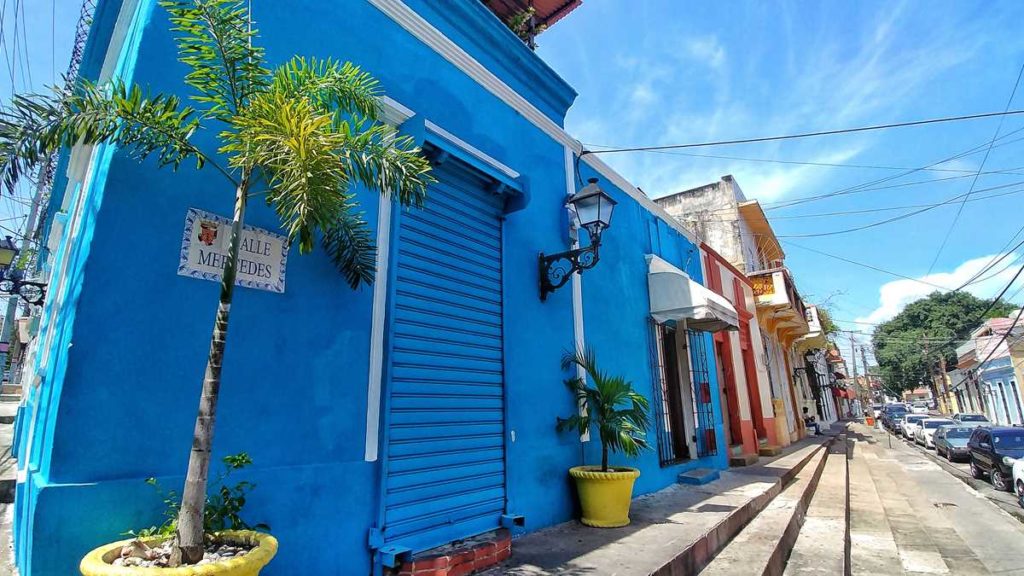
2) Famous sights and historical buildings in the Colonial Zone
The Colonial Zone in Santo Domingo is home to the highest concentration of historical sights and attractions in the entire Caribbean, especially considering that all of the following sights are within walking distance of 15 minutes. When you are around, make sure to have a closer look at the following things-to-see in the Zona Colonial:
- Alcázar de Colón (or “Casa Colón” or the “House of Columbus”), the first castle residence in the Americas, which nowadays features one of the most popular museums in Santo Domingo
- Altar of the Nation at Parque Independencia, where you can see the tombs of the founding fathers of the Dominican Republic
- Basilica Cathedral of Santa María la Menor, the most important religious building in Santo Domingo and the First Cathedral of the Americas
- Calle Las Damas , a historic cobblestone road and the oldest street of the Americas
- Church and Convent of the Dominican Order next to Parque Duarte, the oldest church in the New World
- Fortaleza Ozama with views on the Ozama River, the oldest fortress in America
- Monasterio de San Francisco , original burial place of Alonso de Ojeda and Bartholomew Columbus
- Museo de las Casas Reales , a very beautiful building and extensive museum on the colonial history of the Dominican Republic (and Haiti)
- Parque Colón , the Columbus Park with the Columbus statue
- Plaza de España , with magnificent views on the surrounding colonial buildings and the Alcázar de Colón
Most of the attractions in the Ciudad Colonial are open again after the Covid-19 pandemic. Particularly the famous cathedral “Basilica of Santa Maria la Menor” and other open-air attractions of the colonial district, such as Parque Colón, Plaza España, Monasterio de San Francisco or the pedestrian zone Calle Conde can be visited without problems.
If you are looking for more tourist attractions, check out this comprehensive list of the most amazing things-to-do in Santo Domingo .
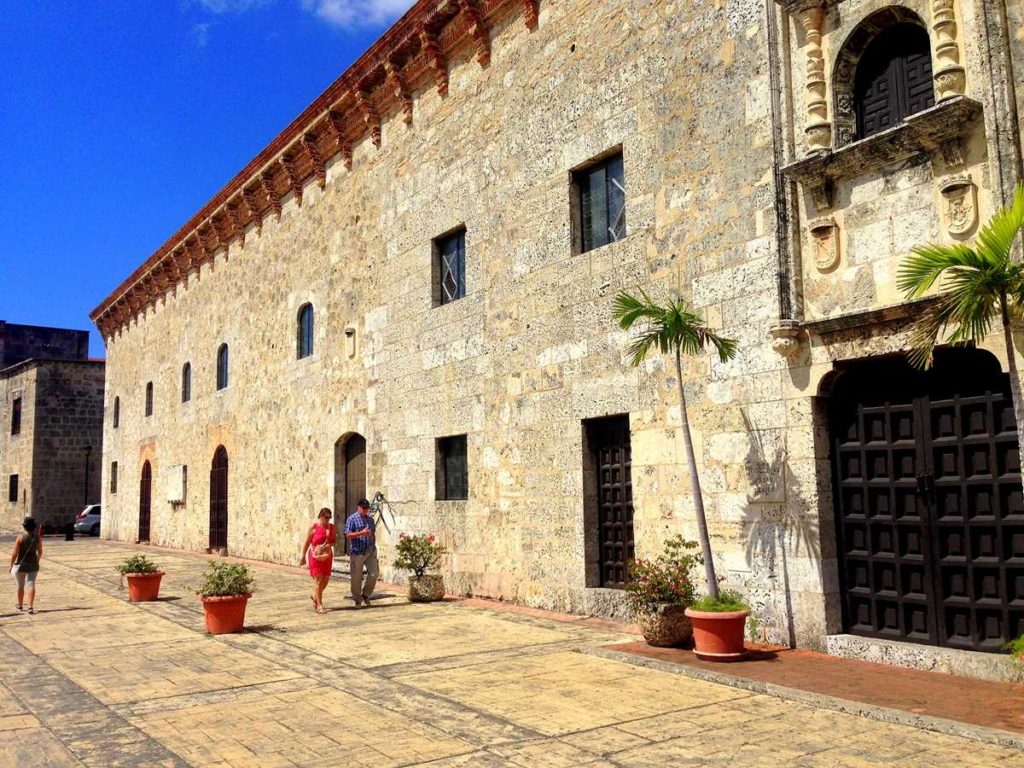
3) Plenty of alternative guided tours for more entertainment
If you don’t want to explore all of these on your own and instead are looking for someone who can show you the hidden treasures of the Ciudad Colonial, a guided tour through the Colonial Zone of Santo Domingo might come in handy. Professional guides can enrich your experience with historical information, interesting information, their own experiences and compelling stories. Furthermore, they can show you their very own insider tips and make your experience in the Zona Colonial a long-lasting and entertaining one.
The cool thing is that there are not only typical and boring guided tours. There are some special interest excursions through the Colonial Zone such as slavery tours or chocolate tours, but also bicycle tours and family-friendly guides are more fun than a typical walking tour. Check out the options in the following widget for your special experience in the Zona Colonial.
4) Join a free walking tour in Santo Domingo
If none of the tours above fit your needs (and especially when traveling on a budget to Santo Domingo ), you can also join a Free Walking Tour in the Colonial Zone of Santo Domingo. While I have not experienced the Santo Domingo version yet, I have joined many Free Walking Tours worldwide. Those have been – with very few exceptions – always a pleasure, particularly as the guides tend to be very energetic and entertaining.
In case you don’t know the principle of Free Walking Tours: independent guides offer walking tours in their hometown and get rewarded with tips by the participants. The tip is totally flexible and depending on how you have liked the tour, you can adjust the amount of your tip.
Free Walking Tours in Santo Domingo’s Zona Colonial start every day (except for Mondays) but to make scheduling for the guides easier, a previous registration ( book your spot at the Free Walking Tour here *) is necessary.
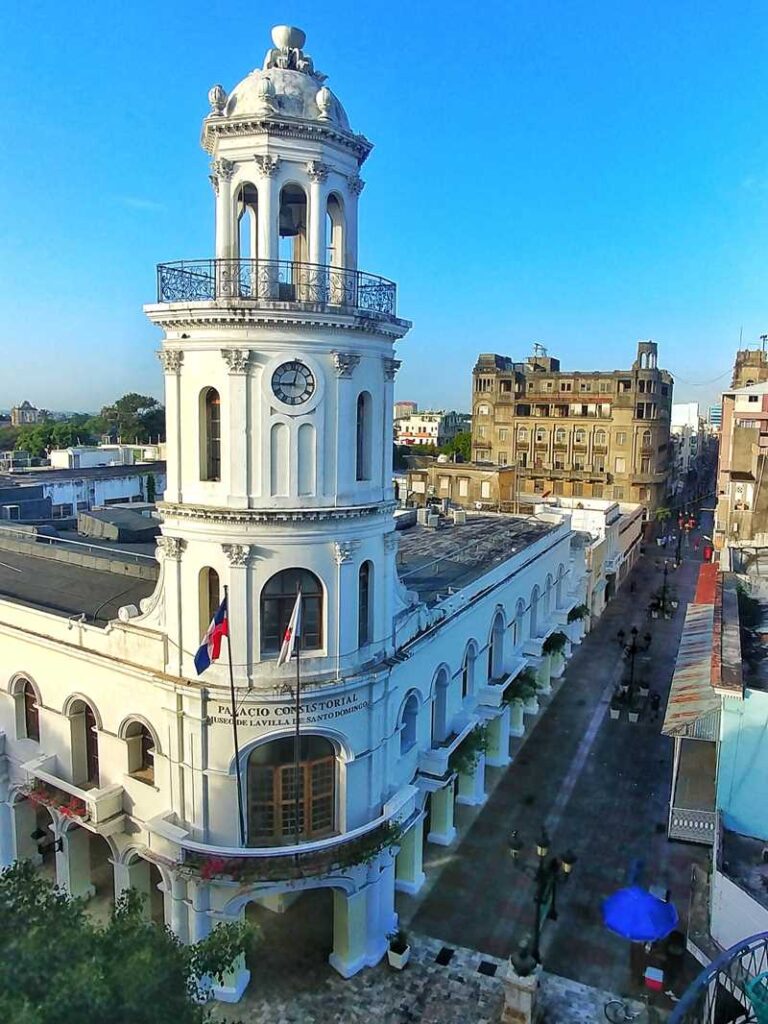
5) Small cafés and individual restaurants all over
When strolling around and exploring the ancient secrets the Colonial Zone has to offer, you might get hungry or require a break. Nothing better than that! The historic city of Santo Domingo offers dozens of cute little cafés, breezy open-air terraces, delicious hidden holes-in-the-wall and elegant fine-dining restaurants. Especially the abundance of casual eateries and cafés makes it a pleasure to stop by and rest a bit. Furthermore, it allows you to stay hydrated and explore the Zona Colonial also from its culinary side. Some of my favorite eateries, coffee shops and local restaurants in the Zona Colonial are the following. You shouldn’t miss them when visiting the colonial district in Santo Domingo 2023:
- Mix Empanadas: best empanadas in town (now with a new prominent location at Calle Conde)
- La Azotea Colonial: good and cheap wine with tapas in a casual atmosphere
- Corner Café: romantic café behind a historic church
- La Moricette: best sandwiches and pastry Falafel: cozy restaurant with Libanese focussed food (see picture below)
- EatWise at La Espiral: healthy food options in an alternative setting Omeroliza D’ Comer: my favorite Comedor (local lunch restaurant) in the Colonial Zone
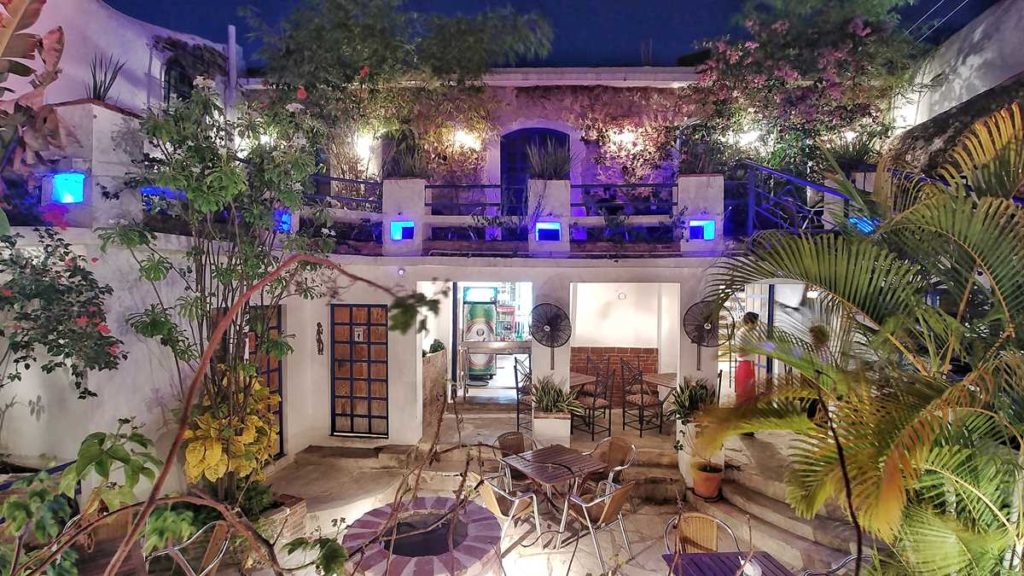
6) Dominicans love their Zona Colonial
Though it has its touristy share, the Zona Colonial is still a lively spot for the Dominicans which means you can get a good dose of daily Dominican life. When I first moved to Santo Domingo I initially did not want to live in the Colonial Zone as I thought it was way too touristy. But I was completely wrong!
When Dominicans are meeting up, they often head towards the Zona Colonial, the majority of houses here are still inhabited by locals and during the weekend you can’t count the hundreds of Dominican families who are visiting the area to enjoy some free time.
Although the Zona Colonial might not be an authentic Dominican barrio, it still is a place mainly influenced by locals and therefore one of the best places to be and to live in Santo Domingo.
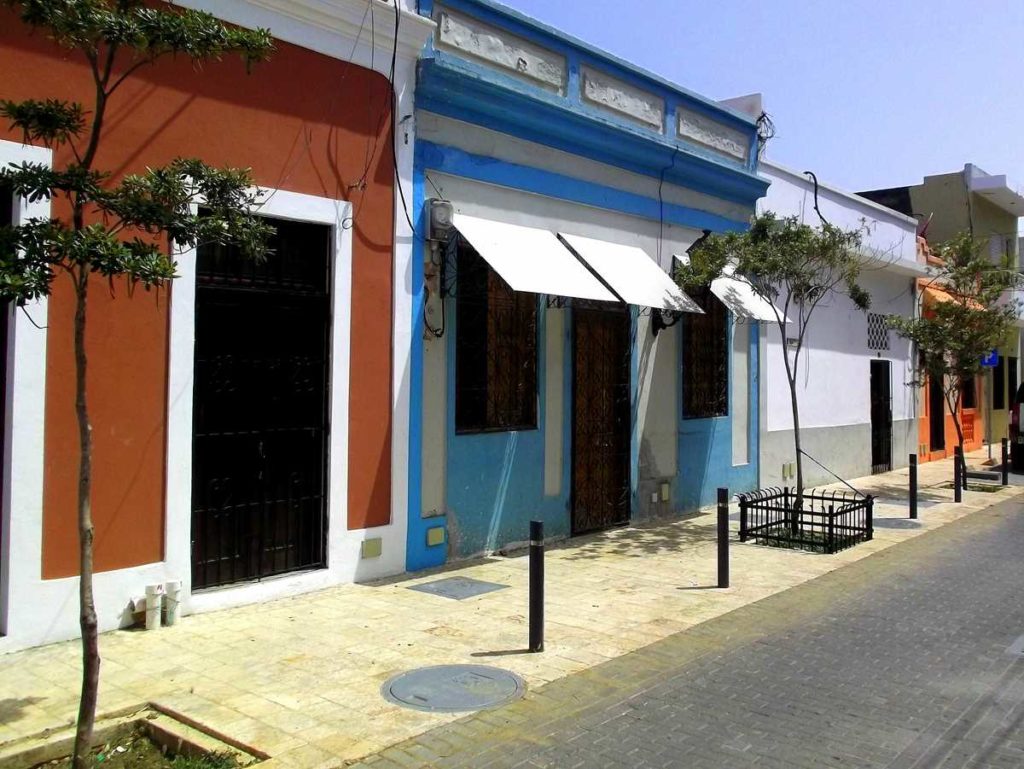
7) Sit back, relax and watch what’s happening!
People-watching is one of the most interesting things to do in the Zona Colonial if you want to relax for half an hour or more during your discovery tour of the area. First of all, because there are tons of options to sit down for a while, either in the several public parks (Parque Duarte, Parque Colón, etc.) with its benches or in the aforementioned cafés and terraces where you have a great view of the daily life. Second, you can see so many amazing things when observing daily life for a bit: Dominican families on their weekend getaway, artists giving creative performances, all kind of tourists wandering around, young locals on their shopping trips, multi-cultural couples having their daily drink, expats coming home from work and so much more …
If you sit down for an hour and watch the life happening you probably see a very good profile of the variety of the Zona Colonial and its people.
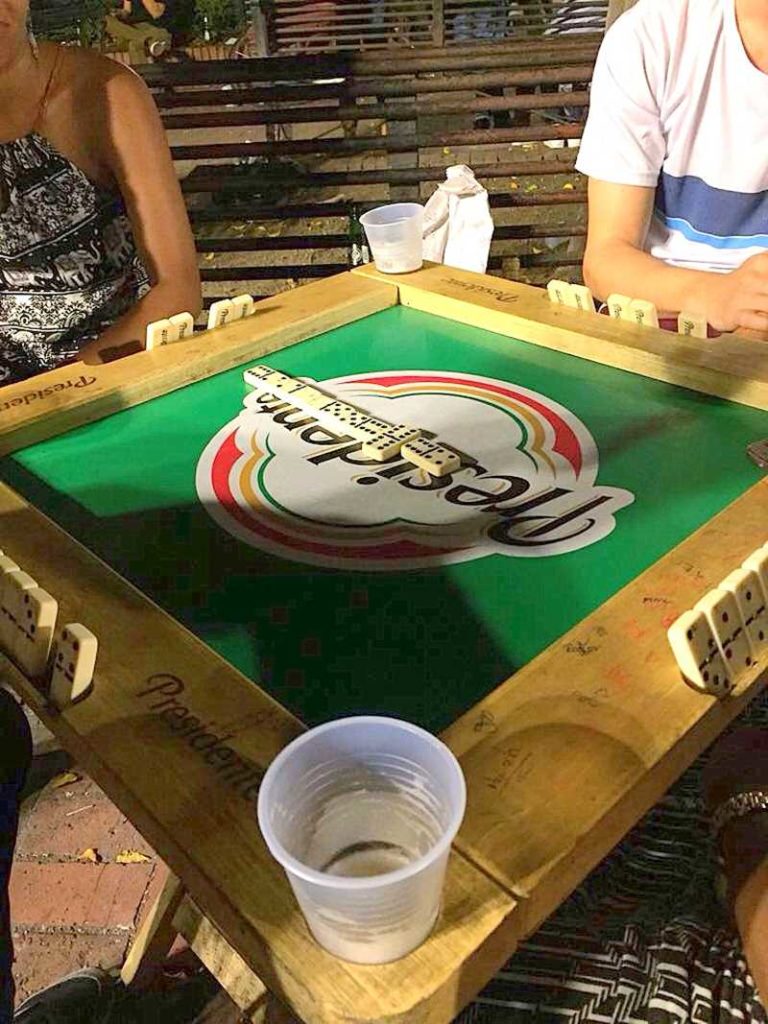
8) Vibrant nightlife in the Zona Colonial
As mentioned, Dominicans love to go out to the Zona Colonial, which is why it has vibrant nightlife. Especially from Thursday to Sunday you will see the several parks populated by hundreds of locals, sipping on their beer or rum and chatting with their friends or simply strangers. Alternatively, you can visit one of the multiple bars for delicious cocktails – usually rum-based, if you stick to the original Dominican ingredients. Afterwards, clubs and dancing bars are opening for everyone to dance the night away to Merengue, Salsa and Bachata. The Dominicans are crazy about music and dancing. They are happy to show you some steps and moves as well, especially as the nightlife here in the Zona Colonial is quite relaxed and low-key, compared to other locations in Santo Domingo.
Of course, right now during the Coronavirus pandemic, nightlife options are mostly non-existent, especially as a nightly curfew is existing since March 2020 . However, you can be sure that the nightlife in the Zona Colonial of Santo Domingo will be back to normal as soon as the clubs and restaurants are allowed to open again.
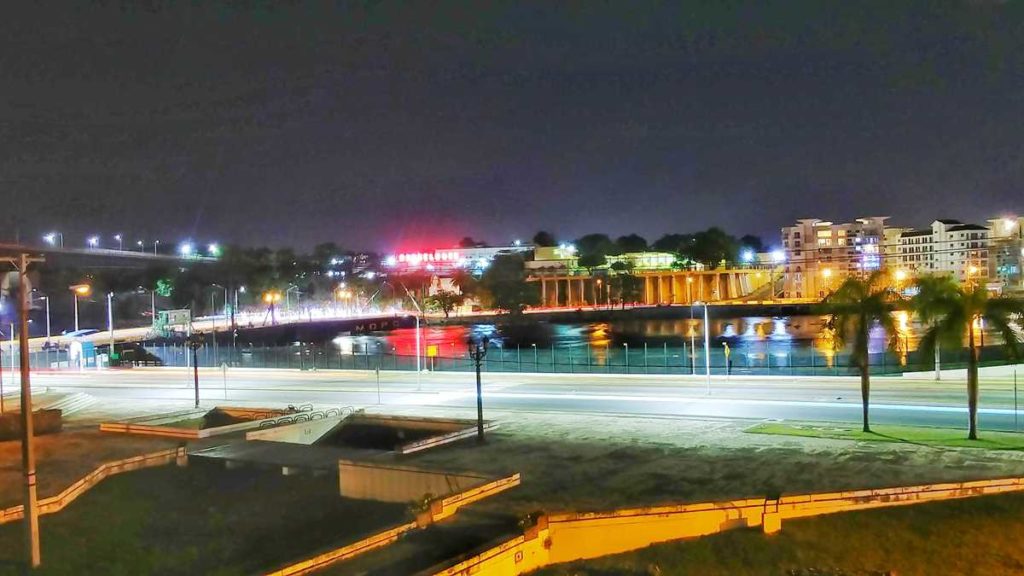
9) Bonye, the biggest party of Santo Domingo
However, there is one dancing respectively nightlife event which earns its separate reference here in this article about the reasons why to visit Santo Domingos Zona Colonial: Bonye. This is the name of an extremely popular and long-standing Dominican band that is performing every Sunday evening in an amazing historical setting next to the ruins of San Francisco.
Get your free e-book now – “17 amazing things-to-do for free in Punta Cana”!
More Info >>

While just the location is worth a visit, the Bonye band guarantees that every event is a big street party for everyone. When you get there, you will see hundreds of Dominicans and tourists alike dancing to the typical Bachata, Merengue and Salsa music, while the bars and colmados next door are open to sell drinks and snacks. The event is for free, an unparalleled highlight and a must-see when visiting Santo Domingo .
Now, as of May 2023, Bonye is running again for more than a year after the Covid-19 pandemic in the Dominican Republic officially ended.
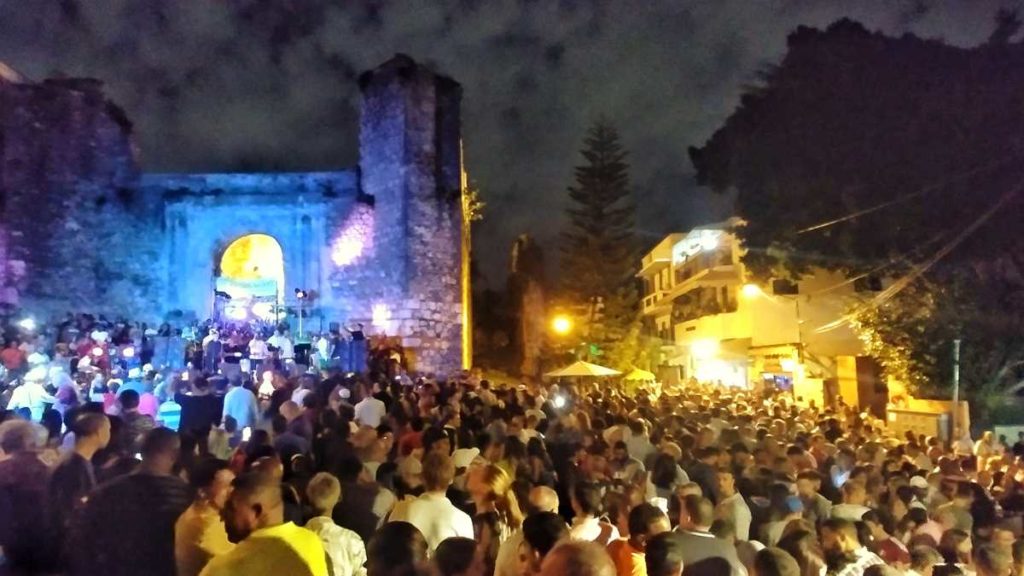
10) Photo opportunities in the Colonial Zone
If you are a photographer, the Zona Colonial will be your heaven, thanks to the historic buildings, the little alleyways and especially the abundant colors. Not only can you take photos of the popular sights, but also of hidden spots, creatively painted buildings and ancient streets. There are also dozens if not hundreds historic and picturesque courtyards to discover. For a serious photographer, it might take several days to explore all the secrets the Zona Colonial has to offer.
When you visit the colonial district of Santo Domingo and are looking for photo opportunities, the streets Calle Las Damas, Calle Padre Billini, Calle Isabel La Católica and Calle Arzobispo Meriño offer the highest density of beautiful buildings and colorful houses. To explore some little hidden treasures and further photo opportunities, you can also check out the very short alleys Callejón Parmenio Troncoso, Callejón Macoris or Callejón de los Curas.
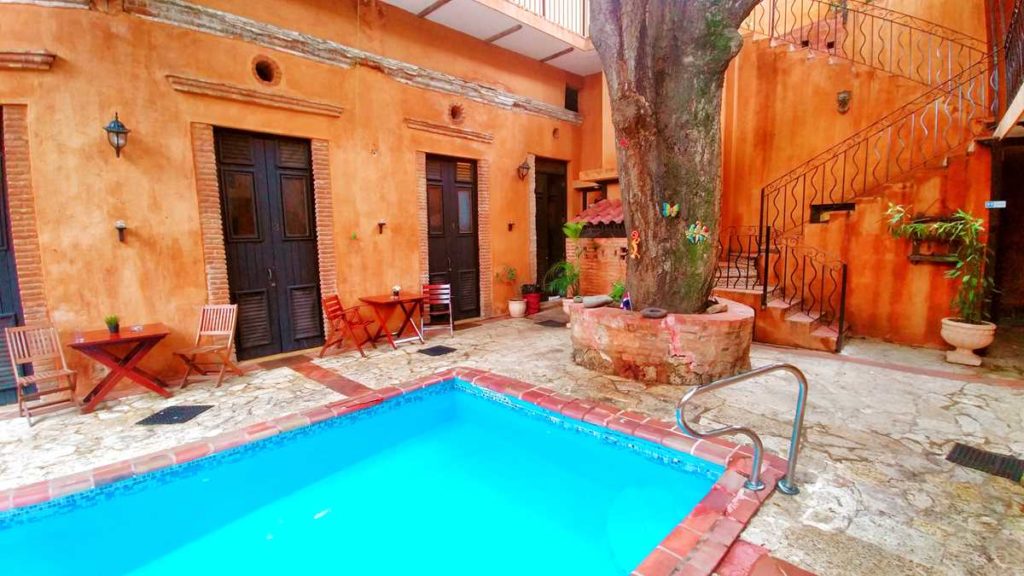
11) The best museums in the Dominican Republic
Especially on a rainy day (which rarely happens in the Dominican Republic – check the weather for each month here), museums are a great way to spend your day, particularly as the museums in the Colonial Zone are top-notch and some of the best in the entire Dominican Republic. There are various museums for different kinds of interests with the Ambar Museum, the Resistance Museum and the Museo de las Casas Reales being the most famous ones.
Here are some of the museums in the Zona Colonial that you should consider visiting:
Museo de las Casas Reales (Museum of the Royal Houses): Prepare to step back in time as you explore this magnificent museum housed in a restored colonial palace. Discover the rich history of the Dominican Republic, from the days of Spanish colonization to the present, through captivating artifacts, artwork, and interactive displays.
Museo Alcázar de Colón (Alcázar de Colón Museum): Venture into the former residence of Diego Columbus, the son of Christopher Columbus, and his wife Maria de Toledo. This splendid palace-turned-museum in the Zona Colonial showcases luxurious furniture, exquisite artwork, and period decorations, immersing you in the opulent lifestyle of the early Spanish colonial elite.
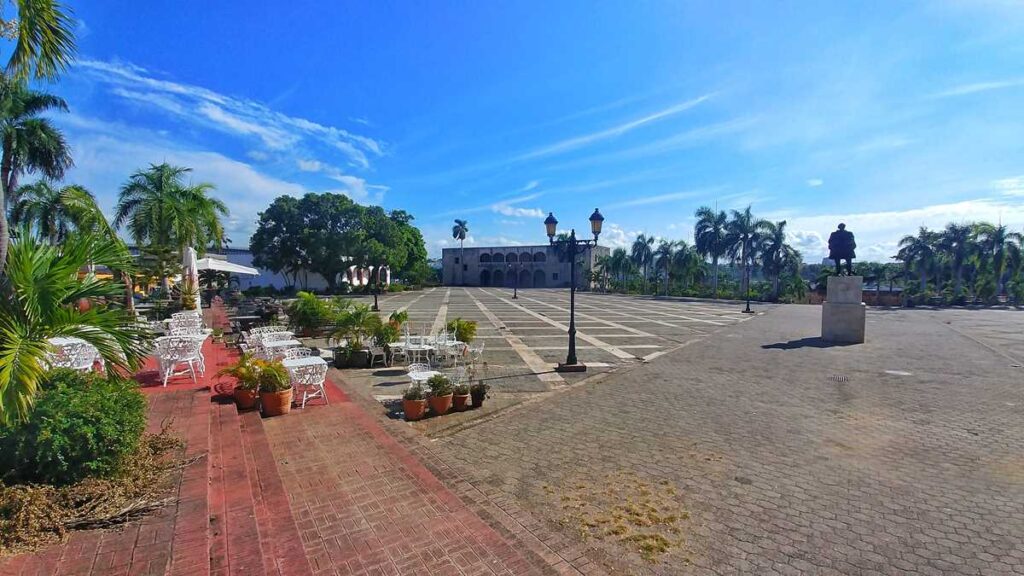
Museo del Ron y la Caña (Rum and Sugarcane Museum): Indulge your senses in this aromatic museum dedicated to the beloved Dominican rum and its sugarcane origins. Learn about the rum-making process, from harvesting the sweet cane to the final distillation.
Museo de las Telecomunicaciones (Museum of Telecommunications): Discover how the Dominican Republic embraced modern technology through this fascinating museum. Explore the evolution of communication, from telegraphs to smartphones, and marvel at vintage equipment, historical photographs, and interactive displays that illustrate the country’s connectivity journey. This is definitely an interesting museum for a rainy day in the Colonial Zone.
Museo de la Resistencia Dominicana (Museum of Dominican Resistance): Step into the era of the Trujillo dictatorship and the struggle for freedom in this thought-provoking museum in Santo Domingo . Uncover the stories of resistance fighters, view powerful photographs, and engage with immersive exhibits that shed light on the country’s fight for democracy.
Museo de la Moneda (Museum of the Currency): Journey into the fascinating world of money and numismatics at this unique museum in the Zona Colonial. Admire ancient coins, rare banknotes, and historical artifacts that offer insights into the country’s monetary history. Engage with interactive exhibits that allow you to create your own currency designs.
Museo del Ámbar Dominicano (Dominican Amber Museum): Embark on a prehistoric adventure as you explore the captivating world of amber, fossilized tree resin, at this museum. Marvel at mesmerizing amber specimens, including ancient insects trapped in time, and learn about the amber extraction process and its cultural significance in the Dominican Republic.
There are even more museums in the Colonial Zone, such as the Museo de la Catedral Primada de América (Museum of the Primatial Cathedral of America), Museo de la Porcelana (Porcelain Museum) or the Museo de la Familia Dominicana (Museum of the Dominican Family).
12) The Zona Colonial is perfectly safe
Safety sometimes is an issue when talking about the Dominican Republic (mostly unjustified due to a lack of knowledge or experience). While Santo Domingo indeed has some crime issues, the Zona Colonial is perfectly safe, as long as you keep your eyes open and are not moving around carelessly. There is a high presence of police (ordinary and tourist police), the streets are always busy and there are even surveillance cameras in the area. You can walk around without worries, can ask any person for advice if in doubt and you can even enjoy the nightlife without problems as long as it doesn’t get too late (after midnight you should take a taxi everywhere) or you are getting too drunk (and therefore vulnerable).
If you are still worried, check out the section “which things not to do” in this Santo Domingo article . There is also plenty of information about safety in Santo Domingo and the Dominican Republic and this article about if it is safe to travel to Punta Cana .
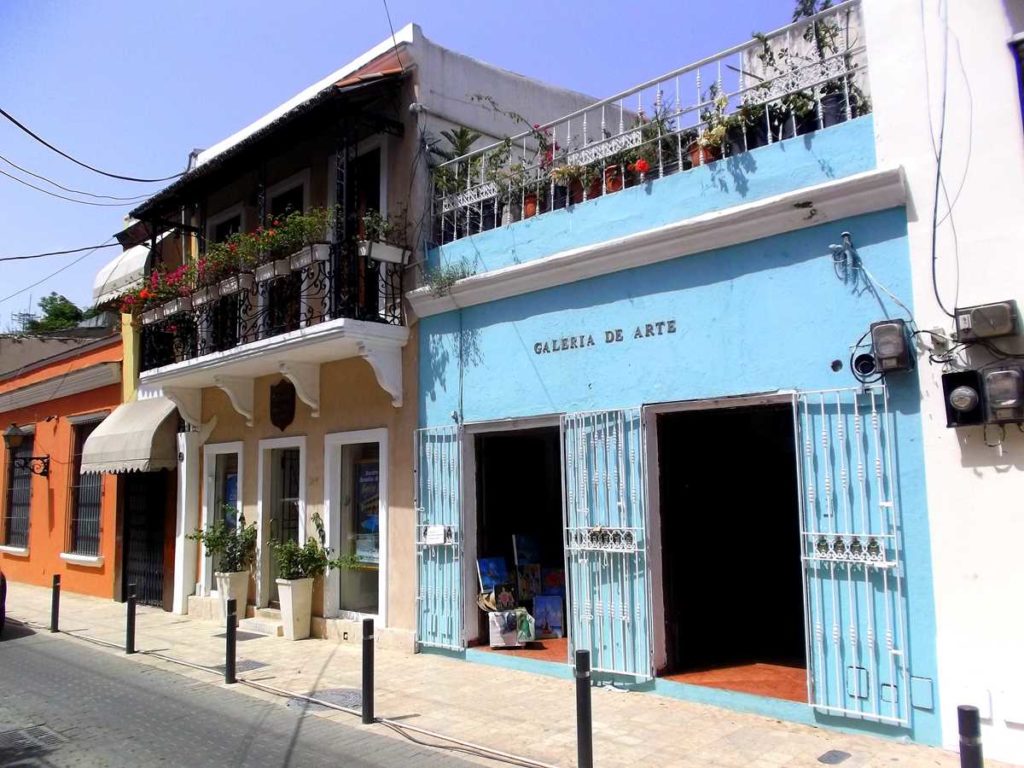
If you are not only coming for a day trip from Punta Cana to Santo Domingo but are planning several days (or even a full road-trip through the Dominican Republic ), the city will be your perfect starting point to venture out to the country. Due to the logistical structure of the Dominican Republic (busses, highways, etc.) and the geographical location you can reach nearly all interesting regions (Southwest, mountains, North Coast, Samaná ) from Santo Domingo in around 2-4 hours – it doesn’t matter if you are planning to travel by bus or by Punta Cana car rental . Therefore Santo Domingo marks a great starting point if you are planning to see more from the Dominican Republic than just Punta Cana.
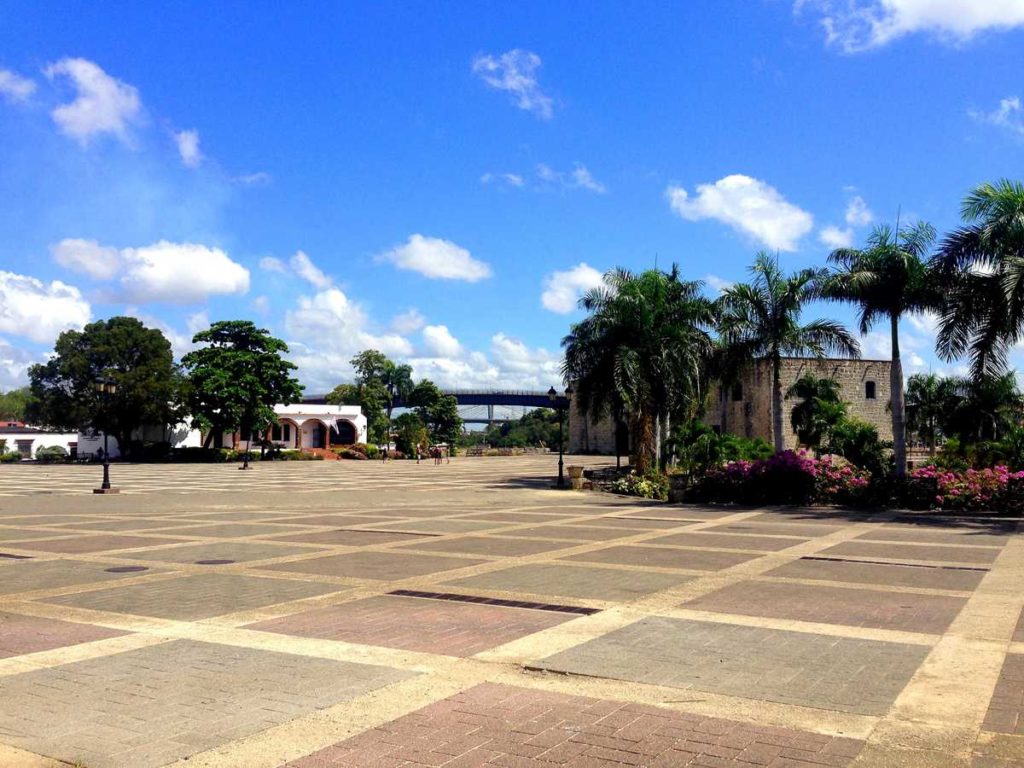
The ideal option is to spend 2-3 nights in Santo Domingo’s Zona Colonial first (1-2 full days are perfect) and afterwards start your road-trip in the Dominican Republic .
Frequently asked questions
How to book an organized excursion from punta cana to the colonial zone in santo domingo.
If you are on an all-inclusive vacation in Punta Cana (or Bayahibe , La Romana, Uvero Alto, Bavaro, etc.) and just would like to visit Santo Domingo for a day , the easiest option is to book a guided excursion. Most of the tours in Punta Cana are starting quite early in the morning to allow you sufficient time in Santo Domingo as you will spend at least 6 hours on the bus on the way from and to Punta Cana (approximately 3 hours each way). After arriving in the Colonial Zone, you will have a guided tour with a lot of the sights mentioned above, incl. entrances to some of them, depending on the tour finally booked.
In the afternoon, you have either a tour by bus to other sights of the city or some free time to explore some of the highlights I described above before heading back to Punta Cana. It is definitely a must-do excursion for all those who are interested in the history of Santo Domingo and the culture of the Dominican Republic. You can check out some recommendable offers here. Even private tours can be pretty affordable * especially when traveling in a party of more than 2 people, so make sure to have a look at this option as well.
How to get to Santo Domingo from Punta Cana (on your own)?
If you would like to visit Santo Domingo from Punta Cana on your own I would recommend you at least two days. This gives you more time to enjoy the unique atmosphere of the Colonial Zone and stretches the travel time to two different days. Furthermore, you’ll also have the chance to experience Santo Domingo s great dining and vibrant nightlife. Particularly the Bonyé event is spectacular and unique, hence if you can, plan your trip to Santo Domingo on a Sunday (even though some of the museums in the Colonial Zone are closed on Sundays).
To get from Punta Cana to Santo Domingo , you have three options:
1) Private Transfer: If you would like to have it relaxed and with peace of mind, you can book a private transfer. Prices for a door-to-door transfer (from your resort in Punta Cana to your hotel in Santo Domingo (see further below for accommodation recommendations in the Ciudad Colonial) should range between 150 and 180 USD one-way incl. taxes and fees. If interested, you can book those transfers with the following links:
2) Rental Car: In case you are planning multiple excursions on your own anyway, you should consider renting a car . Driving in the Dominican Republic might sometimes be a bit chaotic but is doable. However, please note that traffic in Santo Domingo is a little crazy so it is best to leave the car in the garage once you have arrived in Santo Domingo. You can check out attractive rental car prices here *. If driving with your own car, you need around 2.5 hours between both cities (avoiding rush hour). If you are a newbie in the Dominican Republic or have never driven in other countries, it is not recommendable to head to Santo Domingo by rental car.
3) Bus: Quite often I see people taking the bus from Bavaro/Punta Cana to Santo Domingo (which I do as well). As there is a direct express service 7 times a day between both cities (see departure times for the Punta Cana – Santo Domingo bus here), it is quite easy. On top, the journey is very comfortable as the buses are new and modern. The journey costs around 8 USD per way (450 Dominican Pesos as of May 2023). Depending on your mobility you might need taxis or motoconchos to get to and from the bus station.
You can find all the information about traveling between Santo Domingo and Punta Cana in this article , incl. bus departure times and further options for your journey – also depending on where your accommodation is located.
TRAVEL COACHING
Do you need help planning a customized vacation in Punta Cana and the Dominican Republic? Is it difficult for you to decide what and where to book? Would you like to take advantage of someone with years of experience in the tourism industry (knowing all the travel hacks 😉 ) and living right in the place where you would like to spend your holiday? That’s what my personal travel coaching is for. I will design your tailor-made itinerary, tell you how to save money on your trip and send you the best insider tips and recommendations. All the information I send you are crafted with love and passion – and are coming with a money-back guarantee. Let me know how I can help you ( check my packages here ) and send me a request here !

How to get to Santo Domingo from elsewhere?
In case you are not vacationing in Punta Cana, you can put Santo Domingo as your first travel destination in the Dominican Republic. It is very suitable to be your first stop, as there are a lot of flights from various cities in the United States to Santo Domingo *, among them Atlanta, Miami, Fort Lauderdale, New York, Boston, Philadelphia, Charlotte and Orlando. If you’re coming from Canada or the UK, it’s usually easier to fly to Punta Cana and take one of the transport options mentioned in the previous point.
In case you are already in the Dominican Republic, just take a bus to Santo Domingo. There are direct busses from nearly every corner of the country to the capital.
Where to stay in Santo Domingo?
If you are deciding for the two-day-option (or longer) I absolutely recommend you to stay within the limits of the Zona Colonial. One reason is for safety, but the main reason is that with your accommodation being in the Zona Colonial, everything is within walking distance. Furthermore, there are dozens of hotels in old colonial buildings and with a unique historic charm. If you pick a good hotel, your accommodation might already be an attraction for itself where you can feel the atmosphere of 300 years ago.
If you’re looking for some highly recommendable hotels within the Zona Colonial in Santo Domingo, the following options are some of the best options:
- Casa Naemie ($$ – check prices *): one of the best budget places to stay in the Colonial Zone in a typical colonial house with intertwined hallways and different patios
- Colonial 154 H Boutique ($$$ – check prices *): a stylish but affordable boutique hotel with the full charm of colonial accommodation
- Casa Sanchez ($$$$ – check prices *): colonial architecture meets contemporary design. This comfortable hotel combines history and modern times Billini Hotel ($$$$$ – check prices *): using structures and walls from the 17th century and being located right next to a 300+ years old church, you can’t be closer to the feeling of living back in these old times
Alternatively, an Airbnb in Santo Domingo is also a great option to give your city trip a personal touch, especially as there are a lot of unique places to stay in Santo Domingo and the colonial district. Check out a comprehensive list of the 27 best and most spectacular Airbnbs in Santo Domingo here .
Is it safe to visit Santo Domingo?
As described above, it is absolutely safe to visit the Zona Colonial of Santo Domingo. Also, the way from the bus station or when arriving by car is no problem. In case you’d like to explore further parts of Santo Domingo please ask a local for advice or send me an email on where to go and not to go.
– Most Popular Posts on Punta Cana Travel Blog –
Coco Bongo Punta Cana – Ticket Options, our review and if it is worth to visit

Helpful Overview & Experiences: all-inclusive ADULTS-ONLY resorts in Punta Cana
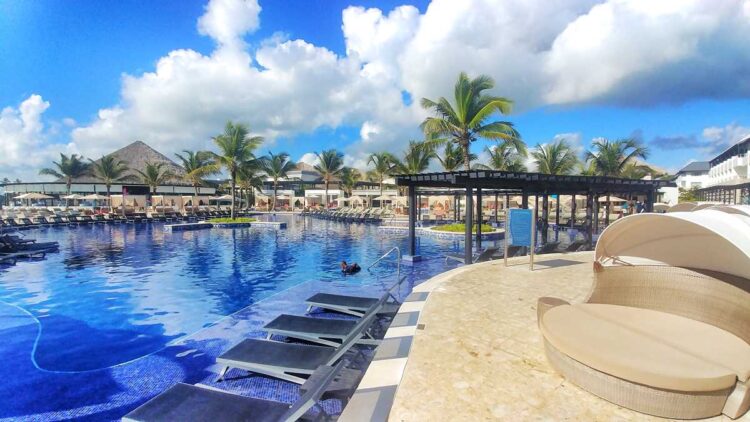
13 Insider tips on how to find the best all-inclusive resort in Punta Cana
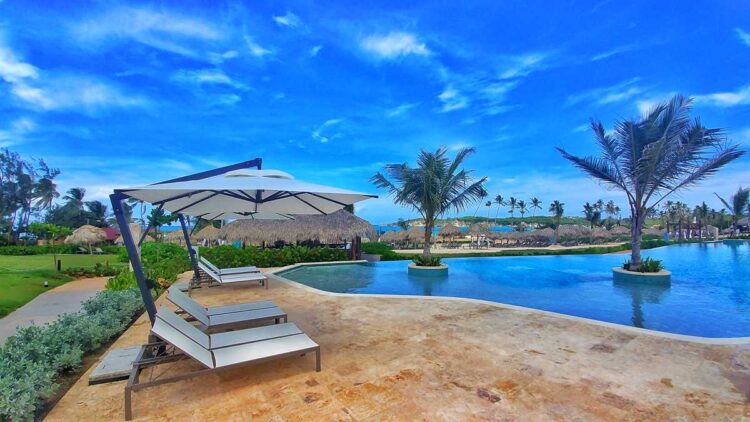
Excursion to Isla Saona 2024 – hidden gems, insider tips, DIY adventures and the best Saona Island tours
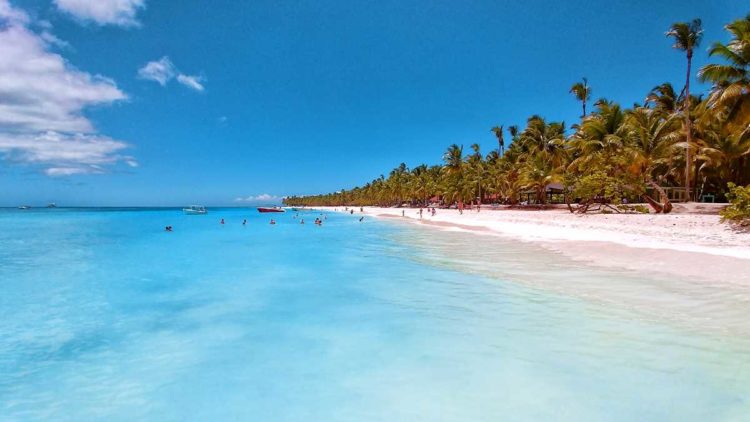
As mentioned above, there are plenty of things-to-do to explore on your own, such as the various historical attractions, the ancient cobblestone streets or the several cafés, bars and art shops. My top 3 when it comes to visiting the colonial district is to have a look at Plaza España, explore the ancient streets (especially Calle Las Damas, Calle Padre Billini, Calle Isabel La Católica and Calle Arzobispo Meriño) and have a coffee or a beer at Parque Colón or Parque Duarte to enjoy people-watching.
If you’d like to explore the Colonial Zone in Santo Domingo the more entertaining way, you can also book a guided bicycle tour, take part in a chocolate workshop, visit the 4D-cinema to see a movie about the history of the city or join an interactive tour through the history of rum in the Dominican Republic. Have a look at some of the following options:
Alternatives to Santo Domingo and the Zona Colonial
Honestly, the Zona Colonial is top-notch if it comes to history, nightlife, culture and sightseeing, so there aren’t any equivalent alternatives to this area. Within Santo Domingo, the Zona Colonial is by far the most interesting part.
If you are looking for alternative historic buildings and a colonial old town, Puerto Plata on the north coast of the Dominican Republic is another option , but not as spectacular as the Colonial Zone in Santo Domingo.
In terms of nightlife, Piantini in Santo Domingo is another hotspot for the night, especially for posh and elegant bars and clubs. Outside of Santo Domingo, Cabarete on the North Coast has some decent nightlife, especially on the beach. If you don’t want to venture out from Punta Cana, the center of Bavaro does have a few nightlife options.
However, due to the unique characteristic of Santo Domingos Zona Colonial, there is hardly any full alternative and it is absolutely worth the trip, especially if you stay overnight and spend at least 2 or 3 days in the city.
If you don’t want to overnight in Santo Domingo but feel that the city is too far for a day trip, you can check out other day trip ideas from Punta Cana here .
SHARING IS CARING! IF YOU ENJOYED THIS ARTICLE, PLEASE SHARE WITH YOUR FRIENDS – I WOULD APPRECIATE IT A LOT.
Hey, I am Chris, a born and raised German, travel-addictive and Caribbean Soul. Since 2011 I have been living in the Caribbean, among them 5 years in the Dominican Republic. Punta Cana is my home-base here in the country and I’d love to tell you more about how to experience Punta Cana off-the-beaten-track and give you all the advice you want to know for your vacation in Punta Cana.
ALSO WORTH READING:
30+ exciting things-to-do in Punta Cana in 2023 (Dominican Republic)
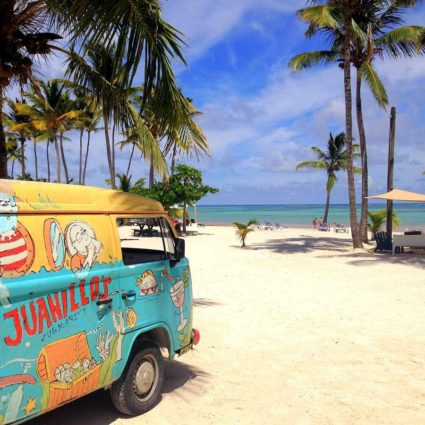
The 13 best day trips from Punta Cana
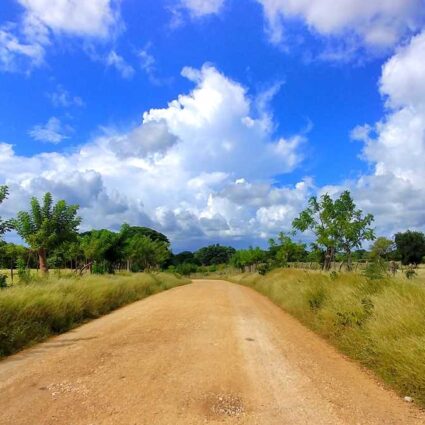
Catalonia Punta Cana – a comprehensive review of this all-inclusive resort
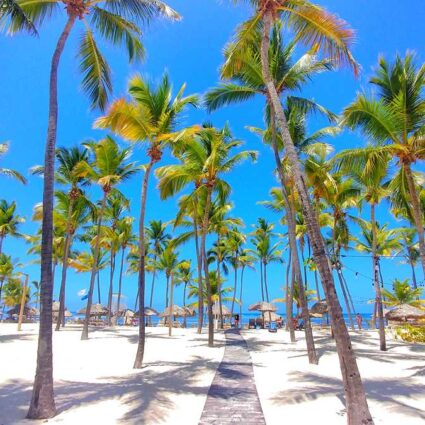
Hoyo Claro – how you can save 496 USD when visiting a cenote in Punta Cana
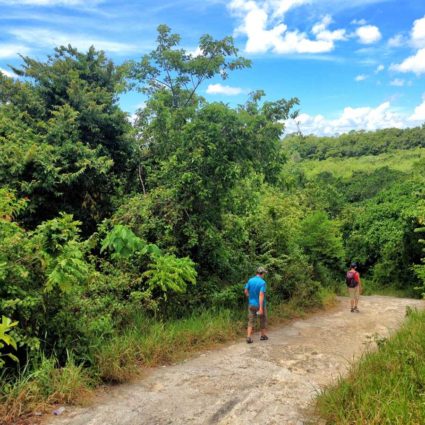
2 thoughts on “13 reasons why you should visit the Zona Colonial of Santo Domingo”
Hi, could you tell me where not to go in the colonial zone?
Hi Ashley, the Colonial Zone is pretty safe everywhere. You might want to avoid the most southern and western streets (Espaillat, Palo Hincado … ) too late at night (lets say after 11pm), but even those ones are usually ok. If you have any specific concern, please let me know. Cheers, Chris
Leave a Comment Cancel Reply
Your email address will not be published. Required fields are marked *
Save my name, email, and website in this browser for the next time I comment.
I want the free e-book "15 amazing things-to-do for free in Punta Cana"!
Diving Deep Into Culture

Colonial Santo Domingo’s Best Walking Tour
If you are based in Santo Domingo’s Zona Colonial during your stay in the Dominican Republic, it is easy to explore the historical treasures of the first colonial city in the new world. Only eleven square blocks, it’s feasible to see all of the old town’s highlights in one full day.
As a seven-month pregnant lady with swollen feet, I had to break up the itinerary into two days. However you decide to do it, there are definitely certain stops that warrant a longer visit, whereas others can be skimmed over or skipped completely (in my opinion).
Table of Contents
A few recommendations to start:
1) Wear walking/athletic shoes! I made the mistake of wearing sandals with no arch support or cushion, and I swear my feet almost exploded.
2) Bring plenty of water or plan on buying some in one of the little snack stands along the way. Most places will accept USD (a little less than $1.00 for a bottle).
3) It’s likely going to be HOT… It was very humid and warm in April, so depending on what time of year you’re there, you may want a small towel to mitigate the perspiration. Seriously.
4) Wear sunscreen! Otherwise, you will get sunburned. I had it on my face, but not on other parts, which got singed.
5) The guidebooks and signage will warn you that short pants (shorts) and tank tops (and sometimes flip flops) are prohibited in churches and cathedrals. Reading about this, I prepared by wearing a flowy strapless, long dress. I also brought a white linen shirt to cover my shoulders. Fellas, you may be stuck wearing pants, although long shorts (past your knees) may work?
I noticed that a good many tourists were in shorts and tank tops and didn’t seem to be turned away form entering the places of worship. However, it’s always a good idea to show respect in another culture. You never know, you may be the one person they pick on!
6) Plan on spending a longer time at some stops than you would expect. Also plan on stops for snacking/eating, drinking and relaxing (especially if it’s really hot). Enjoy yourself, and don’t rush it!
Now, let’s go for a walk!
Borrowing Lonely Planet’s walking tour from their Dominican Republic and Haiti guidebook, you’ll notice that I started at stop 8 counting down to 1, then jumped to 13 and walked up to 21. Lastly, I hit 12 through 8 (backwards) to my hotel. It doesn’t really matter which direction you take. I started at a point close to my hotel.
I’ve noted when I thought each site was worth a Drive by (10 minutes of photo taking and reading about significance of the site), to Skip entirely or to Stay a while (about an hour, maybe longer). Most of the stops are “drive bys,” warranting a short stop and photo opp, as you will notice. There are about eight spots worth spending a little extra time, in my opinion.
Stop 1 ( Drive by) – Start in Parque Duarte, taking in the flowering bougainvillea and other blossoms sprinkled around the colonial buildings.
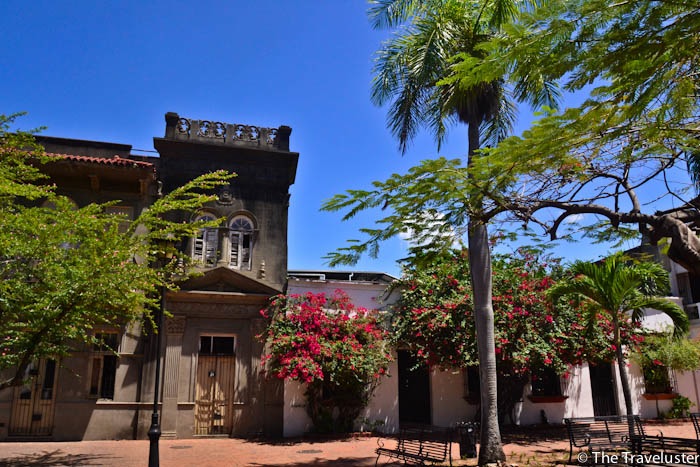
The first historic site on the walk is Capilla de la Tercera Orden Dominicana . With its beautiful baroque façade, it is the only fully intact colonial structure that remains in the city. It is the office of the archbishop of Santo Domingo and therefore not open to the public. So snap some shots and move along.

Stop 2 ( Drive by) – Charles V built the Convento de la Orden de los Predicadores in 1510. It’s the first convent of the Dominican order in the new world. Father Bartolomé chronicled the Spanish atrocities against the indigenous peoples here.
According to LP, there are interior features worth your gander, such as stone zodiac wheel carved in to the chapel’s vault depicting both mythological and astrological images. Paintings of religious figures, such as Pope Saint Pius V, adorn the walls.
When I walked by, the interior was closed for an event; school children were singing.

I skipped Centro Cultural Español in the interest of time. Casa de Teatro is worth a drive by to pop in and see the set up. You can check the schedule to see if there is a show one night while you’re in town.

Stop 3 ( Stay a while) – Museo de la Familia Dominica
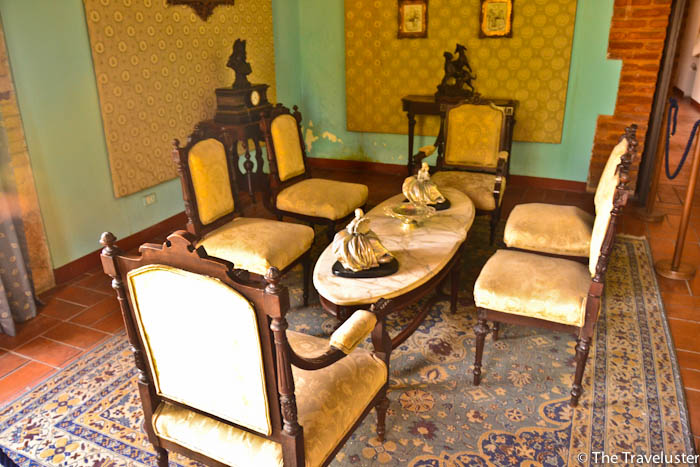
Writer Francisco Tostado’s 16th century home is worth a visit, although it was my least favorite historical museum on the walking tour. Its double Gothic window over the front door is “the only one of its kind in the Americas. ” The rooms of the home are recreated with 19th century furnishings. Tours are available in English (counter to what Lonely Planet says).

Stop 4 ( Drive by) – Another first, the Iglesia de Santa Clara was the premier nunnery in the new world, built in 1552. The church is simple and discreet (i.e. not much to look at), but it’s significance is worth a stop.

90 bottles of beer on the wall… 90 bottles of beer… take one down, pass it around…
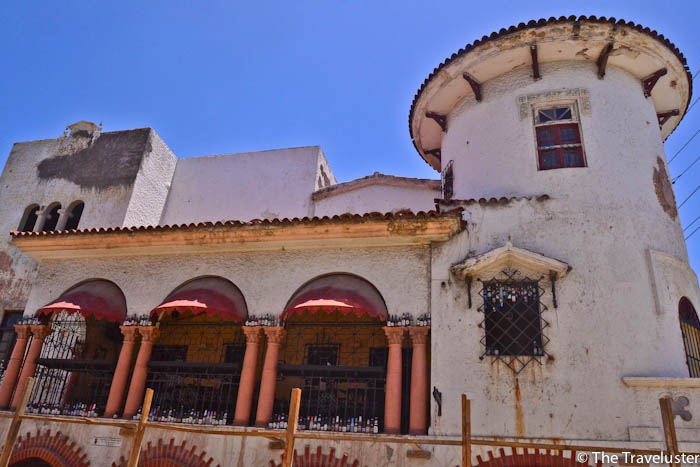
Stop 5 ( Drive by) – Larimar Museum

Notice the larimar railing at the larimar museum
Larimar is a beautiful blue, volcanic stone (when polished). I breezed through the museum quickly. If you are a mineral enthusiast, it might be worth your time. For me, it was a good air conditioning and bathroom break. The gift shop dominates the lower level, where you can buy any style of finished jewelry pieces made of the azure stone.

Larimar in the stairway railing
Stop 6 ( Stay a while ) – Catedral Primada de América

When you reach Catedral Primada de América , take a load off and enjoy the vaulted Gothic ceilings, Romanesque arches and baroque ornamentation in the comfort of blasting air condition. Since numerous architects worked on the cathedral, there are various interior structural styles.

Christopher Columbus’s son Diego lay the fist stone of the cathedral in 1514, but construction actually began in 1521 with the arrival of the first Bishop Alejandro Geraldini.

The cathedral is not technically the first one built in the new world, as one in Mexico City was constructed between 1524 and 1532, but it was knocked down in 1573 and replaced by Catedral Metropolitano. Therefore it can be said that the cathedral in Santo Domingo is the oldest functioning cathedral in the new world.
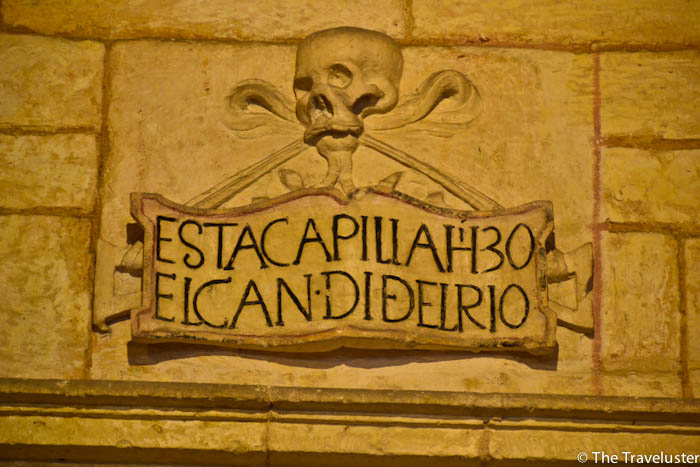
Apparently, the great pirate Drake and his crew did quite a number on the basilica back in 1586, when they used the cathedral as their headquarters during their assault on the city. They stole anything that was moveable and vandalized everything else. Most of what you see in today’s interior has since been restored.

Make sure you spend time perusing all 14 of the interior chapels. They, along with the lofty vaulted ceilings and Romanesque arches, are the most impressive features in the basilica. It’s nice to just relax in a pew with your camera, taking in the awesomeness, while allowing the frigid air to cool down your overheated extremities.
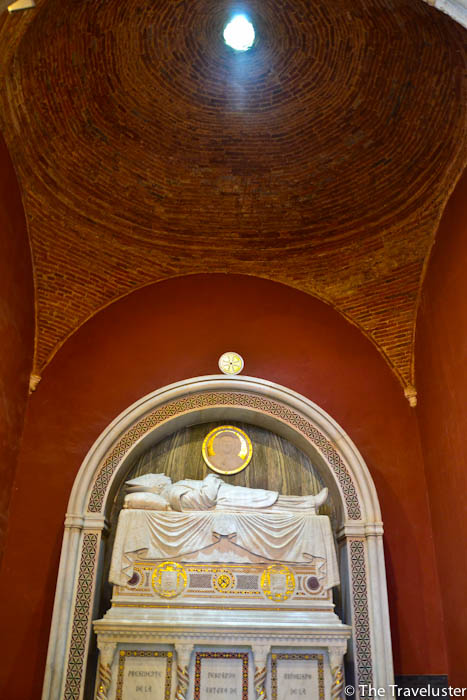
Cathedral facade as seen from Parque Cólon
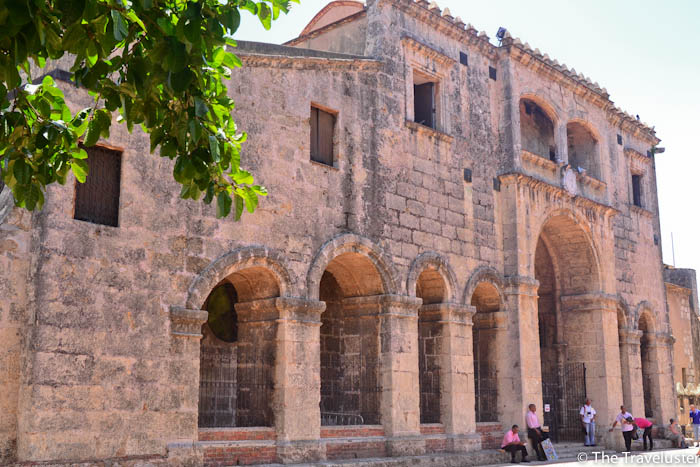
The resident artist, who always seems to be on the same bench, is out painting every day. If you need a refreshment, grab a table at one of the al fresco restaurants, like El Conde.

Parque Colon facing the cathedral

Restaurants in the park
Stop 8 – ( Stay a while) Fortaleza Ozama

Torre del Homenaje (Tower of Homage), the oldest of the buildings at the fort.
Fortaleza Ozama is the oldest military structure in the new world!!! Such things really impress me….. I loved seeing Castilo San Felipe del Morro in Old San Juan (Puerto Rico) and Fort San Lorenzo in Panama Viejo, but to see the oldest one this side of the Atlantic? That’s special.

Fray Nicolás de Ovando strategically chose the site of the fort at the confluence of Río Ozama and the Caribbean. Master builder Gómez García Varela directed the fort’s construction, which began in 1502, and continued in stages over the next two centuries.
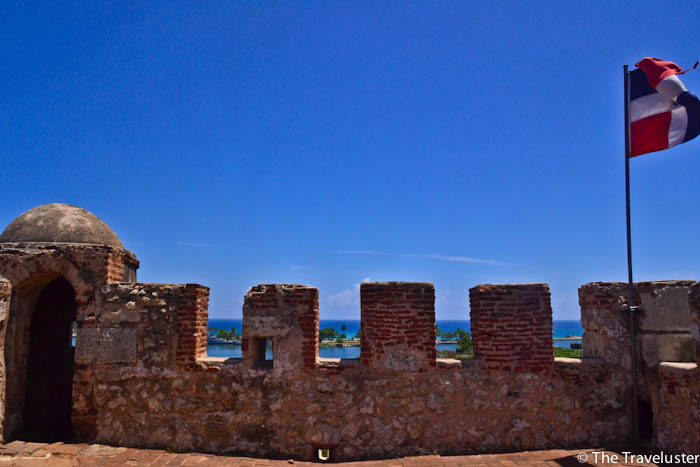
Since the DR has seen many occupiers over the years, the fort has flown the flag of Spain, France, England, Haiti, Gran Columbia, the U.S. and the DR.

The fort has only been open for public viewing since the 1970s. Prior to this, it was a military base and prison.
Along the river, two rows of cannons, one dating from 1570 and the second added in the mid-1600s, served as a first line of defense for the city’s port.

Give in to the temptation to sit atop the Tower of Homage for a while, taking in the Caribbean breeze and the site of the palm-fringed coast surrounding a picturesque lighthouse. In Santo Domingo’s mid-day, stifling heat, this may be your only reprieve!
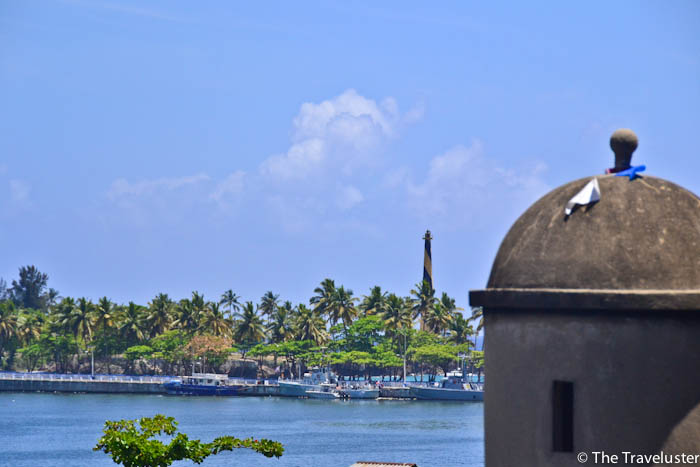
Stop 9 ( Drive by) – Hostal Nicolás de Ovando & Casa de Francia
The Casa de Francia, like its name suggests, is the French Embassy. However, the history of the building holds intrigue. Built in the early 16th century as a residence for Hernán Cortés, it is believed that this is where he planned his brutal and triumphant expedition to conquer central Mexico’s Aztecs.
The house was a residence for several centuries, and it has also functioned as Santo Domingo’s National Bank, a civil courthouse and the headquarters of the Dominican IRS.

Casa de Francia
Across the street, Governor Nicolás de Ovando’s Gothic residence, built in 1509, is now the Sofitel Hotel. In addition to selecting Fort Ozama’s site, he is famous for ordering Santo Domingo to be rebuilt on the west bank of the Río Ozama after a hurricane destroyed the colony.

Hostal Nicolás de Ovando on right, The Panteón Nacional on left
Stop 10 ( Drive by) – The Panteón Nacional has gone through many identity changes over the years. Originally built as a Jesuit church in 1747, it later became a tobacco warehouse and then a theater before dictator Trujillo restored the building to its current state in 1958.
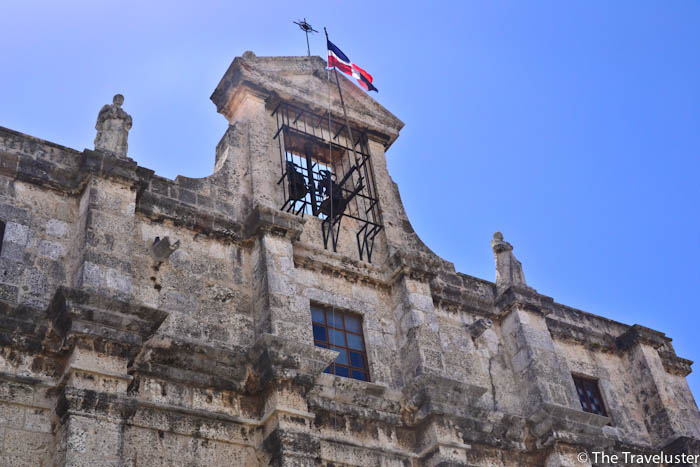
Today, the Panteón Nacional is a grand crypt, housing the remains of prominent people behind two marble walls. An armed soldier always stands at attention to guard the mausoleum’s entrance. They even perform a changing of the guard type ritual, which the soldiers take very seriously.

Stop 11 (Drive by) – Francisco de Avila built Capilla de nuestra señora de los Remedios in the early 16th century. The Gothic chapel was intended to be a private family mausoleum. Early settlers attended Mass here under the barrel-vaulted ceiling.

Stop 12 (Stay a while) – One of Zona Colonial’s highlights, the Museo de las Casas Reales is worth at least an hour visit. The Renaissance-style building, constructed in the 16th century, is a site to behold. Notice the porous stone and brick crown moulding.
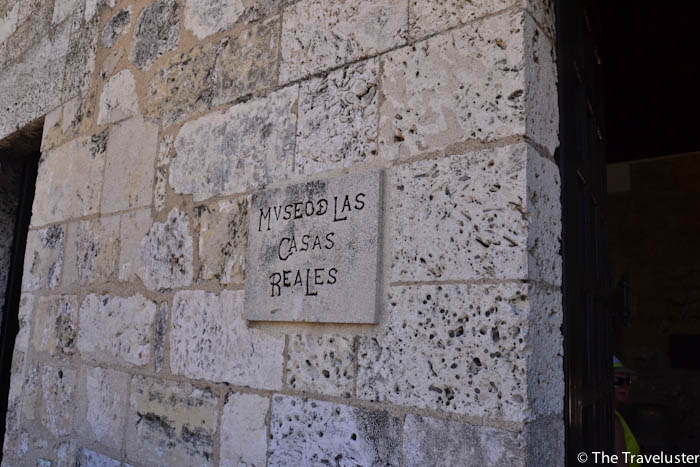
The building was the seat of the Spanish authority for the whole Caribbean region, housing the Royal Court and Governor’s office. Now, this museum showcases fabulous colonial-era objects, including treasures recovered from sunken Spanish galleons, antique weaponry, Taino artifacts, and period furnishings.

Sugar mixing bowls

This is not really what I imagined Christopher Columbus looked like….
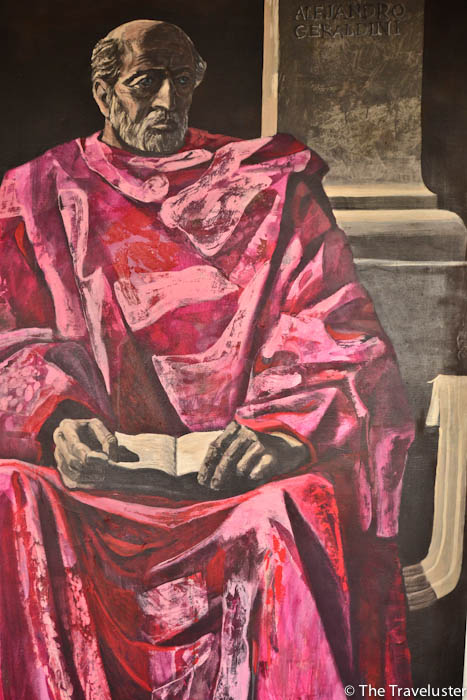
There are some amazing old maps showing voyages of European conquistadors and explorers.

The resident peacock added colorful flare to the inner courtyard.
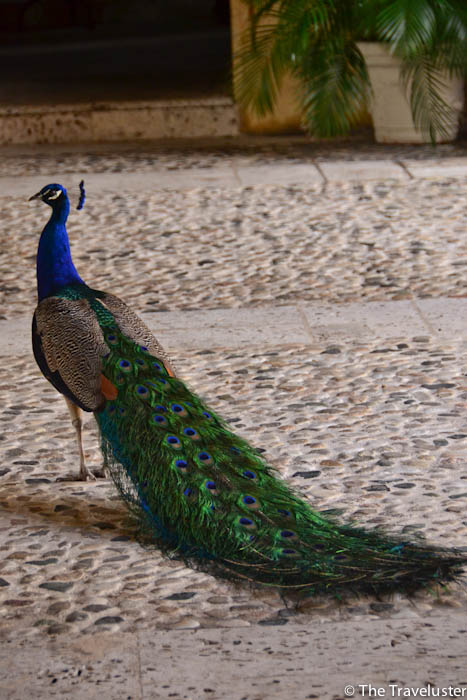
Stop 13 (Stay a while) – Walking through the breezy open-air hallways and rooms of Diego Columbus’s house, you’re almost able to imagine what life was like on the island in the 16th century. Museo Alcázar de Colón is easily a highlight (if not the highlight) of the Zona Colonial tour (next to Casa Reales).

This architectural gem, designed in the Gothic-Mudéjar transitional style, is Columbus’s son Diego’s home. He lived here in the early 16h century with his wife Doña María de Toledo. They left their home to relatives when they were recalled to Spain in 1523, whom occupied the residence for about a century.

I think I could live here!
It later became a prison and then a warehouse before being completely abandoned. In 1775, it was the unofficial city dump (Can you imagine? This beautiful building!) Only two walls were left standing by late 1800. The current structure is a result of three restorations in 1957, 1972, and 1992.

The reconstruction was closely monitored to adhere to correct historical authenticity. Today it houses pieces that belonged to the Columbus family, including beautifully wood-carved canopy beds and dining room furniture.

Stop 14 (Stay a while) – The lovely, open Plaza España , in front of the Alcázar de Colón, is lined with restaurants like the popular Pat’e Palo (Peg Leg). This is the spot for dinner and drinks at an outside table around sunset. The buildings that house the restaurants were at one point warehouses during the 16th and 17th centuries.

View of Plaza de España from the Museo Alazar Colon balcony
Stop 15 (Stay a while) – Calle El Conde is Zona Colonial’s busy pedestrian street. The commercial walkway, lined with cafes, souvenir shops, painting stands, and even a Payless stretches from the cathedral to the Parque Independencia. Large signs explain historical aspects of the street and city about every block or so.
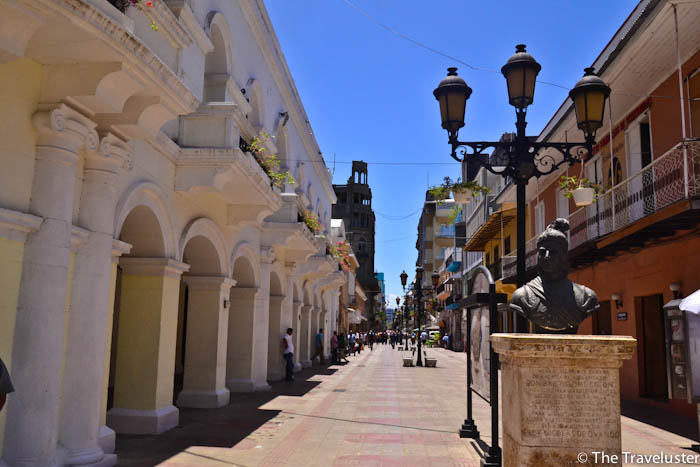
Stop 16 ( Drive by) – The Puerta de Conde (Gate of the Count) is the site of significant defensive stands against invaders and therefor a symbol of Dominican patriotism. First, the Count of Peñalba led the defense against 13,000 invading British troops at this spot in 1655.
Again in 1844, the Dominicans took a stand here against invaders, this time in a bloodless coup to overthrow occupying Haitians, resulting in the creation of an independent Dominican Republic. The very first Dominican flag was raised atop this gate.
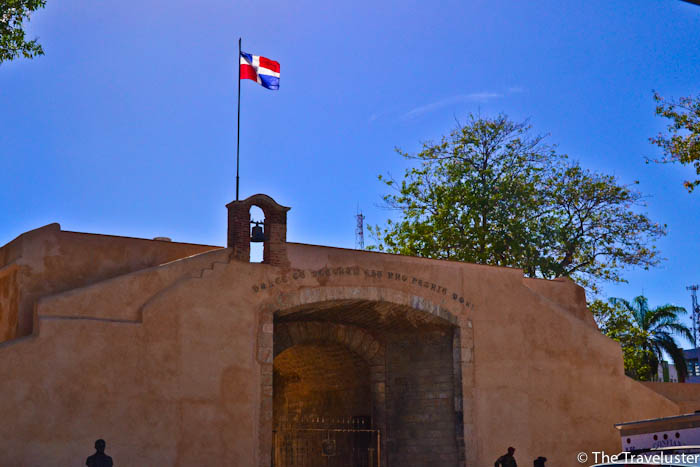
Stop 17 ( Drive by or skip) – Just west of the Count’s Gate is the Parque Independencia, where the Altar de la Patria resides. This mausoleum holds the remains of three national heroes: Francisco del Rosario Sánchez, Juan Pablo Duarte, and Ramón Matías Mella.
The entrance to the park seemed closed when I arrived. The intersection was congested and busy, so I decided not to pursue it any further. I can’t speak definitively about whether it’s worth a visit.
Stop 18 ( Drive by but go inside) – Iglesia de la Regina Angelorum
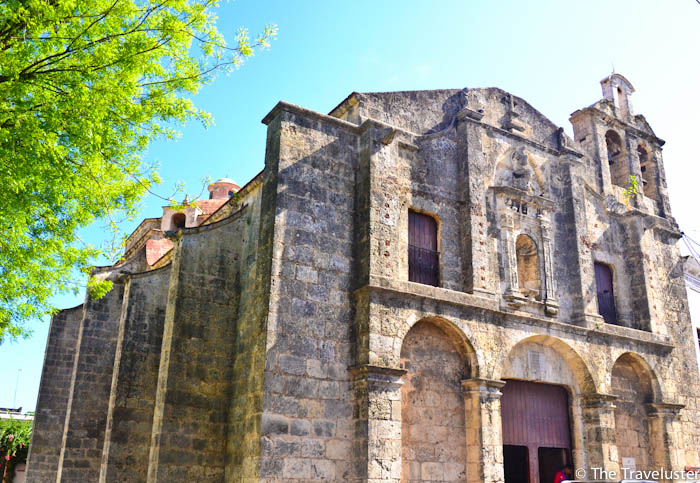
When I stopped in this church, there was a wedding rehearsal under way, so I wasn’t able to get close to the elaborate 18th century baroque altar, one of the features it is known for. I did catch a glimpse of the imposing façade, though. The church was built at the end of the 16th century with funds from a woman’s entire fortune, which she dedicated to the cloistered Dominican Sisters.

In total, I spent about three days exploring Zona Colonial. I could have stayed longer, peeking in to little patios tucked away on side streets. For those short on time, the highlights of the colonial city could easily be seen in one (very full) day as well.
If you’ve ever done a walking tour of Santo Domingo’s Zona Colonial, what were your favorite sites, and what (if anything) would you skip or even add?

You May Also Like

The Mercure Hotel in Santo Domingo, In the Center of It All

Las Terrenas, The Perfect Expat Beach Haven

Hotel El Beaterio: The Coolest Place to Stay in Santo Domingo
Leave a reply cancel reply.
Your email address will not be published. Required fields are marked *
Save my name, email, and website in this browser for the next time I comment.
dominicantourguide.com

Step Back in Time with Santo Domingo Historical Walking Tours

Are you ready to discover the historical sites of Santo Domingo ? Embark on a fascinating journey through time with Santo Domingo historical walking tours .
Santo Domingo, the capital of the Dominican Republic, is home to the historic central neighborhood of La Zona Colonial . As the oldest continuously inhabited European settlement in the Americas, La Zona Colonial is a treasure trove of cultural heritage and centuries-old landmarks.
By joining a historical walking tour, you’ll have the opportunity to explore the origin and history of this incredible Caribbean city. Immerse yourself in the rich tapestry of Santo Domingo’s past as knowledgeable guides take you on a captivating journey through the streets of the Zona Colonial.
Discover colonial-era ruins , visit Dominican cultural history museums , and learn about the city’s significance in the history of the Americas. Walking tours of Santo Domingo’s historic landmarks offer a unique and immersive way to experience the charm and beauty of this vibrant city.
Key Takeaways:
- Explore Santo Domingo’s historic central neighborhood , La Zona Colonial , on a historical walking tour.
- Discover the colonial-era ruins and cultural history museums that showcase the rich heritage of Santo Domingo.
- Visit iconic landmarks such as the Dominican Convent , Fortaleza Ozama , and Catedral Santa Maria la Menor .
- Experience the vibrant nightlife and indulge in delicious local cuisine in the Zona Colonial.
- Book a Santo Domingo historical walking tour to make the most of your visit to this captivating city.
The Charm of La Zona Colonial
La Zona Colonial, also known as the Colonial Zone, is the heart of Santo Domingo. It dates back to 1496, making it the oldest continuously inhabited European settlement in the Americas. While many travelers visit the Dominican Republic for its beautiful beaches, Santo Domingo offers much more. Explore the colonial-era ruins , immerse yourself in the local city vibes, and visit the Dominican cultural history museums that showcase the rich heritage of this Caribbean city.
Exploring the Colonial Zone
When you join a walking tour of the Zona Colonial, you’ll get to visit various stops that showcase the historical and cultural significances of Santo Domingo. Explore the Dominican Convent , which dates back to 1510 and is home to important altarpieces. Visit Parque Pellerano Castro , also known as Parque Rosado, where you’ll find the statue of Julia de Burgos. Walk down the beautifully preserved cobblestone street, Calle Las Damas , the first paved street in the Americas. Discover the Fortaleza Ozama , the oldest standing fort in the Americas. Stroll along Calle El Conde , the first commercial street in Santo Domingo, lined with restaurants and shops. Visit Parque Colón , the central square of the Zona Colonial, and admire the Catedral Santa Maria la Menor , the first church built in the Americas. Indulge in delicious artisanal ice cream at Paletas Bajo Cero . Pay a visit to the Panteon de la Patria , where the country’s most honored citizens are buried. Explore the Chapel of our Lady of Remedy and the Museum of Royal Houses . Take in the beauty of Plaza España and explore the ruins of the Monasterio de San Francisco and Hospital San Nicholas de Bari.

“Exploring the Zona Colonial is like stepping back in time and immersing yourself in the rich history of Santo Domingo. From centuries-old forts to charming cobblestone streets, each stop on the walking tour reveals a unique aspect of this Caribbean city’s cultural heritage.”
Transportation and Safety in Santo Domingo
When visiting Santo Domingo, it’s crucial to plan your transportation options and prioritize safety precautions. Here are some essential tips to ensure a smooth and secure experience in this vibrant city.
Transportation Options
- Santo Domingo Airport: The Santo Domingo airport serves as a convenient starting point for exploring the city and the rest of the island. It offers budget-friendly airfare options and serves as a reliable hub for both international and domestic travelers.
- Avoid driving in Santo Domingo: Navigating the city’s erratic traffic rules and driving habits can be challenging for visitors. It’s advisable to avoid renting a car and driving yourself. Instead, opt for alternate means of transportation to navigate the city safely.
- Uber: Uber is available in Santo Domingo, providing a convenient and reliable transportation option within the city limits. Download the Uber app on your smartphone to easily request rides and explore the city hassle-free.
Safety Precautions
- Mind your belongings: Like any other urban destination, it’s important to remain mindful of your personal belongings while exploring Santo Domingo. Keep valuables secured and be aware of your surroundings, especially in crowded areas and public transportation.
- Use safe transportation: Stick to reputable transportation services, such as registered taxis or rideshare apps like Uber, to ensure your safety during transit. Avoid accepting rides from unlicensed or unmarked vehicles.
- Stay in well-lit areas: When walking around Santo Domingo, prioritize well-lit streets and crowded areas, especially during the evening and nighttime. It’s always safer to explore with others or in groups, especially in unfamiliar neighborhoods.
By considering transportation options and implementing simple safety precautions, you can enjoy a worry-free visit to Santo Domingo. Remember to plan your transportation in advance and stay alert to make the most of your time exploring this captivating city.
Public Transportation Alternatives
If you prefer public transportation, Santo Domingo offers a range of options to get around the city:
Colonial Zone Santo Domingo Hotels
For a comfortable stay in the Colonial Zone of Santo Domingo, consider booking a hotel in the area. There are several options available that cater to different budgets and preferences. Whether you’re looking for a boutique hotel, a budget-friendly hostel, or a mid-range accommodation, Santo Domingo has you covered.
If you’re seeking a luxurious and stylish experience, Luca Hotel is a top choice. This boutique hotel by The Oxo House offers a range of price options to suit different budgets. With its elegant rooms, modern amenities, and attentive service, Luca Hotel ensures a comfortable and memorable stay in the heart of the Colonial Zone.
Hostel La Colonia
Traveling on a budget? Hostel La Colonia is a great option for backpackers and budget-conscious travelers. This hostel offers affordable accommodations with a friendly atmosphere. The highlight of Hostel La Colonia is its balcony, which provides stunning views of the Colonial Zone. Wake up to picturesque surroundings and start your day with a breathtaking view.
Casa Sanchez
If you prefer a mid-range hotel with additional amenities, Casa Sanchez is the perfect choice. This hotel features a refreshing pool, where you can cool off and unwind after a day of exploring. With its comfortable rooms, friendly staff, and convenient location, Casa Sanchez offers a pleasant stay for travelers looking for a balance between comfort and affordability.
Whichever hotel you choose, you’ll enjoy the charm and convenience of staying in the historic area of Santo Domingo. Embrace the rich cultural heritage and immerse yourself in the vibrant atmosphere of the Colonial Zone.
Things to Do in Santo Domingo | Zona Colonial Walking Tour
Besides the historical landmarks, there are plenty of other activities to enjoy while exploring Santo Domingo. Take your time to walk around La Zona Colonial and soak in the history and charm of the area. Explore the picturesque streets, soak up the local atmosphere, and shop for souvenirs along Calle El Conde . Don’t forget to try some delicious artisanal ice cream at Paletas Bajo Cero . Santo Domingo offers a wealth of experiences and sights to discover.

As you stroll through La Zona Colonial, you’ll be captivated by the architectural beauty and colonial-era charm that surrounds you. The cobbled streets and colorful facades create a picturesque setting for a leisurely walk. Explore the narrow alleys and secret corners, uncovering hidden gems along the way.
Must-See Sights in La Zona Colonial
If you’re looking for specific attractions to include on your walking tour, here are some must-see sights in La Zona Colonial:
- The Dominican Convent : A historic convent dating back to 1510, known for its impressive altarpieces.
- Parque Pellerano Castro : Also known as Parque Rosado, featuring a statue of Julia de Burgos, a renowned Dominican poet.
- Calle Las Damas : The first paved street in the Americas, lined with colonial-style houses.
- Fortaleza Ozama : The oldest standing fort in the Americas, offering panoramic views of the city.
- Parque Colón : The central square of the Zona Colonial, surrounded by colonial-era buildings.
- Catedral Santa Maria la Menor : The first church built in the Americas, featuring Gothic and Baroque architecture.
- Paletas Bajo Cero : Indulge in delicious artisanal ice cream made with local ingredients.
These are just a few highlights, and there are many more historical sites, museums, and landmarks to explore in La Zona Colonial. Each corner tells a story, allowing you to immerse yourself in the rich history and culture of Santo Domingo.

Immerse Yourself in the Local Culture
While walking through La Zona Colonial, take the time to soak up the local atmosphere. Engage with the friendly locals, visit the vibrant local markets, and sample authentic Dominican cuisine. You can also discover traditional arts and crafts at local artisan workshops or enjoy live music performances that celebrate the local Dominican rhythms.
Exploring the Zona Colonial on foot is not just a sightseeing experience; it’s an opportunity to connect with the heart and soul of Santo Domingo.
Shop for Souvenirs and Local Products
Calle El Conde is a shopper’s paradise, offering a wide range of boutiques, galleries, and souvenir shops. Stroll along this vibrant street and browse unique handmade crafts, locally produced goods, and stylish fashion items. Whether you’re looking for traditional Dominican products or trendy souvenirs, Calle El Conde has something for everyone.
Take home a piece of Santo Domingo’s vibrant culture by purchasing authentic Dominican cigars, local artwork, or colorful handicrafts. These unique items are not only beautiful mementos of your trip but also support local artisans and contribute to the preservation of Dominican traditions.
Inspiration at Every Turn
As you explore Santo Domingo’s Zona Colonial on a walking tour, you’ll find inspiration at every turn. The juxtaposition of centuries-old landmarks and modern elements creates a dynamic and vibrant atmosphere that sparks your imagination. Capture the beauty of the colonial architecture, the energy of the bustling streets, and the rich cultural heritage of this captivating city.
Recommended Activities in Santo Domingo
There’s no shortage of activities and experiences to enjoy in Santo Domingo. Whether you’re interested in history, culture, food, or simply taking in the vibrant atmosphere, a Zona Colonial walking tour will provide a memorable journey through the heart and soul of this fascinating city.
Nightlife in Santo Domingo | Zona Colonial
After a day of exploring the historical sites of Santo Domingo, the vibrant nightlife in the Zona Colonial awaits. Nightlife in Santo Domingo is a thrilling experience, with a plethora of bars, restaurants, and clubs to choose from. Immerse yourself in the pulsating rhythms of live music, dance to local beats, and indulge in the mouthwatering flavors of traditional Dominican cuisine.
The Zona Colonial truly comes alive at night, creating a unique atmosphere that entices visitors from all over the world. Whether you’re seeking a laid-back evening of cocktails or a high-energy night of dancing, the nightlife in Santo Domingo offers something for everyone.
Enjoy an intimate evening at a quaint wine bar, sipping on exquisite vintages and engaging in lively conversations with locals and fellow travelers. Dance the night away to infectious Latin music at a vibrant nightclub, where the energy is infectious and the party lasts until the early hours of the morning.
The Best Nightlife Hotspots in Zona Colonial
- La Alpargatería: A charming rooftop bar offering breathtaking views of the city. Savor refreshing cocktails and mingle with the trendy crowd.
- Jalao: Experience the fusion of traditional and contemporary Dominican music in this lively venue. Dance to the rhythms of merengue, bachata, and salsa.
- Mamey Librería Café: A hipster’s paradise, this bookstore and café transforms into a cozy speakeasy at night. Sip on artisanal cocktails while browsing through the shelves of eclectic literature.
- La Atarazana: Immerse yourself in the vibrant Dominican culture at this lively bar. Enjoy live music performances and dance to the infectious tunes of local bands.
- El Conde: Exploring the bustling street of El Conde is a must when experiencing the nightlife in Santo Domingo . Lined with bars, clubs, and street vendors, it offers a lively and dynamic atmosphere.
Whether you’re a salsa aficionado, a lover of live music, or simply looking to unwind after a day of sightseeing, the nightlife in Santo Domingo’s Zona Colonial promises an unforgettable experience.
Guided Tours and Experiences in Santo Domingo
If you prefer a guided experience while exploring Santo Domingo, there are various tours available. From historical walking tours to bus tours, these guided experiences offer in-depth knowledge and insights into the city’s rich history and cultural heritage. Choose a tour that suits your interests and preferences to make the most of your visit to Santo Domingo.
Experience the Rich History of Santo Domingo
If you’re a history enthusiast, a historical walking tour is an ideal way to delve into the captivating stories and landmarks of Santo Domingo. Accompanied by knowledgeable guides, you’ll explore the city’s historical sites and gain insights into its colonial past and cultural significance. From the cobblestone streets of Calle Las Damas to the majestic Cathedral Santa Maria la Menor, each step on the tour will transport you back in time.
Discover the Vibrant Culture of Santo Domingo
Santo Domingo is not only a city of history but also a city alive with vibrant culture. Consider joining a guided tour that focuses on the cultural aspects of the city. These tours may include visits to local markets, art galleries, and traditional music and dance performances. Immerse yourself in the sights, sounds, and flavors of Santo Domingo as you explore its dynamic cultural scene.
Explore Santo Domingo’s Natural Beauty
If you’re a nature lover, Santo Domingo has guided tours that allow you to discover the city’s natural wonders. From exploring lush parks and botanical gardens to hiking through scenic landscapes, these tours offer a unique perspective of Santo Domingo’s natural beauty. Learn about the region’s flora and fauna while experiencing the tranquility of its outdoor spaces.
Whether you choose a historical walking tour, a cultural tour, or a nature tour, guided experiences in Santo Domingo offer unique insights and a deeper understanding of the city’s rich heritage. Book a tour today and embark on a memorable journey through the history, culture, and natural beauty of Santo Domingo.
What to Expect on a Santo Domingo Historical Walking Tour
Embarking on a Santo Domingo historical walking tour is an immersive experience that allows you to delve into the city’s rich history and cultural significance. Lasting approximately three hours, these tours take you on a journey through various historical sites and landmarks in the Zona Colonial.
Guided by knowledgeable experts, you can expect to gain valuable insights into the city’s past as you explore the cobblestone streets and architectural wonders. Learn fascinating stories and anecdotes that bring the history of Santo Domingo to life.
Comfortable shoes are recommended, as there will be plenty of walking involved. As you make your way from one site to another, you’ll have the opportunity to witness the city’s charm up close and personal.
“Walking is the best way to truly absorb the ambiance of Santo Domingo’s historic district.” – Local Guide
Some tours may also include food and drink stops along the way, allowing you to indulge in delicious local cuisine and beverages. Savor the flavors of Santo Domingo as you take a break from exploring the fascinating historical sites.
Keep in mind that the Santo Domingo historical walking tour is not just about sightseeing. It’s an interactive experience that engages all your senses, allowing you to fully immerse yourself in the city’s vibrant history and culture.
So put on your most comfortable shoes, bring along your curiosity, and get ready to uncover the secrets and stories of Santo Domingo’s past on a historical walking tour.
Where to Book a Santo Domingo Historical Walking Tour
If you’re ready to explore the historical wonders of Santo Domingo, it’s time to book a Santo Domingo historical walking tour . There are several reputable tour operators and agencies that offer informative and engaging tours of this captivating city. To find the perfect tour for you, start by researching online. Look for companies that have a good reputation and positive reviews from previous participants.
Reading reviews can provide valuable insights into the quality of the tour and the experiences of others. It’s a great way to gauge the level of customer satisfaction and determine if a particular tour meets your interests and expectations. Popular travel booking platforms may also offer options for booking historical walking tours in Santo Domingo. Take advantage of these platforms to find a tour that fits your schedule and preferences.
Embark on a journey through time and discover the rich history of Santo Domingo with a historical walking tour. Book your tour today and let the knowledgeable guides immerse you in the fascinating stories and cultural heritage of this Caribbean city.

Santo Domingo Historical Walking Tours Reviews
Reading reviews from fellow travelers is a great way to get insights into the experience of Santo Domingo historical walking tours . Pay attention to positive comments about knowledgeable guides, engaging tour routes, and informative commentary. Look for reviews that mention the highlights of the tour and the overall satisfaction of previous participants. Hearing from others who have taken the tour can help you make an informed decision when planning your own Santo Domingo historical walking tour .
Looking for the Best Santo Domingo Historical Walking Tour?
If you’re searching for the best Santo Domingo historical walking tour, look no further! The reviews speak for themselves. Book a tour today and embark on a captivating journey through the history and culture of Santo Domingo’s Zona Colonial.
Santo Domingo’s historical walking tours offer a fascinating journey into the rich heritage of this Caribbean city. Immerse yourself in the centuries-old landmarks, cultural museums, and vibrant atmosphere of Santo Domingo’s Zona Colonial. Whether you’re a history enthusiast, a culture lover, or simply curious about the origins and evolution of the Americas, a historical walking tour in Santo Domingo is a must-do experience.
Discover the charm of La Zona Colonial as you explore its hidden treasures and architectural marvels. Walk the cobblestone streets, visit colonial-era ruins, and marvel at the impressive Cathedral Santa Maria la Menor, the first church built in the Americas. The historical walking tours in Santo Domingo offer a unique opportunity to gain insights into the city’s past while indulging in its vibrant present.
Uncover the captivating stories behind each stop on your walking tour, from the Dominican Convent and Fortaleza Ozama to the Museum of Royal Houses and the Ruinas del Monasterio de San Francisco . The expert guides will provide informative commentary, helping you piece together the puzzle of Santo Domingo’s history.
So, lace up your comfortable shoes and embark on a Santo Domingo historical walking tour. Let the enchanting streets, remarkable landmarks, and vibrant atmosphere transport you to a bygone era, as you discover the wonders of this captivating Caribbean city.
What is Santo Domingo known for?
Santo Domingo is known for its historic central neighborhood, La Zona Colonial, which is the oldest continuously inhabited European settlement in the Americas.
What can I explore in the Colonial Zone of Santo Domingo?
In the Colonial Zone of Santo Domingo, you can explore colonial-era ruins, visit Dominican cultural history museums , and walk along cobblestone streets.
What are some of the stops on a Zona Colonial walking tour?
Some of the stops on a Zona Colonial walking tour include the Dominican Convent, Parque Pellerano Castro , Calle Las Damas, Fortaleza Ozama, and Parque Colón .
Is Santo Domingo a safe city?
Santo Domingo is generally a safe city, but it’s always important to remain mindful of your belongings while walking around.
Where can I stay in the Colonial Zone of Santo Domingo?
There are several hotels in the Colonial Zone of Santo Domingo, including Luca Hotel , Hostal La Colonia , and Casa Sanchez .
What else can I do in Santo Domingo besides the historical walking tour?
Besides the historical walking tour, you can explore the picturesque streets, shop for souvenirs, and try delicious artisanal ice cream at Paletas Bajo Cero.
What is the nightlife like in Santo Domingo’s Zona Colonial?
The Zona Colonial offers a vibrant nightlife with numerous bars, restaurants, and clubs where you can enjoy live music, local rhythms, and delicious Dominican cuisine.
Can I take a guided tour in Santo Domingo?
Yes, there are various guided tours available in Santo Domingo, including historical walking tours and bus tours.
What can I expect on a Santo Domingo historical walking tour?
On a Santo Domingo historical walking tour, you can expect to visit various historical sites and landmarks in the Zona Colonial and learn about the city’s history from a knowledgeable guide.
Where can I book a Santo Domingo historical walking tour?
You can book a Santo Domingo historical walking tour through reputable tour operators and agencies. Research online or check popular travel booking platforms for options.
Are there any reviews of Santo Domingo historical walking tours?
Yes, you can find reviews of Santo Domingo historical walking tours online. Reading reviews from previous participants can help you make an informed decision when planning your own tour.
Why should I choose a historical walking tour of Santo Domingo?
A historical walking tour of Santo Domingo offers a unique and immersive experience to explore the rich heritage of the city, its centuries-old landmarks, and vibrant atmosphere.
Lorem ipsum dolor sit amet, consectetur adipiscing elit. Ut elit tellus, luctus nec ullamcorper mattis, pulvinar dapibus leo.
Table of Contents
Leave a comment cancel reply.
Your email address will not be published. Required fields are marked *
Save my name, email, and website in this browser for the next time I comment.

18 Top-Rated Things to Do in Santo Domingo
Written by Lana Law Updated Mar 23, 2023 We may earn a commission from affiliate links ( )
Santo Domingo's Zona Colonial is the highlight of this city and where most of the important tourist attractions are located. The old center is a delightful mix of history and modern Dominican life. Crumbling 16th-century ruins scattered between wonderfully restored colonial buildings are a constant reminder of this city's history.
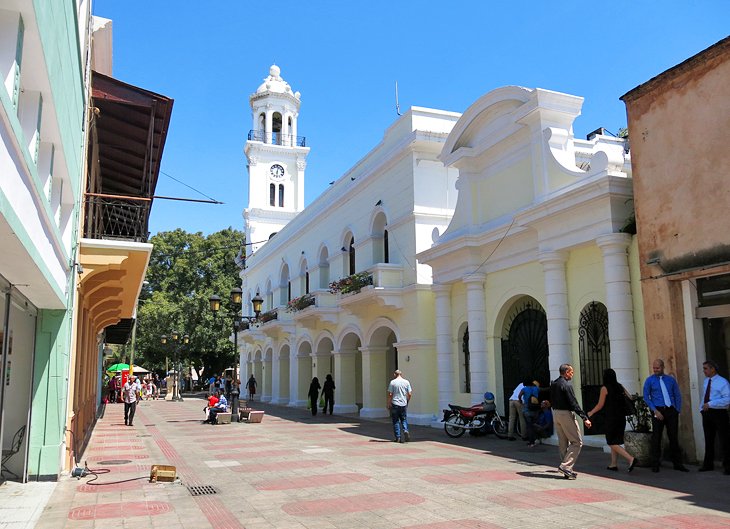
Founded by Christopher Columbus in the late 1400s, this first city of the New World is where Columbus lived and is buried. Today, the entire colonial district, Zona Colonial, is a UNESCO World Heritage Site , and many of the historic buildings house museums, restaurants, and hotels.
Most of the attractions and things to do described here are within the Zona Colonial. This area is relatively compact and easy to explore on foot, but with so much to see, it's easy to spend a few days here sightseeing and soaking up the atmosphere.
Narrow one-lane roads open onto parks with mature trees and old stone buildings. Outdoor restaurants, reminiscent of European cafés, offer inviting retreats from the heat of the day, where you can sit and watch life go by.
Parque Colón (Columbus Park) and Plaza España are two of the main tourist hangouts and good places to start your tour. You'll find numerous restaurants in these areas, as well as official tour guides offering to show you around and providing information on things to do in Santo Domingo.
Parque Colón (Columbus Park)
Catedral primada de américa (first cathedral in the americas), museo de las casas reales (museum of the royal houses), panteón nacional (national pantheon of the dominican republic), plaza españa, the three eyes (los tres ojos) national park, chu chu colonial sightseeing trolley, national botanical gardens, national zoological park, monasterio de san francisco, chocomuseo santo domingo, calle el conde, parque independencia, amber world museum, convento de los dominicos, bicycle ride or tour through santo domingo, photographing the zona colonial, map of things to do in santo domingo, frequently asked questions about santo domingo, when is the best time to visit santo domingo, what are the best day trips from santo domingo.
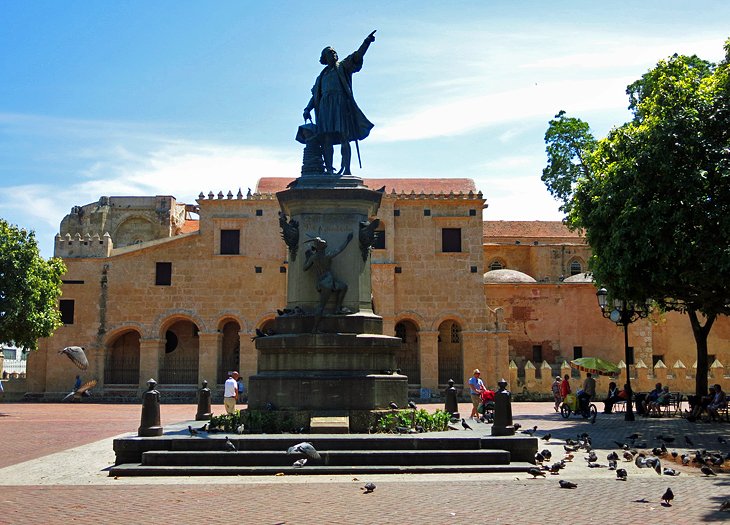
At the heart of the Zona Colonial is Parque Colón, the most lively and enticing square in the city. Musicians and street performers frequent the square, shoe shiners set up along the street side, and children chase pigeons around the statue of Christopher Columbus , which stands in the center.
On the south side of the square is the Catedral Primada de América , the first cathedral built in the Americas. Constructed in the early 1500s and completed in 1540, its real name is Basilica Cathedral of Santa María la Menor.
Running along the north side of the Parque Colón is Calle El Conde, the city's main pedestrian street , with a couple of restaurants with outdoor tables that look onto the park. This is the best place to sit and appreciate the sights and sounds of this beautiful square.
If you are looking to take a tour, the Chu Chu Colonial tourist trolley departs from the east side of the square.
This is also a perfect area to base yourself if you are spending a night or more. Not far from Parque Colón is the quaint Boutique Hotel Palacio , set in a historic building with a beautiful courtyard and old-world charm. It offers a variety of luxury to mid-range rooms that vary in size and price. Another hotel worth considering, with a similar colonial atmosphere, is the El Beaterio Casa Museo .
Location: Calle El Conde and Calle Arzobispo Meriño
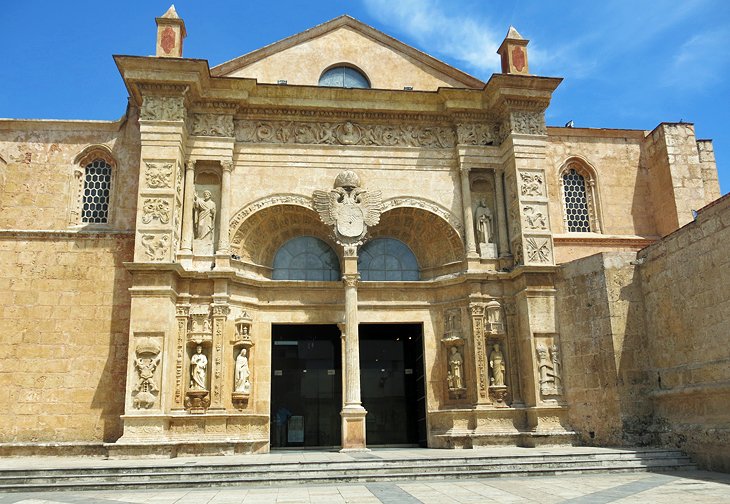
This impressive basilica, set on the south side of Parque Colón, was completed in 1540 and was the first cathedral built in the Americas. This is not a ruin but a functioning place of worship that still maintains many of the original features from the 16th century.
The original Mahogany doors open into the grand interior, where you can see the silver altar and a painting of the Virgin Mary from 1520. Although the real name is Basilica Cathedral of Santa María la Menor, tourist maps list this site as Catedral Primada de América.
Location: South side of Parque Colón on Calle Arzobispo Meriño
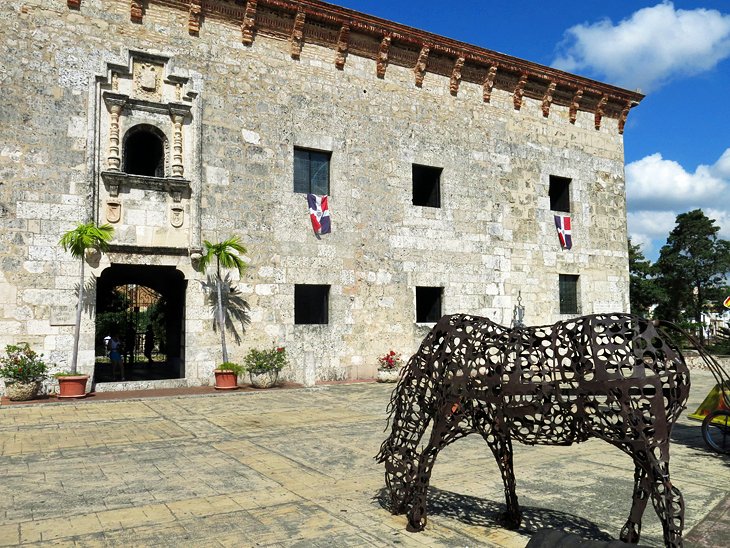
Built in the first half of the 16th century, this impressive structure was originally constructed on orders from Spain and designed to house the most important government offices of the New World. In the 1970s, it was turned into a museum to showcase the history and culture of the region.
Displays include Taíno artifacts, colonial furnishings, and an interesting weapons collection, among other items. The hallways are narrow in places, and on busy days the museum can feel quite congested, but the interior courtyard, with benches and a small garden, offers a pleasant reprieve.
Displays are in Spanish, but headsets with audio recordings in multiple languages are available with your admission fee.
Location: South side of Plaza España, on Calle Las Damas
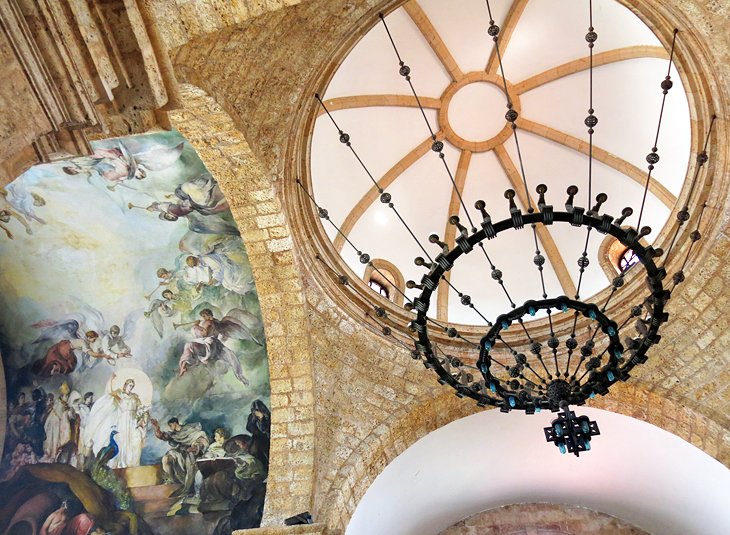
Originally constructed as a church in the first half of the 18th century, the building was converted to the national mausoleum in 1956 under the orders of dictator Rafael Trujillo to honor the country's most important people. In a twist he would not have envisioned, the building now houses, among others, the remains of the men who assassinated him.
Also interred here are famous names such as Francisco Gregorio Billini, Gregorio Luperón, Eugenio María de Hostos, and José Gabriel García.
The interior is beautiful, with marble tombs along the walls, arches, an ornately painted ceiling, and a huge Gothic-style chandelier. Opposite the entrance, at the end of a long red carpet, an eternal flame rises from the floor.
Location: Calle Las Damas, one block south of the Museo de las Casas Reales
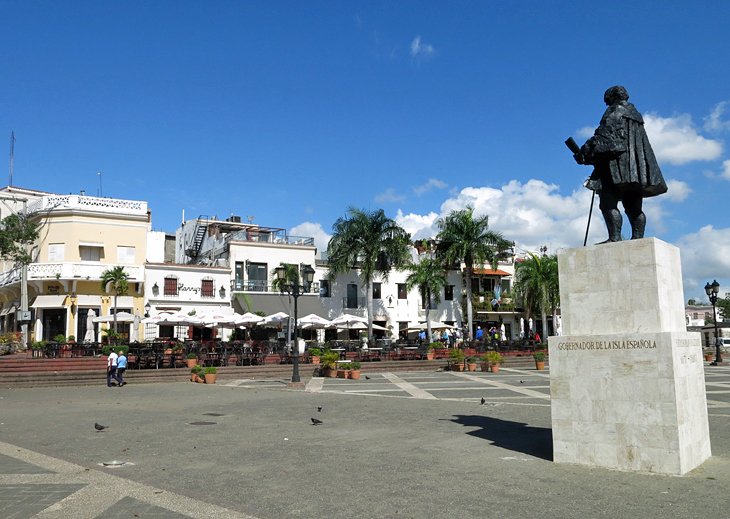
Plaza España is a large and open square on the edge of the Zona Colonial, near the Rio Ozama. Frequently the site of events and public gatherings, this is not an intimate square where you would go to sit on a bench and sip a coffee under a tree.
On the edge of the park are a number of restaurants with outdoor dining. Tour guides often hang out in the vicinity of the cafés and approach visitors to entice them into joining a walking tour.
On the square, opposite the restaurants and closer to the river, is the Alcazar de Colón . This former residence of the Columbus family is now a museum.
Location: Calle La Atarazana, or the north end of Calle Las Damas, beyond the Museo de las Casas Reales
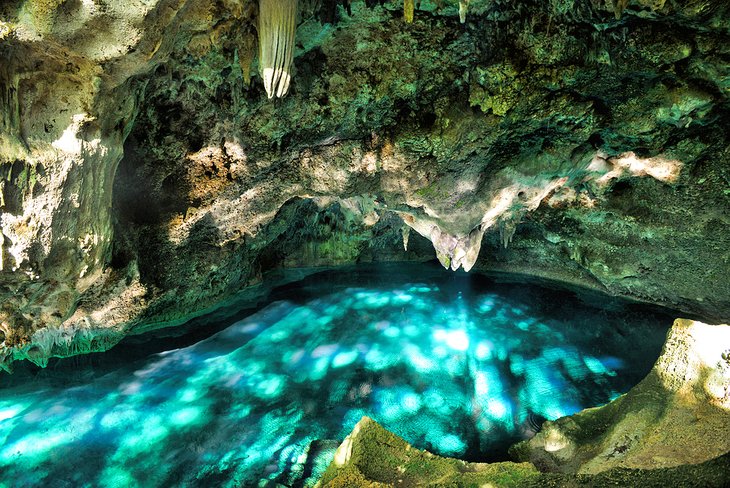
If all the historical buildings and the tight quarters of the Zona Colonial have you craving something more natural, take the 15-minute drive out to the 3 Eyes National Park. Be prepared to descend beneath the earth into lush and humid caverns, where you'll find crystal-clear waters in a series of four lakes.
The lakes are spectacular and always glass calm, making it easy to see how they received their names. With a bit of imagination, you might think they look like blue-green eyes.
The first lake you'll come to is called Aguas Azufradas, followed by La Nevera, then Lago de las Mujeres. To access the fourth lake, Los Zaramagullones, just pay a small fee and take a short and scenic boat ride. This lake can also be seen from above by following the walking trail to the overlook.
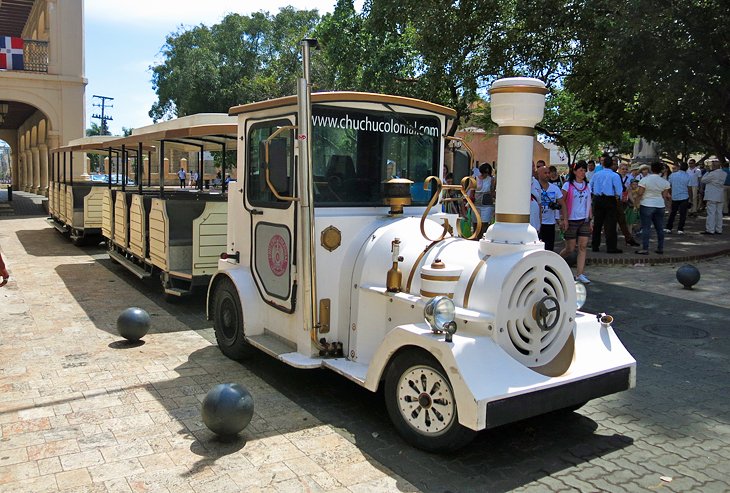
The Chu Chu Colonial is a small, open-air sightseeing train that runs through Santo Domingo's Zona Colonial. While the area is quite small and easily walkable, on hot days the Chu Chu is a tempting option.
The tour lasts about 45 minutes and lets you see the sights from the relative comfort of a shade-covered bench as it pulls you along cobbled streets and past the city's most famous sites. Keep an eye out for places you might want to visit after the tour. The tour starts from the east side of Parque Colón.
The Chu Chu Colonial runs every hour, 16 times a day.
Location: Parque Colón
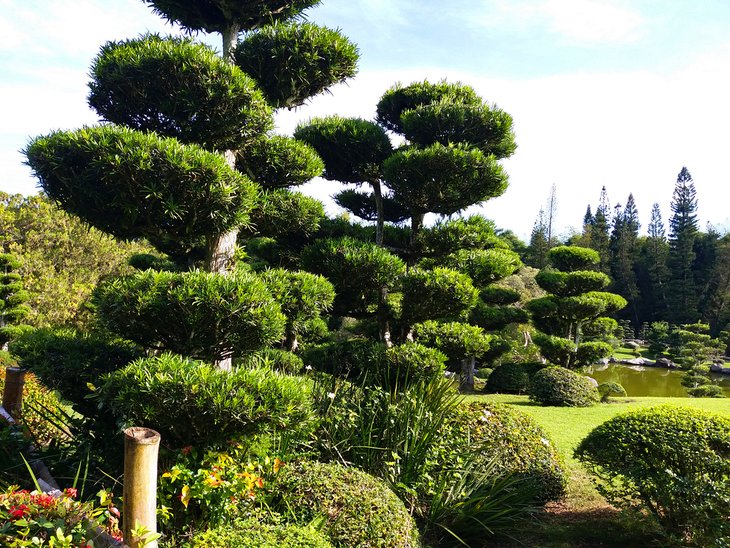
The National Botanical Gardens, known officially as the Dr. Rafael M. Moscoso Botanical Gardens, are a treasure of incredible biodiversity. The country has outdone itself with a garden that is comparable to many of the world's best. Situated on a hilltop offering good views out over the sprawling city below, the 400-acre garden is the largest in the Caribbean .
Highlights of a visit here include the Japanese Gardens, a huge floral clock, and viewing over 300 species of orchids. It's a wonderful place to stroll or, if you'd rather, take the trolley that runs on a regular basis. Bird-watchers take note, this is one of the best places in Santo Domingo to see rare avian species.
The botanical gardens are about 40 minutes from the Colonial Zone. Combine a trip here with a visit to the zoo.
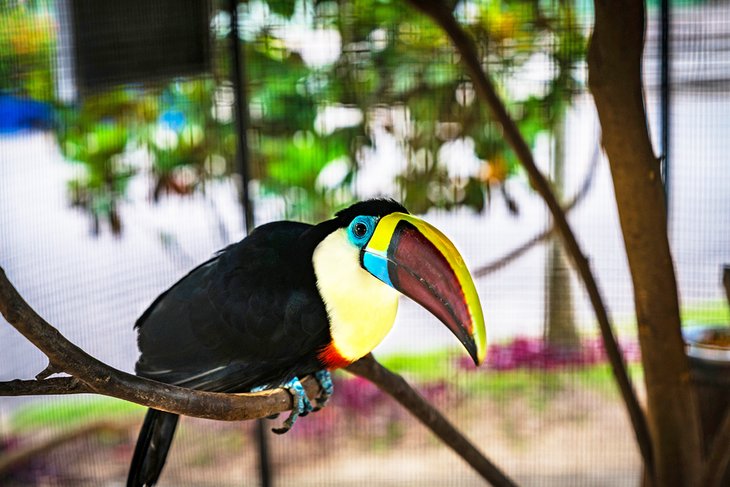
Families traveling together will love taking a trip to the National Zoological Park. Not only is it a fun day all around, admission is very cheap when compared with zoo prices around the world. A wide assortment of animals are on offer from around the world, with some of the highlights being a rhino, white tiger, jaguars, monkeys, and emus.
Kids will delight in riding the small train that passes by all the enclosures. Just hop on and hop off as you like. The zoo has recently undergone some renovation work in the main plaza, which has given it a nice refresh. Note that all the animal descriptions are in Spanish
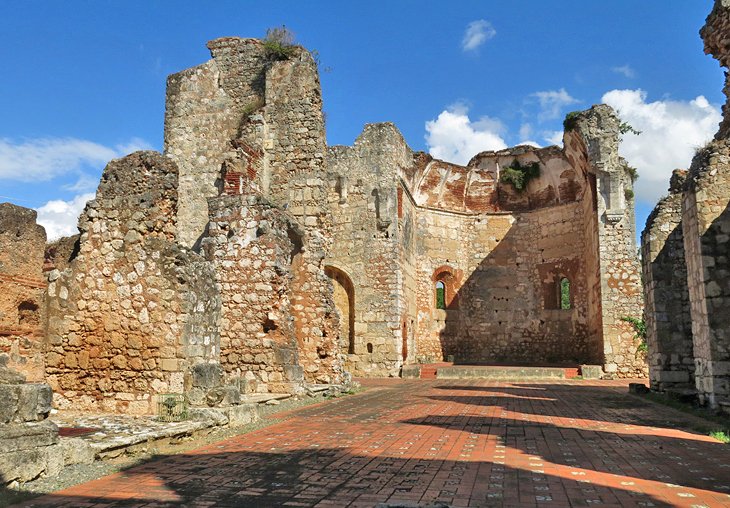
The ruins of Monasterio de San Francisco are one of the most important historical sites in the Dominican Republic. The first monastery to be built in the New World , it stands as a symbol of the trials and tribulations that have inflicted this city throughout the centuries.
The monastery has endured countless disasters, having been hit by hurricanes, devastated by earthquakes, sacked by Francis Drake, and used in battles, only to be repaired time and time again.
The site is gated and fenced on all sides, so entry is not permitted. You can, however, see the interior from the main door. The ruins are still occasionally used as a venue for some events.
It's a hot and sweaty walk uphill to visit this attraction. Fortunately several nearby restaurants offer cold drinks and pleasant shady spots to cool off.
Location: Calle Hostos and Calle Juan Isidro Perez
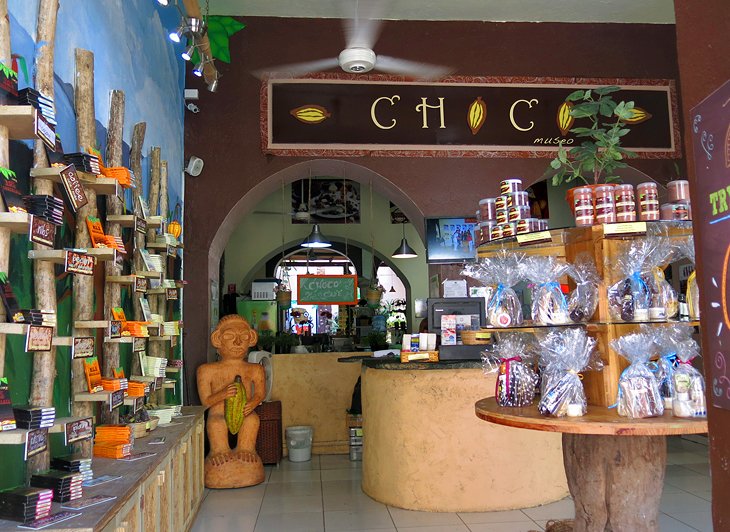
The ChocoMuseo is a tasty stop in the Zona Colonial. Housed in a 16th-century building, the museum and chocolate factory is an educational experience and a fun way to learn about the cacao industry in the Dominican Republic. You can sample pieces of chocolate and chocolate drinks or try out cacao-based beauty products.
Beyond the sampling counter is a small museum with displays on the history of cacao and the operation of drying and processing the cacao seeds. In the front portion of the store, you can purchase all kinds of chocolate goodies and products.
Displays are labeled in English and Spanish, and some of the staff speak English. The museum and chocolate sampling are free.
If the ChocoMuseo leaves you wanting more, consider strolling down the street a bit to the Kah Kow Experience shop . Here, you can enjoy a holographic theater presentation on how chocolate is made from forest to plate, see an actual chocolate factory, and even make your own chocolate bar.
Location: Near Parque Colón on Calle Arzobispo Meriño, just north of Calle El Conde.
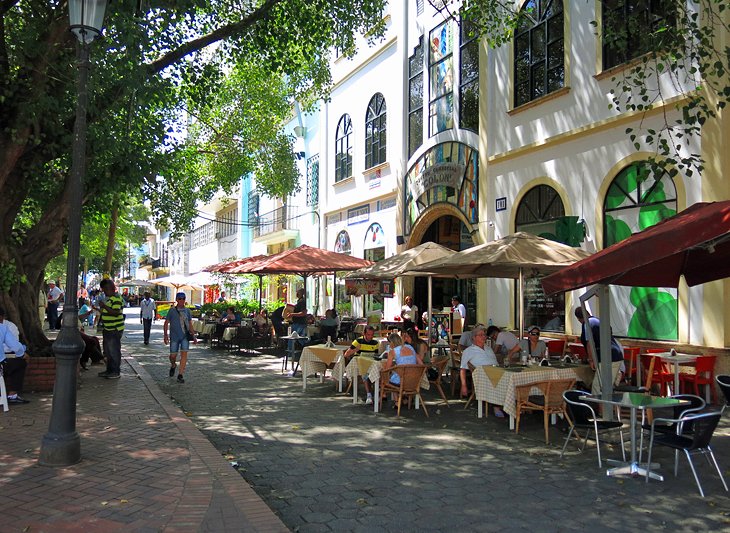
The best place to visit in Santo Domingo for outdoor dining is Calle El Conde. This pedestrian street runs from Plaza Independencia to Parque Colón and just beyond to the Rio Ozama. The most beautiful section is the portion closest to the river around Parque Colón, where most of the restaurants are located.
Restored colonial buildings lining the street and outdoor dining give this end of Calle El Conde a distinctly European feel. Tourists tend to frequent this area. As you walk towards Plaza Independencia, the street becomes more modern, with clothing stores, small shops, and a more authentic Dominican vibe.
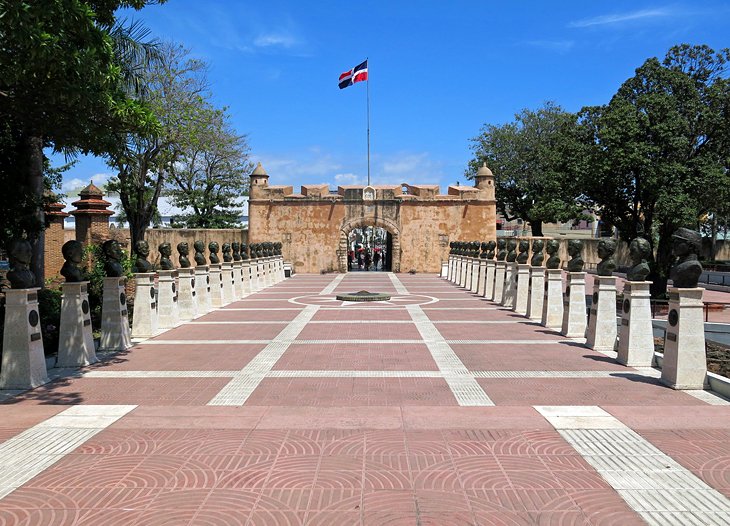
At the far west end of Calle El Conde, Parque Independencia commemorates Dominican Independence. Entering through the huge Puerta del Conde, the square is lined with busts that lead to the Altar de la Patria (Altar of the Nation), a mausoleum where the founders of the Dominican Republic are laid to rest. The names Sanchez, Duarte, and Mella are prominently displayed inside.
This square offers little to no shade, apart from the mausoleum itself, and is very hot during the middle of the day.
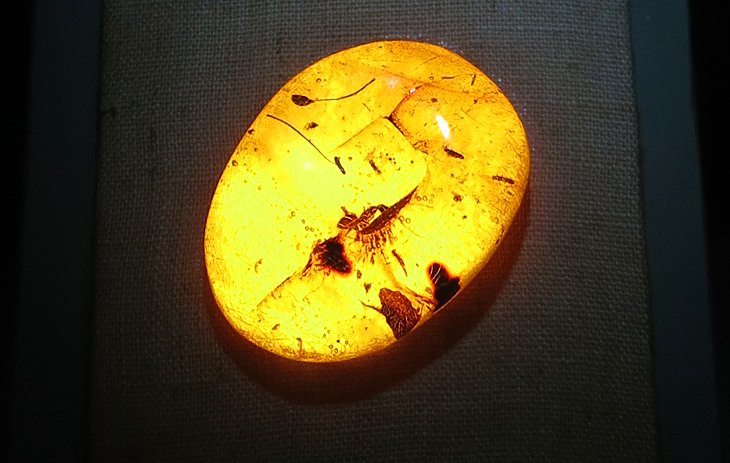
The Amber World Museum is an incredible place to see fine examples of amber and learn about this fossilized resin. Even if you have no interest in visiting museums, the visually striking displays here are worth a look.
For a very small admission fee, a knowledgeable English-speaking guide will lead you through the museum, walking you through the exhibits, which explain how amber is formed, mined, and used.
The amber pieces, which come in a variety of hues, are backlit to reveal the fossils inside, which range from ants and termites to leaves and flowers. Some of the pieces have magnifying glasses, so you can get a detailed look at the fossils. Note the curving handrail on the stairs to the second floor is made of amber pieces encased in acrylic.
The Dominican Republic is well known for amber, which here is almost always transparent, giving it a glow you don't always find in amber. You can frequently see fossils in Dominican amber, even in very small pieces.
Attached to the museum is a jewelry store where you can buy amber, as well as larimar, but there is no pressure to buy.
Address: Calle Arzobispo Meriño 452
Official site: https://amberworldmuseum.com/
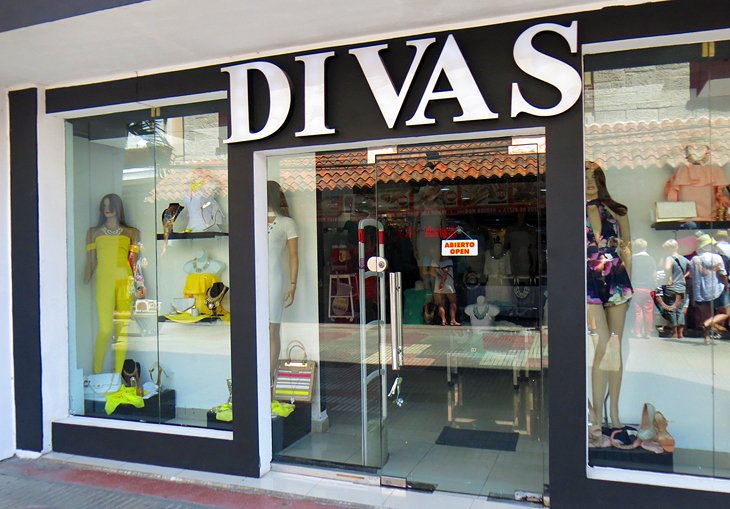
As the capital city of the Dominican Republic, Santo Domingo has some of the best shopping in the country. In the Zona Colonial is a mix of tourist oriented shops and regular shops where you can find Dominican fashions and everyday goods.
The Dominican Republic is a popular place to purchase amber and larimar, which you can either buy loose or in jewelry settings. Larimar is a semi-precious stone that comes in a variety of shades but is most commonly a pale blue. The translucent amber pieces , which are generally a golden orange color, often reveal fossils. Amber with fossils is considered the most valuable.
Many jewelry stores sell both amber and larimar, but for quality settings, you may want to stop by the first floor of the Amber World Museum , one block north of Parque Colón on Calle General Luperon, where the shop sells a large variety of amber and some larimar.
For clothing and fashion , take a walk along Calle El Conde towards Parque Independencia. You can find a variety of boutiques and reasonably priced stores all along this street and the side streets.
Outside of the Zona Colonial, Santo Domingo, the huge Agora Mall has all kinds of international shops. Swing by here if you need a break from the heat, as the entire place is delightfully chilly. It's about 30 minutes from the Zona Colonial and is on the Santo Domingo Metro System.
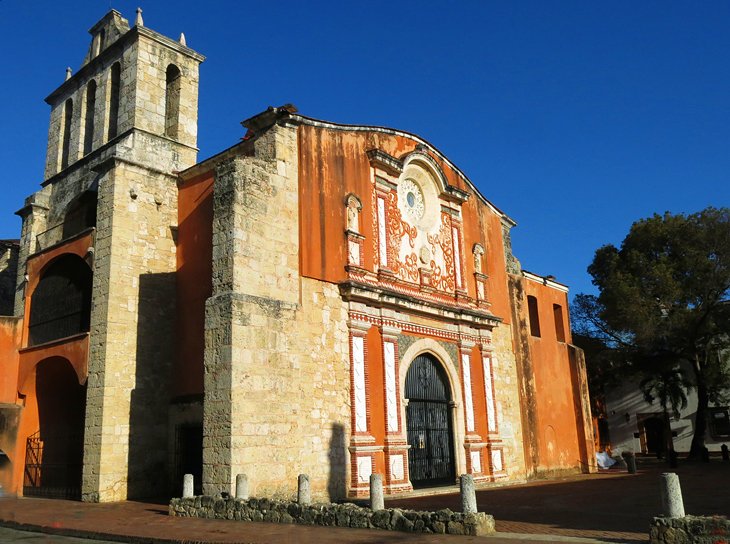
While the Catedral Primada de Américas gets all the attention as the first cathedral in the New World, the Convento de Los Dominico pre-dates the cathedral and is known as one of the oldest buildings in the Americas.
Begun around 1510 and put into use in various stages until it was finally completed in 1531-32, the convent later went on to become a teaching institution and eventually became the start of what is today the University of Santo Domingo.
The Convento de Los Dominico, with is ochre and coral façade, practically glows in the late afternoon sun, making it one of the more stunning old buildings in the city. Inside, the spectacular vaulted ceilings and ornate gold and mahogany altar are well worth a look.
Location: Padre Bellini and Avenue Duarte
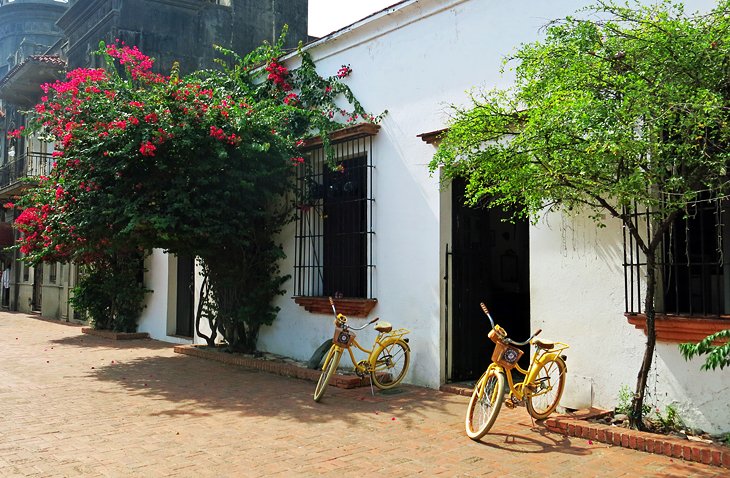
Semi-adventurous tourists can rent a bicycle or take a trikke tour to explore the streets of Santo Domingo. While it may seem daunting to make your way through an unknown city on a bicycle or scooter, the streets of Santo Domingo's Zona Colonial are almost all one way streets with only single-lane traffic, making it a delightful place to give this a try.
Most of the streets are not particularly busy, intersections are easy to navigate, and you don't have to worry about crossing multiple lanes of traffic. The main hazards are the deep gutters lining the sidewalks.
The large, wide-open space of Plaza España is a great place to try out your bike or trikke before tackling the narrower streets. From here, you can either plan out a route or simply make your way up and down the streets, which are laid out in a basic grid pattern.
Bicycle rentals are available at Zona Bici Bike Rental or Sunny Bikes RD.
Official site: https://zonabicird.com/bicisyprecios/home/
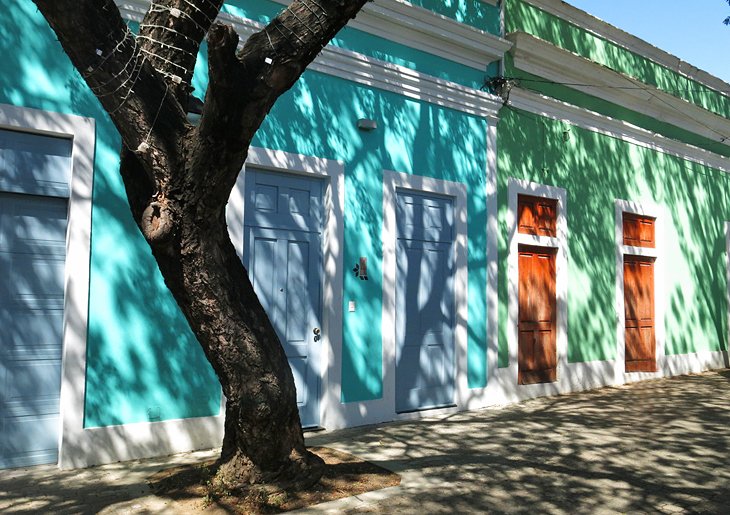
The streets are a riot of color, and the old architecture, ranging from crumbling ruins to completely restored colonial buildings, provides endless subjects for photographers. The light can be very intense at midday, but the morning and afternoon sun can be wonderful for photographing this historical area.
The Museo de las Casa Reales faces east and is best captured in the morning when it is not in shadow. The ornate façade of Catedral Primada de America, and the Convento de los Dominicos, face west, with a warm glow falling over them in the late afternoon.
Streets worth investigating with your camera include the north section of Calle Hostos, where the street curves on a hillside lined with colorful, small wooden houses. On Callejón Macorís, south of Calle Padre Billini, near Parque Duarte, you will also find a colorful row of buildings.
Particularly lovely squares are Parque Colón, with pigeons and street entertainers, and the quaint Parque Duarte, lined with old buildings, benches, and trees.
The best time to visit Santo Domingo is November through March. At this time of year, the temperatures are not too hot, and the weather is generally sunny and dry with lower humidity than the summer months.
Santo Domingo really doesn't have any spectacular beaches, so if you are craving sun and sand, consider a beach trip. One of the best is an excursion to beautiful Saona Island . This full-day tour takes you to a small island with swaying palm trees and calm, warm water where you can swim, snorkel, or just lie on the beach.
For more ideas on places to visit around the island, see our guide to the top attractions in the Dominican Republic .

More on Dominican Republic
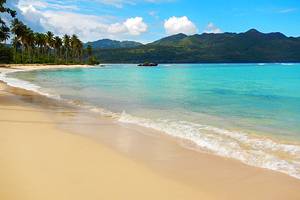

- July 7, 2017
- Colonial Zone Tour
A Tourist Guide To Zona Colonial
Zona colonial, santo domingo, dominican republic.
Zona Colonial, in English The Colonial Zone is the #1 tourist attraction in Santo Domingo . Santo Domingo is the oldest city in the New World and was founded by Christopher Columbus and his younger brother, Bartholomew Columbus in 1502, just after Christopher Columbus discovered the island of Hispaniolain in 1496 (present day Haiti and the Dominican Republic). The part of the city inhabited in the early 1500’s is now called the Zona Colonial. Zona Colonial boasts of many firsts for the New World. The first paved street, university, cathedral, castle, monastery, hospital and fortress – to name a few. With beautiful architecture and the rich history, Zona Colonial is a must see while visiting Santo Domingo. Zona Colonial has been classified as a World Heritage Site by UNESCO .
In the Zona Colonial, along with the beauty of the historical buildings, you will find: hotels, restaurants, cafes, museums, bars, shops, etc. This is just one of the reasons why it is the most visited tourist attraction in Santo Domingo. The two most famous streets in the Colonial Zone are Calle Las Damas (the street of the women) and Calle Conde. Calle Las Damas was the street the women of high society walked after church on their way to lunch. Calle Las Damas is an amazing street during the day, but it becomes even more amazing at night as the street lights turn the walls of the buildings a beautiful orange hue. With every step you take on the first paved street of the New World, you travel back deeper in time until you feel as though you are in the 1500’s walking next to Christopher Columbus.
Safe, Secure, Comfortable & English-Speaking Transfers
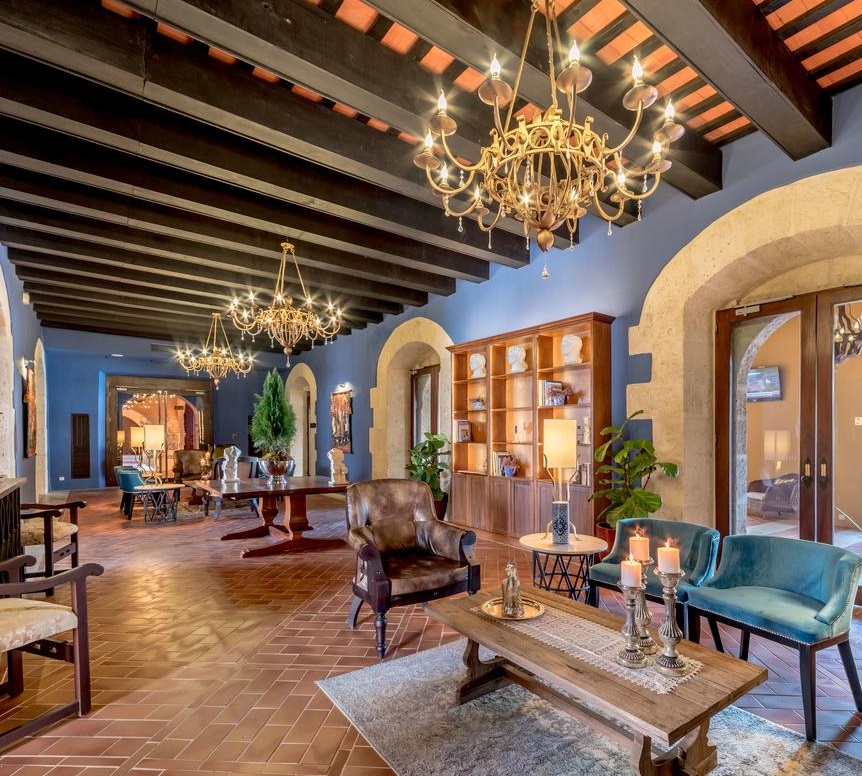
Hotels In The Colonial Zone
There are many hotels to choose from and they provide a wide range of prices from economical to elegant. What is nice about the economical hotels in this area is that they are clean and staffed with friendly people – with many speaking English. Keep in mind that these are old buildings, and, while they are clean, most rooms are small and have “Old Building” issues. Still, for the price I think they offer a great product in a great area. There are many of these hotels and with many offering different specials at different times, it is hard to recommend one specific hotel. One of the main benefits to staying in the Colonial Zone is when you walk out the door of your hotel, you don’t need to pay a taxi to take you to a location to enjoy. You are already at the # 1 tourist attraction in Santo Domingo .
On the higher end there are several hotels to enjoy, but I will talk about Hodelpa Nicolas De Ovando. This hotel has spacious guest rooms, a nice courtyard out back to enjoy the evenings, a small bar, good food for the breakfast buffet and for a dinner menu, but the best two aspects of this hotel are its history and its architecture. Nicolas de Ovando, a travelling companion of Christopher Columbus, was the 3rd governor of the Indies and this hotel used to be his home and dates back to 1502. This hotel is located on Calle Las Damas (the first paved street) in one of the first houses built, so to me there is no better place to stay to be able to immerse yourself in the culture of the oldest city in the New World. But don’t worry if the hotel is outside your budget, you can visit it and enjoy a cocktail at the bar or in the courtyard.
Things To “Do And See” in the Zona Colonial
Walking tour of zona colonial.
I highly suggest your taking the walking tour on the Colonial Zone and to make it one the first thing you do when you arrive in Santo Domingo. Once you understand the buildings and their history, you will be able to enjoy them more. For example, if you are sitting in the Spanish Square (Plaza Espana) enjoying a nice dinner at say, Pate Palo, the first restaurant in the new world and where Sir Francis Drake ate at in 1586, as you look across the square you will see a stone building, it will not just be a stone building anymore because, after taking the walking tour, you will understand this is the house of Christopher Columbus’ son, Diego Columbus. After touring this house you will have a good understanding how people lived in the time of Christopher Columbus. The walking tour of the Colonial Zone typically lasts 2 to 3 hours. If you would like help arranging a walking tour of of the Colonial Zone we can help you with this.
The Colonial Zone has been awarded the title of a World Heritage Site by UNESCO because it is home to the first university in the new world, the University of Santo Domingo (1538), the first cathedral in the new world, Cathedral Santa Maria la Menor (1512) and the first hospital of the new world, Hospital Nicolas de Ovando (1522).
The next section will talk about some of the buildings worth seeing and many of these will be included in the tour.
Buildings, Museums, and Historical Attractions in The Colonial Zone
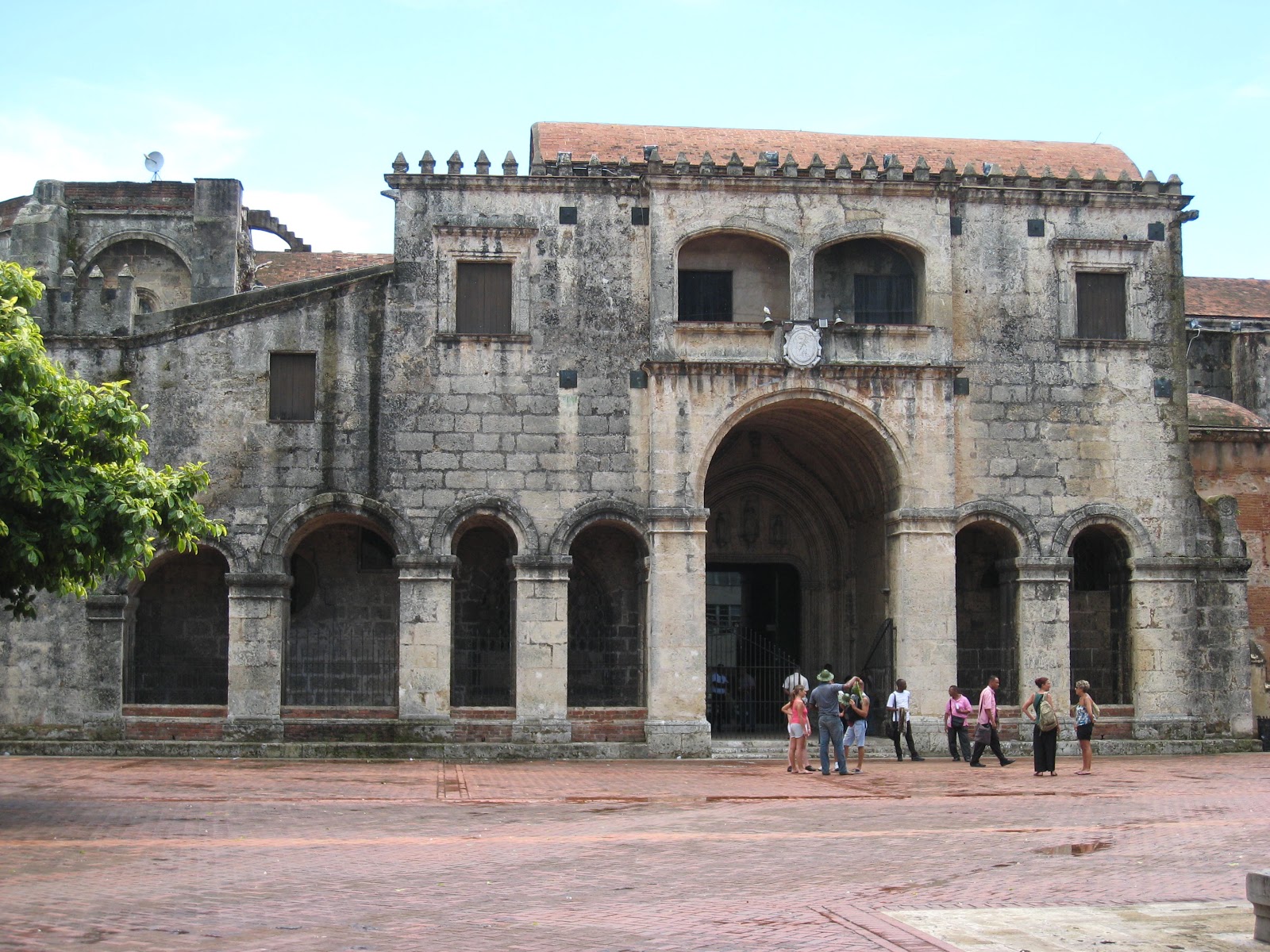
Cathedral de Santa Maria/ The Cathedral of Santa Maria
Built in 1514, it is the first cathedral of the Americas. This cathedral is an active cathedral and conducts services. This cathedral also has 12 beautiful chapels and until 1992 one of the chapels housed the remains of Christopher Columbus.
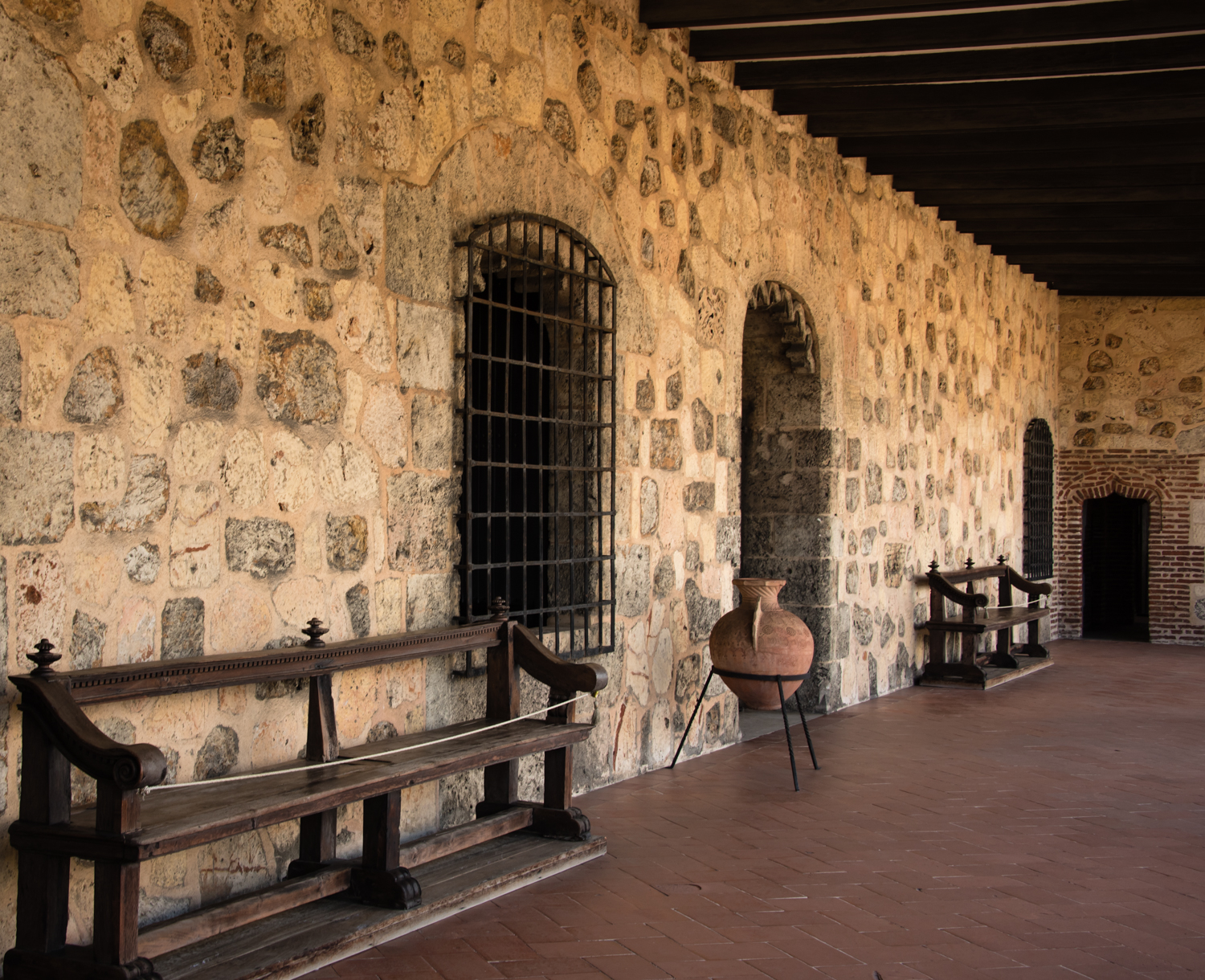
Alcázar de Colón
The house of the son of Christopher Columbus (Diego Columbus). This home has been turned into a beautiful museum with some original furnishings and some reproductions of the original furniture. Walking through this house will give you a feel for how Columbus lived in the 1500’s.
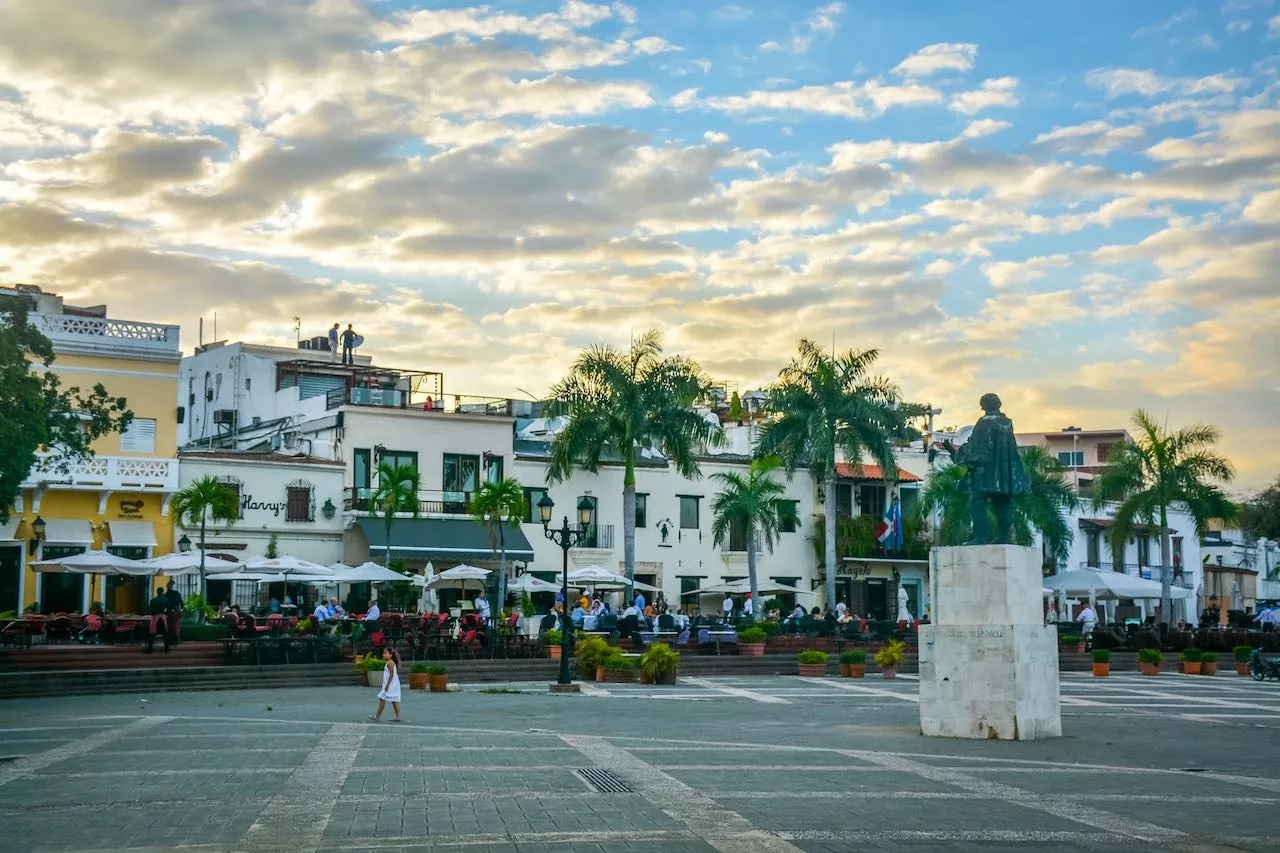
Plaza de España
The Spanish square is a large, open gathering area that on one side has 8 restaurants overlooking the square and on the other side has the Alcazar de Colon (the house of Diego Columbus, son of Christopher Columbus). The plaza is found at the end of Calle Las Damas and was the main gathering area int he times of Christopher Columbus.
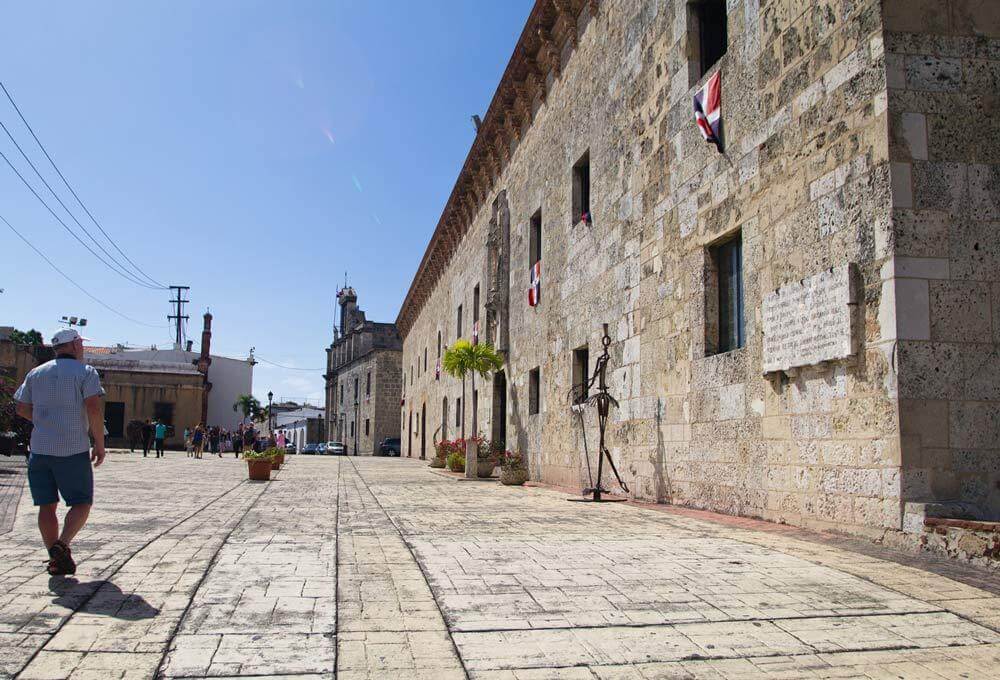
Calle Las Damas
This probably the most historically significant street in the city. It was the first paved street of the Americas and it was also the street the women of high society walked after church to attend lunch. This is why it is is called Calle Las Damas which in English means the street of the women. The street is filled with buildings from the 1500’s that are now turned into museums, hotels, restaurants, etc. Draw in the history as you walk down this street.
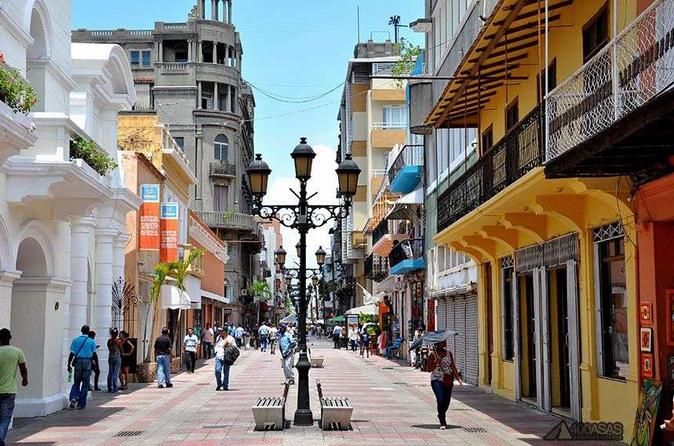
Calle Conde
This is probably the 2nd most important street in the city. This street is closed to cars and is filled with shops, cafes, restaurants, hotels, and it has a small park, Parque Colon (Colon Park) in the middle and, at the far side of this street, has the Parque Independencia (Independence Park). This street was the main commercial area in Christopher Columbus’ time.
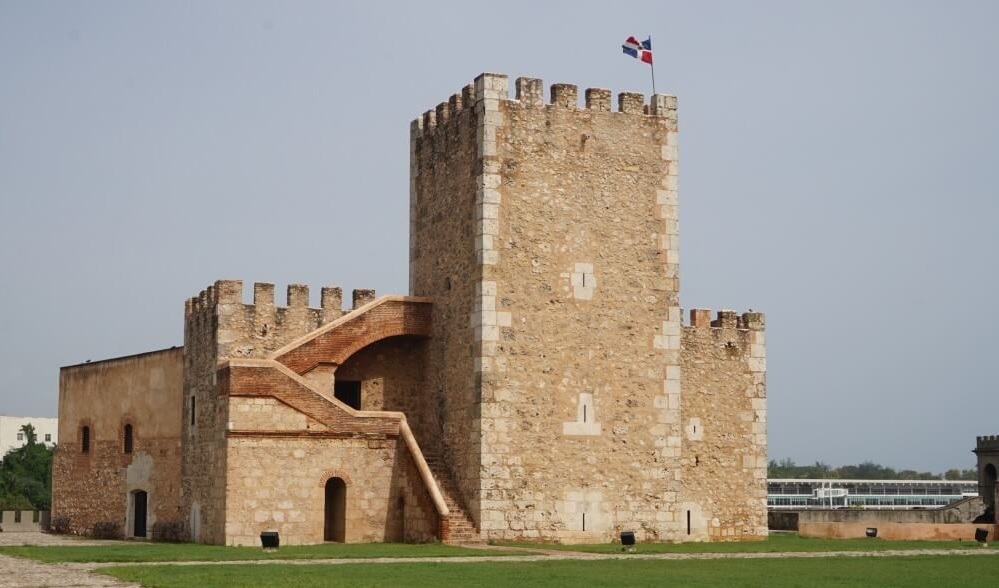
Fortaleza Ozama
See the remains of the building that housed the Franciscan fathers back in the early 1500’s and was commissioned to be constructed by Nicolas de Ovando the 3rd governor of of Santo Domingo.
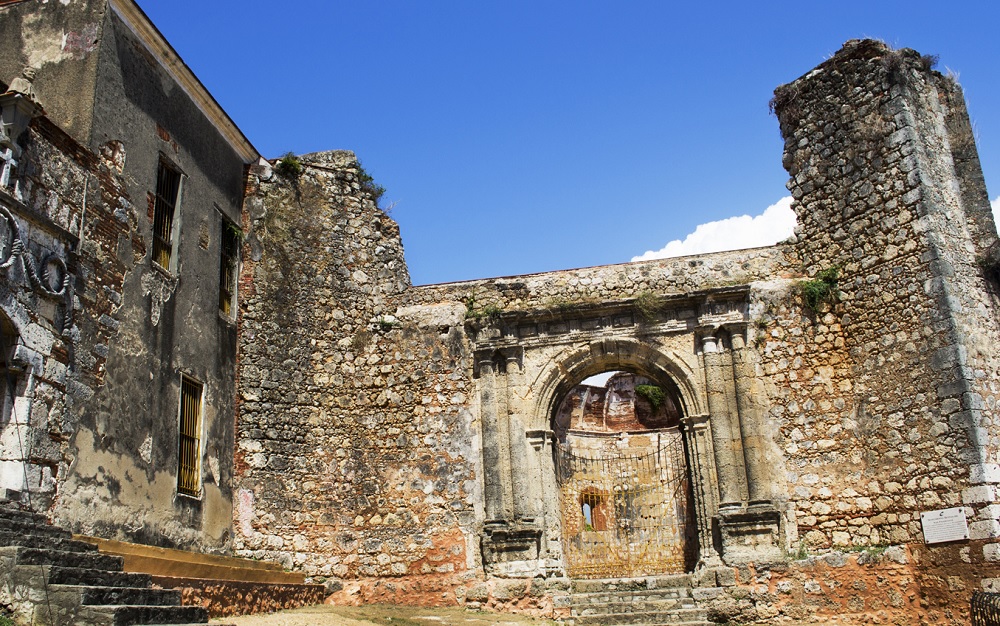
Ruins of the San Francisco Monastery
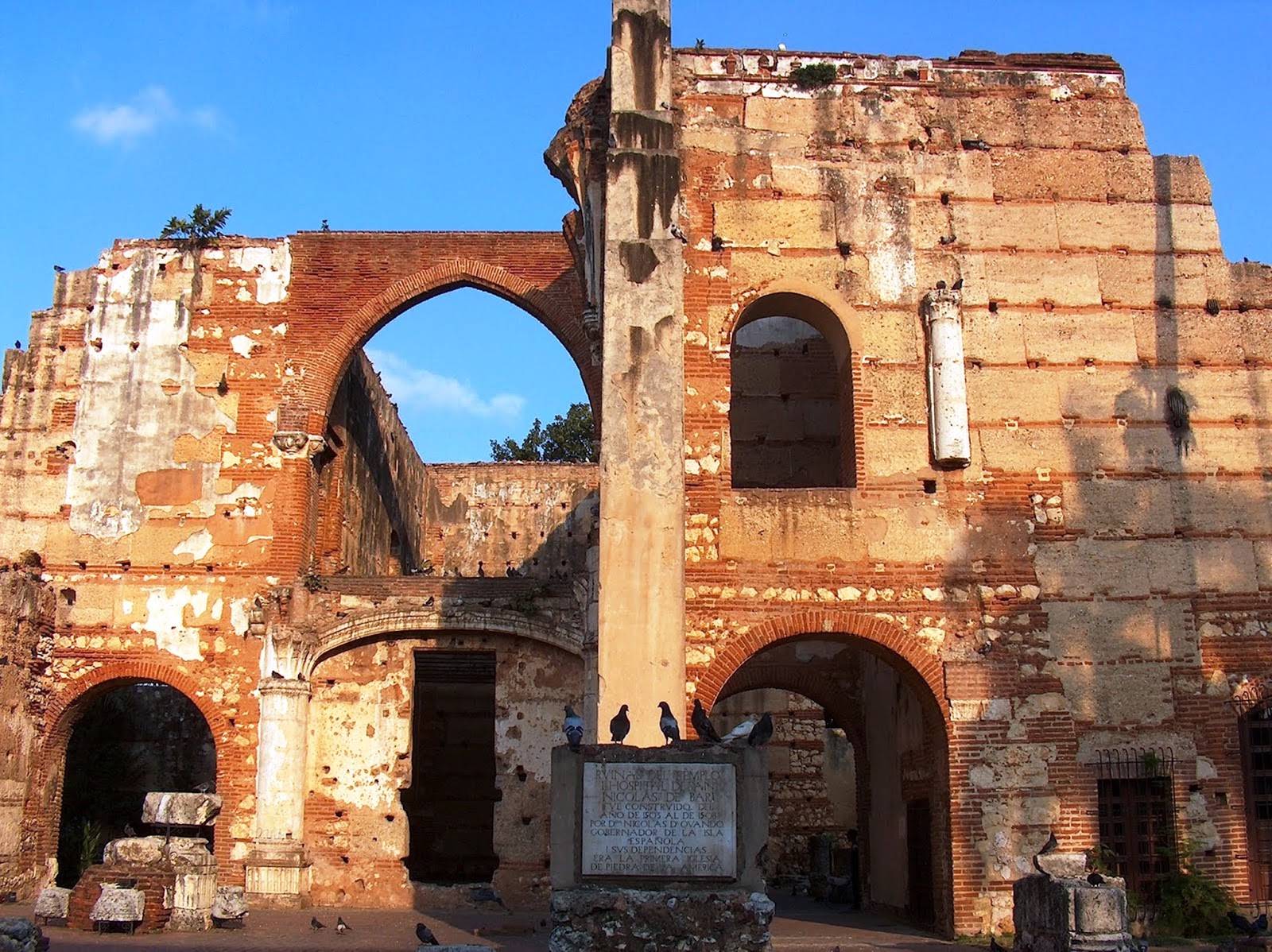
Ruins of the Hospital Nicolas de Ovando
Construction started in 1503 by the orders of the 3rd governor of Santo Domingo, Nicolas de Ovando and was completed in 1522. This hospital was one of the most modern hospitals of its time.
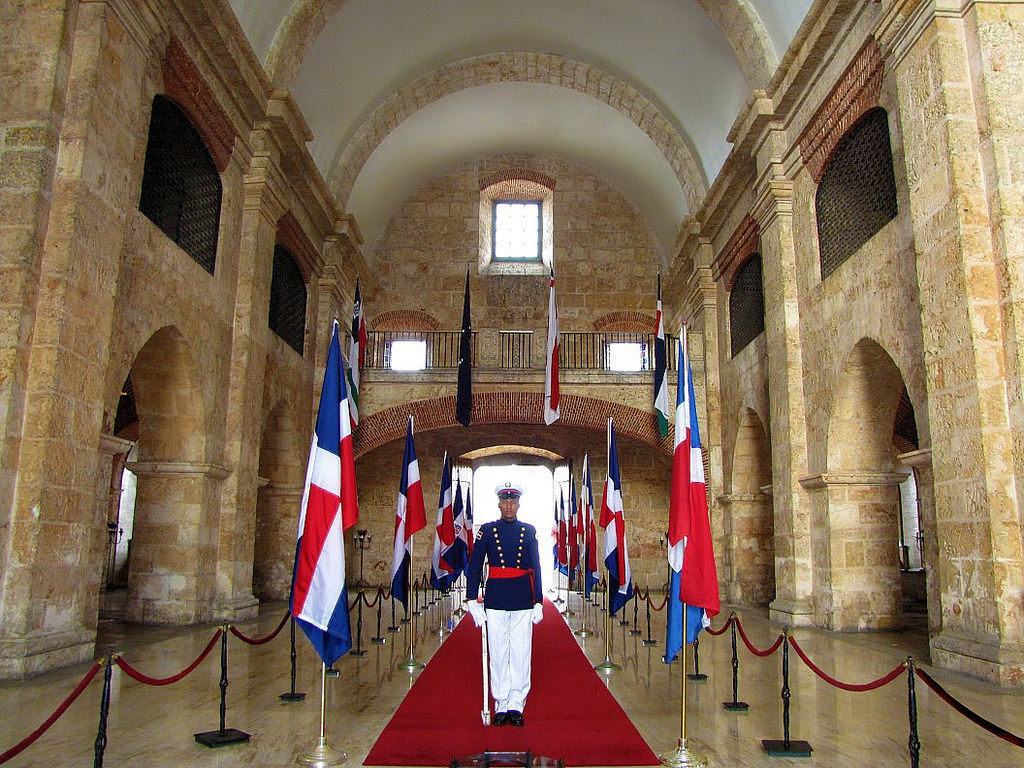
Panteon de la Patria
This building originally housed the church for the Jesuits, later turned into a mausoleum to house the remains of some of the most notable national, civilian and military heroes of the Dominican Republic.
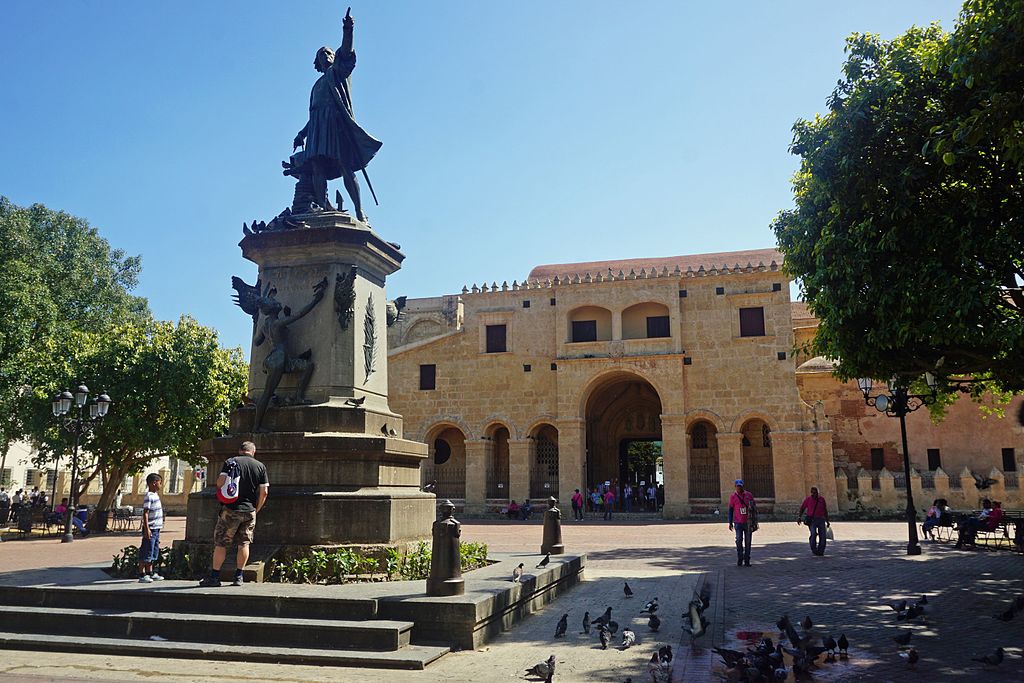
El Parque Colon
Columbus Park is located just off Calle Conde across from the Hotel Conde and bordering the Cathedral de Santa Maria, it is a great place to sit on a park bench under a tree and take a break from visiting the museums and ruins to soak in the beauty and the culture.
Restaurants, Bars, Cafes, and Nightclubs in Zona Colonial
There are many restaurants, bars, cafes and nightclubs in the Colonial Zone. I will focus on the ones that have historical significance, the ones that I have enjoyed and some that our past clients have enjoyed.
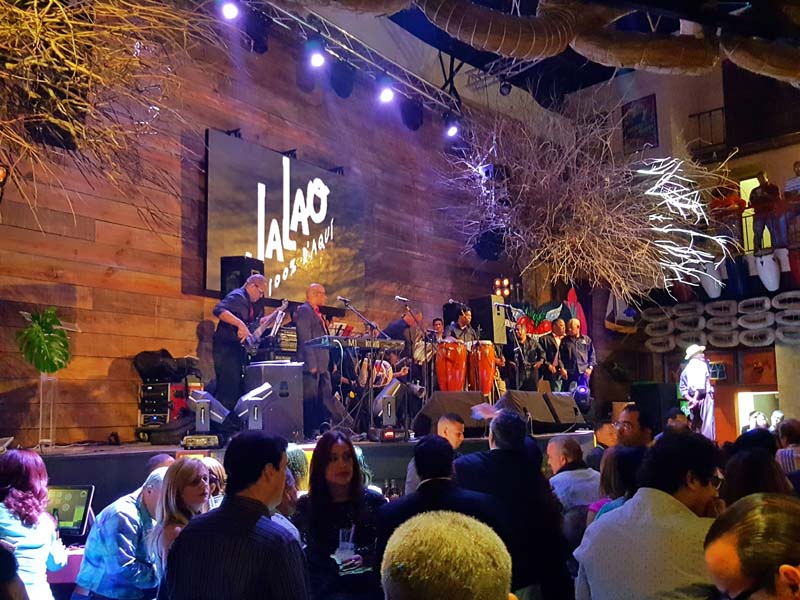
One of the newer restaurants located on Calle Conde is known for its Dominican entertainment (dancing/music) and good traditional Dominican food. Located across from the Colon Park (Parque Colon) and the 1st cathedral of the new world, the Cathedral of Santa Maria this restaurant is in the heart of the Colonial Zone. This is a great spot to try some classic Dominican food, enjoy the local singers and dancers while escaping the Dominican heat with the restaurants excellent air conditioning.
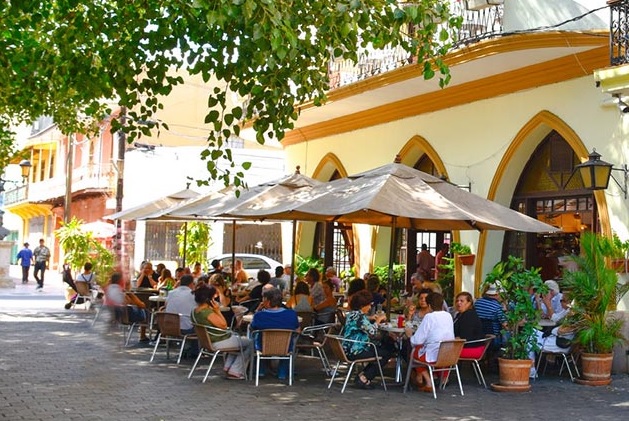
Hotel Condo Restaurant
For traditional Dominican cuisine, you can visit the first floor of the hotel Conde. This restaurant has a patio seating overlooking both Parque Calon and Cathedral de Santa Maria on Calle Conde. This is a great place for traditional Dominican food, and is also for people watching.
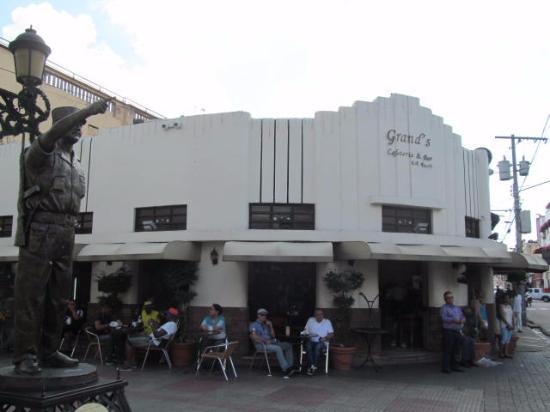
At the end of Calle Conde is a very famous café/diner named Grands, formerly Pacos. This restaurant is open 24 hours a day and is a great place to get a coffee and some breakfast to start your day off. This is not a fancy place but a regular café that on any day of the week, you will see people gathering here to enjoy a good conversation with their coffee, and Dominican style food, no matter the hour.
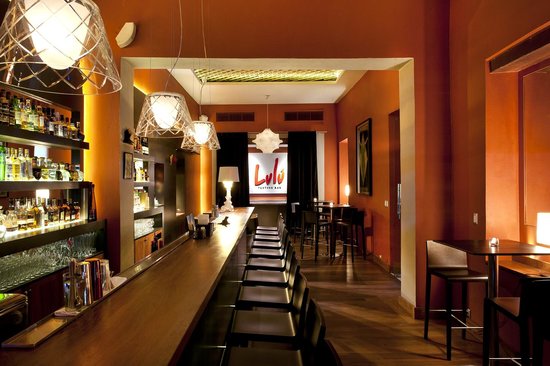
LuLus Tasting Bar
is a great place to enjoy a cocktail and dinner. It is a very trendy location that is upscale casual.
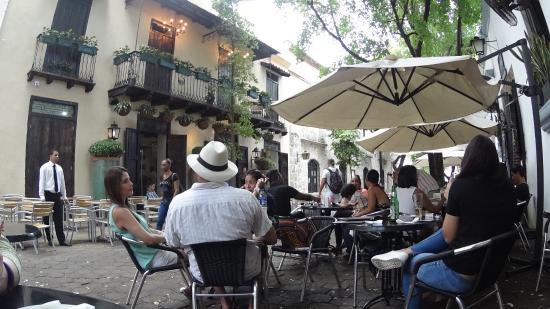
Located on Calle Conde, this Italian restaurant is an excellent location not only for food but for people watching. They have great coffee in the morning to start your day off, and their pizzas are excellent as well.
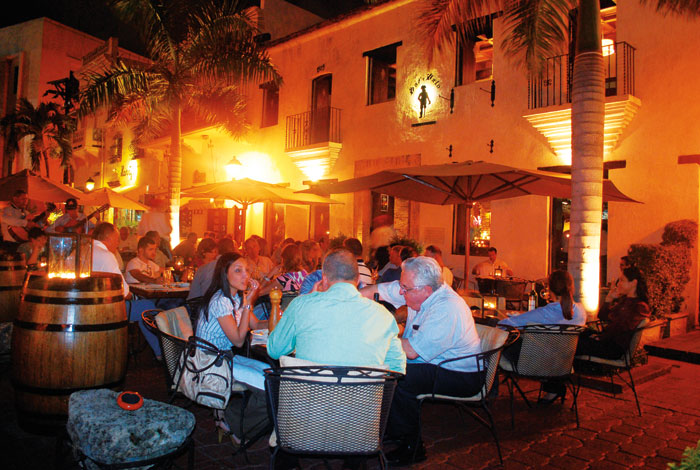
Plaza Espana Restaurants
Overlooking both Plaza Espana (Spanish Square) and Alcázar de Colón (Deigo Columbus’ house) there are 8 restaurants located in a row. These restaurants are housed in buildings that were originally used as warehouses to store the goods such as tabacoo that were to be send back to Spain. Each of these restaurants has a menu located in front of the restaurant in Spanish and English so you can reveiw the menu before entering. All 8 restaurants are elegant and the longest running restaurant in the New World is one of these 8 – Pate Palo (the wooden leg) which is a 500-year-old restaurant that Sir Francis Drake once ate at in 1586. Whether you eat at Pate Palo or one of the other 7, you can’t go wrong choosing one of these.
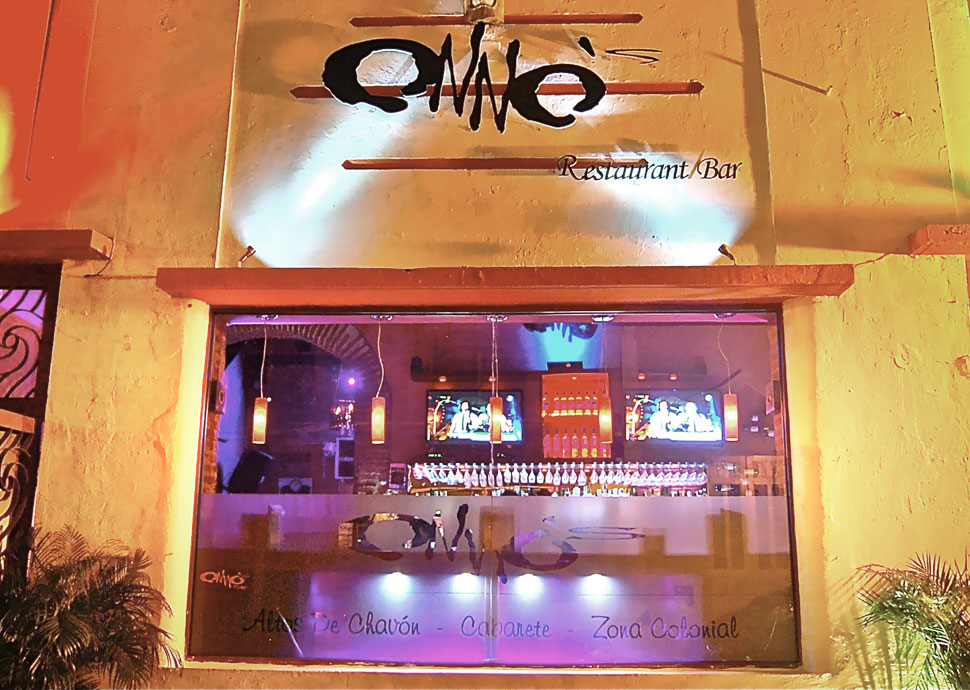
Is a nightclub located in the heart of the Colonial Zone where you can hear the countries favorite music (Bachata, Merengue, and Salsa) to the early hours of the morning.
As I had mentioned before there are many more restaurants, cafes, bars and nightclubs to choose from but I wanted to give you a list of what we consider the popular choices. While walking around you will see many others, if you see one you like, just go in and enjoy.
With the Zona Colonial being the #1 tourist attraction in Santo Domingo make sure you start here and then if you have the time you can see more of Santo Domingo. We offer an English speaking day tour of Santo Domingo that includes the Zona Colonial along with other sites and you can learn more about what else Santo Domingo has to offer as well by reading our Guide To Santo Domingo .
Reserve Your Santo Domingo Airport Transfer With The # 1 Rated Taxi Company On TripAdvisor
Safe, secure, comfortable, english-speaking, related posts.
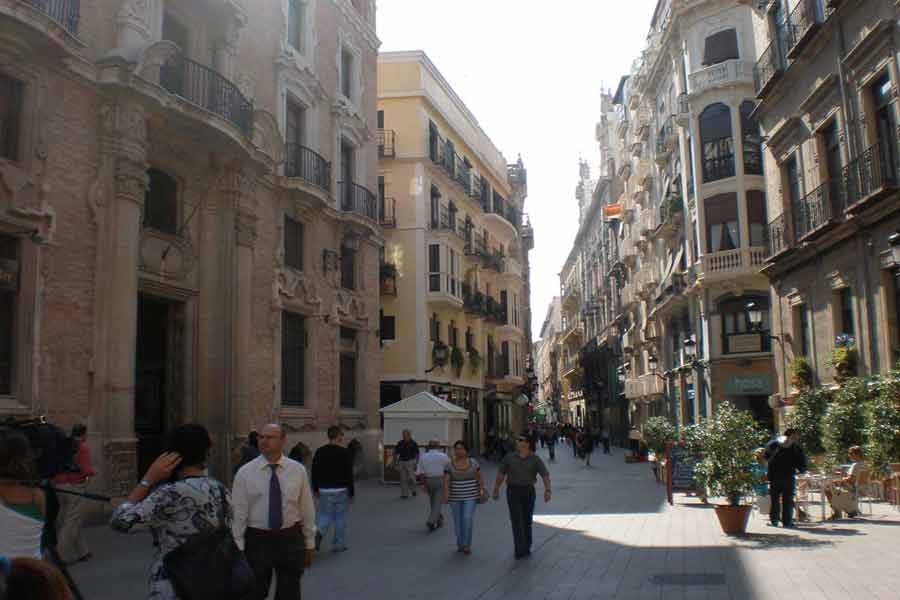
This is a compilation of Santo Domingo Attractions (restaurants, things to do, things to see,…
- previous post: A Tourist Guide To Santo Domingo Attractions

We have received your request correctly.
You will receive an email with a summary of your bookings.
Can't find it? Leave us your email and we'll send you a summary of your bookings.
Free Walking Tour of Ciudad Colonial
- 9.10 / 10 686 reviews | 9,743 travellers Osvaldo was very attentive and informed us very well during the tour. He also provided additional information that made the tour more enjoyable. 10 Jose Gregorio
- X (Twitter)
Delve into the colonial history of the Dominican Republic on this free walking tour of Santo Domingo's Ciudad Colonial and discover its most emblematic monuments.
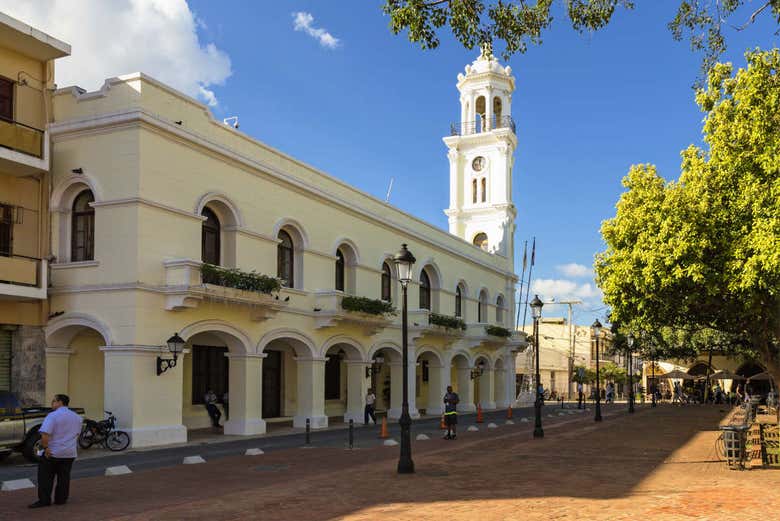
After meeting up at the agreed time at the Museum of the Royal Houses, we'll begin our free walking tour of Santo Domingo's Ciudad Colonial , or "Colonial City".
The first stop on our guided tour will be the ruins of the Monastery of San Francisco , where we'll learn all about the history of the monastery, considered to be the oldest in the Americas.
We'll then continue onwards to the ruins of the San Nicolás de Bari Hospital . Built at the beginning of the 16th century, this is recognised by UNESCO as being the oldest hospital in the Americas .
Next, we'll make stops to admire the façade of the Church and Convent of the Dominican Order and the architecture of the Cathedral of Santa María la Menor , a beautiful fusion of Gothic, Mudejar, Renaissance and Plateresque styles.
Having strolled past the Palacio Consistorial, we'll reach the lively city square known as Parque Colón , where our hour-long free walking tour of the Ciudad Colonial will end.
This free walking tour cannot be booked for groups larger than 6 people.
More Information
The activity takes place with a guide that speaks in English.
English speaking guide.
Not included
When to book.
You can book up until 24 hours before the activity as long as there are still places. Book now to guarantee your spot.
Type of voucher
Electronic. Show the voucher on your phone.
Accessibility
Wheelchair accessible. This must be indicated in the reservation. An accompanying person is required.
Sustainability
All services published on Civitatis are carried out in accordance with our Sustainability Code .
Our providers commit to:
- Provide a safe and satisfying experience.
- Reduce, reuse, recycle.
- Incorporate eco-conscious technologies.
- Uphold fair employment standards.
- Foster the growth of local communities.
- Preserve the integrity of local culture.
- Safeguard both cultural and environmental heritage.
- Ensure ethical treatment of animals.
- Operate with honesty and transparency.
- Encourage sustainable behaviors among customers and staff.
This particular activity contributes as follows:
- No printing of documentation required.
Kayoe Excursiones Show more
Corporate name: GERALDIN BIDO PEGUERO
Not permitted.
Frequently asked questions
Q - Why do this activity with Civitatis?
A - At Civitatis we guarantee the best quality and prices, click here if you want to know how we select our activities .
Q - How to book?
A - To reserve the activity, choose the date and complete the form on this page. You will receive your confirmation immediately.
Q - Is a minimum number of participants required?
A - This activity requires a minimum of 5 participants. Should this number not be reached, we'll get in touch with you to offer alternatives.
If you have any other questions please contact us.
Free cancellation
Meeting point, where does the activity end.
Museum of the Royal Houses
Parque Colón.
You may also be interested in
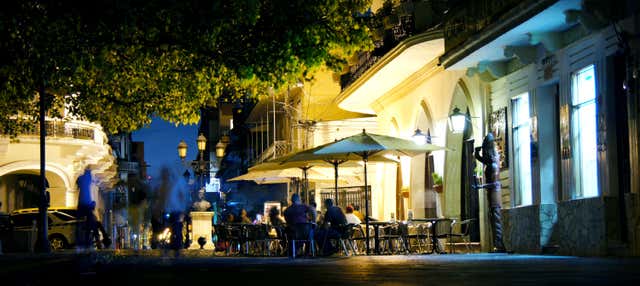
Santo Domingo Pub Crawl
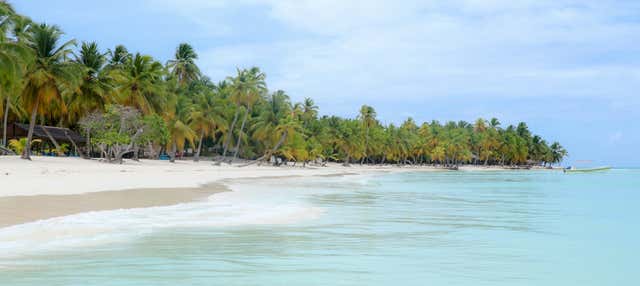
Saona Island Catamaran Tour
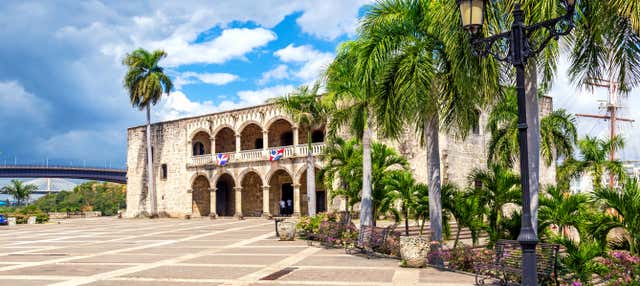
Ciudad Colonial Guided Visit
Login to add activities to your favorites and access them from any device
This site is reCAPTCHA protected and Google's privacy policy and terms of service apply.
Basic information regarding personal data protection
Person responsible for the processing: CIVITATIS TOURS, S.L. (CIVITATIS). Purpose: Provision of the services requested; Sending commercial communications about CIVITATIS products and services, for which commercial profiles of our customers may be drawn up; Sending surveys in order to assess the services offered and their degree of satisfaction, as well as the publication of opinions about the service received; Compliance with accounting, legal, fiscal and administrative obligations; Publication of customer images and processing of data for statistical purposes. Rights: You have the right to access, rectify and delete data, to limit its processing, to oppose its processing and to its portability. Additional Information: You can consult additional information on Data Protection in the General Terms and Conditions .
Log in to rate the opinions of other travelers

Exploring the Historic Zona Colonial in Santo Domingo – A Guide to the Colonial Zone

via @bobbyfingers
The Zona Colonial in Santo Domingo, also known as the Colonial Zone, is a beautifully preserved historic neighborhood located in the city of Santo Domingo, Dominican Republic. Declared a UNESCO World Heritage Site in 1990, the Colonial Zone makes for a captivating destination for tourists looking to immerse themselves in the rich history and culture of the Dominican Republic.
Walking through the streets of the Zona Colonial, you will be transported back in time to the first European settlement in the Americas. The old city walls, narrow cobblestone streets, and charming colonial-style buildings give it a unique atmosphere that can be described as a glimpse into the past. You can’t help but be enchanted by the beauty and grandeur of the historical treasures that are scattered throughout the area.
One of the best ways to explore the Zona Colonial in Santo Domingo is by foot. It’s a compact area, so it’s easy to navigate and stroll around. You can also rent bicycles or take guided tours for a more informative experience. If you prefer, there are buses and private taxis available that can take you on a direct road-trip to the Zona Colonial.
As you wander through the streets, you’ll come across the Catedral Primada de America, which is the first cathedral in the Americas. Its stunning architecture and intricate details will leave you in awe. The cathedrals and churches in the Zona Colonial are a photographer’s dream, with their picturesque facades and beautiful interiors.
The Zona Colonial is also a great place to experience the vibrant Dominican culture. There are plenty of bars, restaurants, and cafes where you can enjoy a delicious meal or sip on a refreshing cocktail. You can even find boutique hotels and shops that offer unique souvenirs and artisanal products.
Nowadays, the Zona Colonial in Santo Domingo is not only a popular tourist spot but also a place where people live and work. It’s a thriving neighborhood with families, businesses, and schools, giving it a vibrant and lively atmosphere. If you’re looking for an alternative to the bustling city life, the Zona Colonial offers a comfortable and casual ambiance that allows you to relax and enjoy your time.
When visiting the Zona Colonial, there are a few tips to keep in mind. It’s recommended to wear comfortable shoes as you’ll be doing a lot of walking. The best time to visit is during the morning or late afternoon when the weather is cooler and the crowds are smaller. Also, be sure to ask the locals about their favorite hidden gems and secret spots, as they can offer valuable insights into the city’s history and culture.
In conclusion, the Zona Colonial in Santo Domingo is a must-visit destination for anyone interested in exploring the historical and cultural treasures of the Dominican Republic. Whether you’re a history enthusiast, a photographer, or simply looking for a unique travel experience, the Zona Colonial will not disappoint. Its captivating charm, breathtaking architecture, and vibrant atmosphere make it a place that you’ll never forget.
Exploring the Historic Zona Colonial in Santo Domingo
If you’re planning a trip to Santo Domingo, one of the must-visit places is the Historic Zona Colonial in Santo Domingo. This area is full of history and is a UNESCO World Heritage site. Here’s a guide to help you explore and make the most of your visit.
Step Back in Time
Walking through the Zona Colonial is like stepping back in time. It’s like exploring a small European city in the heart of America. The buildings, streets, and walls all have a rich history and tell stories of the early settlement of Santo Domingo.
Discover the Hidden Gems
As you explore the Zona Colonial, you’ll come across many hidden gems. These include beautiful houses, small museums, and serene plazas. One of the most famous sites is the Alcazar de Colon, the former residence of Christopher Columbus’ son, Diego. Another notable spot is the Fortaleza Ozama, the oldest military fortification in the Americas.
Take a Guided Tour
To get a deeper understanding of the history and significance of the Zona Colonial in Santo Domingo, consider taking a guided tour. There are many knowledgeable guides who can show you around and provide interesting insights into the architecture, art, and culture of the area. They can also take you to some of the lesser-known corners and share personal stories and anecdotes.
Relax and Enjoy the Atmosphere
One of the best things about the Zona Colonial is its relaxed and laid-back atmosphere. There are plenty of cafes, restaurants, and bars where you can sit back, relax, and soak in the surroundings. You can also enjoy live music performances, both traditional and contemporary, that take place in some of the plazas or small venues throughout the area.
Get Creative and Explore
Another way to explore the Zona Colonial is to get creative. Bring a sketchbook or a camera and capture the beauty of the old buildings, colorful streets, and charming squares. The Zona is a photographer’s paradise, with endless opportunities for capturing stunning shots. Don’t forget to explore the side streets and alleyways, as they often hide unique architectural features and interesting details.
Eat Like a Local
One of the best ways to experience the local culture in the Zona Colonial in Santo Domingo is through its food. There are plenty of restaurants serving traditional Dominican cuisine, as well as international options for those looking for something different. Don’t miss the chance to try local specialties like mofongo, sancocho, or tostones. And if you’re up for it, visit one of the lively bars or clubs for a taste of the vibrant nightlife.
Plan Your Visit
If you’re planning to visit the Zona Colonial, here are a few tips to make your trip easier and more enjoyable:
- Wear comfortable shoes, as you’ll be doing a lot of walking
- Bring a hat and sunscreen, as it can get hot and sunny
- Take a raincoat or umbrella, as the weather can be unpredictable
- Consider taking a private tour for a more personalized experience
- Use public buses or taxis to get around the city
- Make sure to visit the Zona Colonial during the day, as it can get quiet and less safe at night
Now that you have a guide to the Historic Zona Colonial in Santo Domingo, you’re ready to explore this special part of the city. Get ready to be amazed by the rich history, beautiful architecture, and vibrant atmosphere!
A Guide to the Colonial Zone
The Colonial Zone is located in Santo Domingo, the capital city of the Dominican Republic. It is a historic area that holds important buildings, museums, and sites that are worth visiting.
When visiting the Colonial Zone, there are various tours available that will take you down the vibrant streets and show you the historical sites of the city. One of the main attractions is the Catedral Primada de América, the first cathedral built in the Americas.

via @mafe.alarcon96

via @gemas_creaciones_fotograficas

Another must-visit is the Alcázar de Colón, a house that belonged to Christopher Columbus’ son, Diego Colón.

Exploring the Colonial Zone on foot is a great way to travel back in time and experience the early years of the country’s founding. The zone is pedestrian-friendly and has many traditional and historical houses that are now museums, such as the Museum of the Royal Houses.
One of the special places to visit is the Basílica Catedral Metropolitana Santa María de la Encarnación, which is the biggest cathedral in the country.

You can also stroll down the Calle El Conde, a famous street filled with shops, restaurants, and street vendors selling local and traditional food.

In summary, the Zona Colonial in Santo Domingo offers a rich historical and cultural experience that will take you back in time. With its vibrant streets, important landmarks, and traditional food, it’s a must-visit for any traveler arriving in the Dominican Republic.
13 reasons Why You Should Visit the Zona Colonial in Santo Domingo
- The Zona Colonial is a small city within a city. It is the oldest neighborhood in Santo Domingo and is surrounded by impressive walls that were built in the 16th century.
- The Zona Colonial has a well-planned layout with various streets, plazas, and cute little alleys to explore. It is often described as a labyrinth, which adds to its captivating charm.
- It is home to some of the best-preserved colonial architecture in the Americas. The buildings in the area are magnificent and each one has its own unique history.
- You can spend hours wandering the streets and exploring the many museums, galleries, shops, and restaurants. There is always something happening in the Zona Colonial, making it a vibrant and lively place to visit.
- Since it is the birthplace of the Dominican Republic, the Zona Colonial holds significant historical importance. The first cathedral, hospital, and university of the Americas are all located here.
- Don’t miss the chance to visit the Alcazar de Colon, the former home of Christopher Columbus’ son, Diego. It is a fascinating museum that showcases what life was like during the colonial period.
- Both the Dominican Republic and the United States have a shared history, and this can be seen in the Zona Colonial. The importation of sugarcane, which was predominantly grown in the Dominican Republic, played a significant role in the American South’s plantation economy.
- The Zona Colonial is a great place to shop for souvenirs and local crafts. There are many hidden gems and unique boutiques where you can find one-of-a-kind items.
- If you are interested in food, the Zona Colonial is the place to be. There are numerous restaurants and cafes serving delicious Dominican cuisine. Be sure to try some of the country’s traditional dishes, such as sancocho and mofongo.
- Guided tours are available for those who want to learn more about the history and culture of the Zona Colonial. Local guides can provide valuable insights and take you to places that you may otherwise miss.
- Visiting the Zona Colonial is an important part of understanding Dominican history and culture. It allows you to see firsthand how the colonial period shaped the country and influenced its development.
- The Zona Colonial is conveniently located in the heart of Santo Domingo, making it an easy stop for tourists. It is well-connected by taxis and public transportation, and there are plenty of hotels and accommodations in the area.
- Exploring the Zona Colonial is a breathtaking experience. The narrow cobblestone streets, colorful buildings, and beautiful plazas create a unique atmosphere that is unlike any other.
What is the Zona Colonial?
The Zona Colonial, also known as the Colonial Zone or Ciudad Colonial, is the historic center of Santo Domingo, the capital of the Dominican Republic. It is a UNESCO World Heritage Site and one of the oldest European settlements in the Americas, with buildings dating back to the 16th century.
What are the must-visit spots in the Zona Colonial?
The Zona Colonial is full of historical treasures and vibrant streets. Some of the must-visit spots include the Alcázar de Colón, the first cathedral of the Americas, the Ozama Fortress, the Monasterio de San Francisco, and the Puerta del Conde. Each spot offers a unique and fascinating glimpse into the city’s colonial past.
Are there any free activities available in the Zona Colonial?
Yes, there are plenty of free activities you can enjoy in the Zona Colonial. You can take a stroll along the cobblestone streets, admire the colonial architecture, and visit the many public parks and plazas. There are also several museums and galleries that offer free admission at certain times.
Are there guided tours available in the Zona Colonial?
Yes, there are guided tours available in the Zona Colonial. It is highly recommendable to take a guided tour to fully appreciate and understand the history and significance of the site. You can find guided tours that cater to different interests and preferences, including walking tours, bus tours, and even horse-drawn carriage tours.
What are the alternative transportation options for traveling around the Zona Colonial?
If you prefer not to walk, there are alternative transportation options available in the Zona Colonial. You can rent a bike or take a guided bike tour to explore the area. There are also small tourist trains and buses that offer hop-on, hop-off services to various attractions within the zone.
What is your reaction?
Palmchat: national bird of the dominican republic – amazing facts and characteristics, dominican mango and mango festival in bani, you may also like.

Local Flavor Meets Fun: Exploring Casino in Sosúa Dominican Republic

Unveiling 10 Dominican Wedding Traditions Customs and Rituals

Why Are So Many Baseball Players From Dominican Republic
Comments are closed.
More in: Blog

Explore Gambling in the Dominican Republic 2024

What Donald Trump talks about dominicans?

Getting married in the Dominican Republic. What You Need to Know Before Tying the Knot!
Dominican republic currency exchange rate.
Currency exchange rates in DOP on September 9, 2024

Reasons Why People Love Cabarete, Dominican Republic
Welcome back to my channel and welcome to Cabarete, Dominican Republic! With a population of around 15,000, Cabarete is a hidden gem that has captured the hearts of many. In this article, we will explore the 10 compelling reasons why people are drawn to this vibrant coastal town. 1. Kitesurfing at Kite Beach Cabarete is renowned worldwide as a top kiteboarding destination, and the epicenter of the action is Kite Beach. Just a short 20-minute walk along the beach from the town center, Kite Beach offers a unique vibe. In the mornings, it’s a tranquil spot with walkers, runners, and […]

When envisioning a casino getaway, one often conjures images of slot machines chiming and the shuffle of cards. However, the city of Sosua in the Dominican Republic offers an online casino experience that transcends the confines of the physical casino floor. Situated against the backdrop of the sparkling Caribbean shores, Sosua is a destination that seamlessly blends the vibrancy of local culture with the excitement of online casino entertainment. If you are tired of the white-sand beaches of Cabarete and you want to shake a portion of excitement, the best choice is to visit a casino in Sosua Dominican Republic. […]

Is Cabarete Safe for Tourists?
Are you looking to have a fun and relaxing getaway at one of the best tourist destinations in the world? Cabarete is the go-to place for you. With the perfect blend of beautiful views, a lively nightlife and an exquisite local cuisine, you can be sure to have the best time of your life. Cabarete is generally considered safe for tourists, however you can never be too cautious. Hence, in this article we’ll be considering this very important topic. Also, we’ll provide you with safety tips to ensure nothing disrupts your amazing adventure. Overview of Cabarete Cabarete is a picturesque […]

The Ultimate Guide to SIM Card for Dominican Republic in 2024
Heading to the Dominican Republic and wondering about connectivity without the hefty roaming fees? This guide details the process of obtaining a SIM card for Dominican Republic in 2024, ensuring you stay online effortlessly. Introduction If you are familiar with traveling internationally, you should know that it is never a good idea to travel with the hope of using data roaming services. Besides being overly costly, you get limited access to fast data. Not so shocking, this is not any different from the Dominican Republic. The fact that you will also need the internet to get a lot of things […]

Tipping In Punta Cana and Dominican Republic: A Comprehensive Guide
A visit to Punta Cana, one of the Dominican Republic’s most charming towns, can be a one-of-a-kind experience if you know your way around. Understanding the popular culture of Tipping in this country is one major concern for many. Since this culture plays a big role in determining how fun and relaxed your vacation to the Dominican Republic will be, it is a vital ground to learn. Knowing when, how and why you should tip at different places in Punta Cana and the Dominican Republic is important. Not to mention, it is also key to know what kind of currency […]

Can You Drink Tap Water in Dominican Republic and Punta Cana?
A Traveler’s Guide to Water SafetyWhen I first set foot on the sun-kissed beaches of the Dominican Republic, I was captivated by its beauty. As a seasoned traveler, my excitement was mingled with the usual concerns—particularly about water safety. And the most important question I’ve been asking myself is: Can I Drink Tap Water in Dominican Republic and Punta Cana? In the Dominican Republic and its popular tourist hub, Punta Cana, it’s advisable not to drink tap water. Instead, visitors should opt for bottled or purified water. While the tropical allure is inviting, it’s crucial to take this precaution to […]

Sargassum in the Dominican Republic everything you need to know
The turquoise waters and pristine beaches of the Dominican Republic have long been a draw for tourists seeking paradise. But in recent years, a brown tide has disrupted this idyllic picture: Sargassum seaweed. This influx of free-floating algae has become a growing concern, impacting the country’s tourism, environment, and local communities. These free-floating mats of algae have become a growing concern for both tourists and locals. This is why we believe that understanding Sargassum, its prevalence in the Dominican Republic, and its impact on various aspects of life will for both visitors planning their dream vacation and residents navigating the […]

When it comes to weddings, every culture has its own unique approach and traditions. The Dominican Republic is no exception. The wedding customs and rituals in this Caribbean country are a wonderful blend of local, ecclesiastical, and cultural influences. If you’re getting married in the Dominican Republic or simply want to learn more about the fascinating Dominican wedding traditions, you’ve come to the right place. And of course don’t forget to read 2 of our great articles: Dating In The Dominican Republic How to get married in Dominican Republic In this article, we’ll take a closer look at 10 traditional […]

Discovering that not every Latin-American country views soccer as the holy grail of sports might be a quite shocking revelation. As a result of the amount of following the sport generates from countries like Brazil, Argentina, Colombia, and other Latin countries, a lot of people expect the Dominican Republic to follow in the same suit. However, they veer from this accepted continental norm and instead adopt baseball as the major sport of the country. Here, we will go into the hows, whys, and whats of baseball players from the Dominican Republic. So, follow along to stay informed. How Many Baseball […]

5 Best Golf Hotels in Punta Cana with Casinos
You can hardly talk about the Dominican Republic without mentioning Punta Cana. This island is a special place for individuals who love premium comfort with a good mix of relaxation and fun. Consequently, it is a place where playing golf and trying your luck in games come together, which really makes your vacation exciting. If you are paying this warm town a visit, this content is for you. Here, we will share reviews from our exploration of the best golf hotels in Punta Cana with casinos. You will also learn that there is more to vacations than lying down on […]

Gambling in the Dominican Republic, encompassing a diverse array of casinos and gaming experiences, has become a thriving facet of the nation’s entertainment landscape. From the early days of informal betting to the sophisticated establishments of today, the country boasts a rich history of gaming. Nestled within this dynamic milieu is the presence of pixbet, a key player adding an extra layer of excitement to the Dominican Republic’s gambling scene. As players seek their fortunes, the fusion of traditional and modern gaming experiences contributes to the unique allure of the Dominican Republic. The significance of gambling extends beyond entertainment; it […]
- The most necessary
- Best Golf Courses
Latest Posts

Want to share your culture with travelers from all the world?
Others cities to visit after santo domingo, free walking tour near santo domingo.
- Free walking tour in Havana
- Free walking tour in Panama City
- Free walking tour in Ottawa
- Free walking tour in Chicago
- Free walking tour in Charlottetown
- Free walking tour in Guadalajara
- Free walking tour in Arequipa
- Free walking tour in La Paz
- Free walking tour in Sucre
- Free walking tour in Los Angeles
- Free walking tour in San Cristóbal de La Laguna
- Free walking tour in Santa Cruz de Tenerife
- Free walking tour in Las Palmas de Gran Canaria
- Free walking tour in Mendoza
- Free walking tour in Valparaíso
- Free walking tour in Reykjavík
- Free walking tour in Aveiro
- Free walking tour in Vigo
- Free walking tour in Santiago De Los Caballeros
- Free walking tour in Puerto Plata
- Free walking tour in Baracoa
- Free walking tour in Santiago de Cuba
- Free walking tour in Holguin
- Free walking tour in Taganga

COMMENTS
Tour Duration: 2 Hour (s) Travel Distance: 2.5 Km or 1.6 Miles. view all. Self-guided walking tour: Colonial Architecture Tour in Santo Domingo, Dominican Republic. The detailed walk route map can be downloaded to your mobile device for turn-by-turn travel directions.
Santo Domingo Zona Colonial Walking Tour. La Zona Colonial is the historic central neighborhood of the Dominican Republic's capital, Santo Domingo. The Colonial Zone dates back to 1496, making it the oldest continuously inhabited European settlement in the Americas. Many travelers visiting the Dominican Republic skip stopping by the capital and ...
Explore the vibrant heart of Santo Domingo with this immersive walking tour of Zona Colonial! Step back in time as you wander through centuries-old cobblesto...
13 Reasons to visit the Zona Colonial - things-to-do in the colonial district. 1) The Zona Colonial is like an open-air museum. 2) Famous sights and historical buildings in the Colonial Zone. 3) Plenty of alternative guided tours for more entertainment. 4) Join a free walking tour in Santo Domingo.
The spectacular Colonial Zone, Santo Domingo in this 4k walking tour in my visit to the Dominican RepublicThe Colonial City (Zona Colonial) is the oldest urb...
Explore the Zona Colonial of Santo Domingo with a guided walking tour. Visit the Parque Colón, Las Damas Street, the Alcázar de Colón, the Museo de las Casas Reales, and the Calle del Conde. Begin your tour at Parque Colón, located in the heart of the historic center. This place is known as the Plaza Mayor of the city and is considered one ...
All you need for a walking tour of Santo Domingo is a guide book with a map and a good pair of walking shoes. A large bottle of water tucked into your travel handbag is a good idea too. This is what I had with me during my one day, self-guided walking tour of the city's historic Zona Colonial on a hot sunny January day in 2009.
Stop 13 (Stay a while)- Walking through the breezy open-air hallways and rooms of Diego Columbus's house, you're almost able to imagine what life was like on the island in the 16th century. Museo Alcázar de Colón is easily a highlight (if not the highlight) of the Zona Colonial tour (next to Casa Reales).
Book the most popular Walking tours in Zona Colonial, Santo Domingo. Best price and money back guarantee! Read the reviews of your fellow travelers.
Explore the highlights of Santo Domingo on this half-day sightseeing tour of the Dominican Republic's capital. With commentary from your local guide, visit 3 Eyes National Park and the Colonial Zone, listed as a UNESCO World Heritage Site. See Catedral Primada de America, the oldest cathedral in the Americas, as well as Plaza de Reloj del Sol and the Iglesia de los Jesuitas among other ...
Exploring the Colonial Zone. When you join a walking tour of the Zona Colonial, you'll get to visit various stops that showcase the historical and cultural significances of Santo Domingo. Explore the Dominican Convent, which dates back to 1510 and is home to important altarpieces.
per adult (price varies by group size) Chocolate-making experience & Colonial Zone walking tour. 2. Food & Drink. from. £139.54. per adult (price varies by group size) Santo Domingo Sights & Bites walking tour. 10.
Zona Colonial - All You Need to Know BEFORE You Go ...
Tour guides often hang out in the vicinity of the cafés and approach visitors to entice them into joining a walking tour. ... If all the historical buildings and the tight quarters of the Zona Colonial have you craving something more natural, take the 15-minute drive out to the 3 Eyes National Park. Be prepared to descend beneath the earth ...
Walking Tour of Zona Colonial. I highly suggest your taking the walking tour on the Colonial Zone and to make it one the first thing you do when you arrive in Santo Domingo. Once you understand the buildings and their history, you will be able to enjoy them more. ... The walking tour of the Colonial Zone typically lasts 2 to 3 hours.
Discover the history and culture of Santo Domingo on a guided walking tour. Visit the Parque Colón, the Plaza Mayor of the city, and its colonial architecture.
Free Walking Tour of Ciudad Colonial. After meeting up at the agreed time at the Museum of the Royal Houses, we'll begin our free walking tour of Santo Domingo's Ciudad Colonial, or "Colonial City". The first stop on our guided tour will be the ruins of the Monastery of San Francisco, where we'll learn all about the history of the monastery ...
Find the top-rated and best-reviewed tours and activities in Zona Colonial, Santo Domingo for 2024. From prices and availability to skip-the-line options and mobile tickets, get all the information you need to make the most of your trip to Dominican Republic. ... The walking tour starts in the historic colonial part of the city, which is a ...
Colonial City of Santo DomingoAfter Christopher Columbus's arrival on the island in 1492, Santo Domingo became the site of the first cathedral, hospital, cus...
Walking through the Zona Colonial is like stepping back in time. It's like exploring a small European city in the heart of America. The buildings, streets, and walls all have a rich history and tell stories of the early settlement of Santo Domingo. Discover the Hidden Gems. As you explore the Zona Colonial, you'll come across many hidden gems.
Custom Walk: Create Your Own Walking Tour. Sightseeing Walk: Santo Domingo Introduction Walking Tour. Sightseeing Walk: Colonial Architecture Tour. Self-guided walking tours in Santo Domingo, Dominican Republic. Follow these 2 expert designed self-guided walking tours to explore the city on foot at your own pace.
Find the best Free Walking Tours in Santo Domingo with Local Guides and give what you want at the end of the visit! Ready for fun? 👉 Book online for free! × Home; Login ... Authentic Free Tour, Colonial City 4.28 Acceptable (+100 ratings) Duration: 1h and 45min Starts at: 09:00, 10:30 and 2 more thu 5. fri 6. sat 7. sun 8. mon 9. tue 10 ...
Take a Self-Guided Walking Tour of the Zona Colonial . Santo Domingo is the most ancient settlement in the Americas. The entire Zona Colonial is a UNESCO World Heritage Site and home to the oldest ...